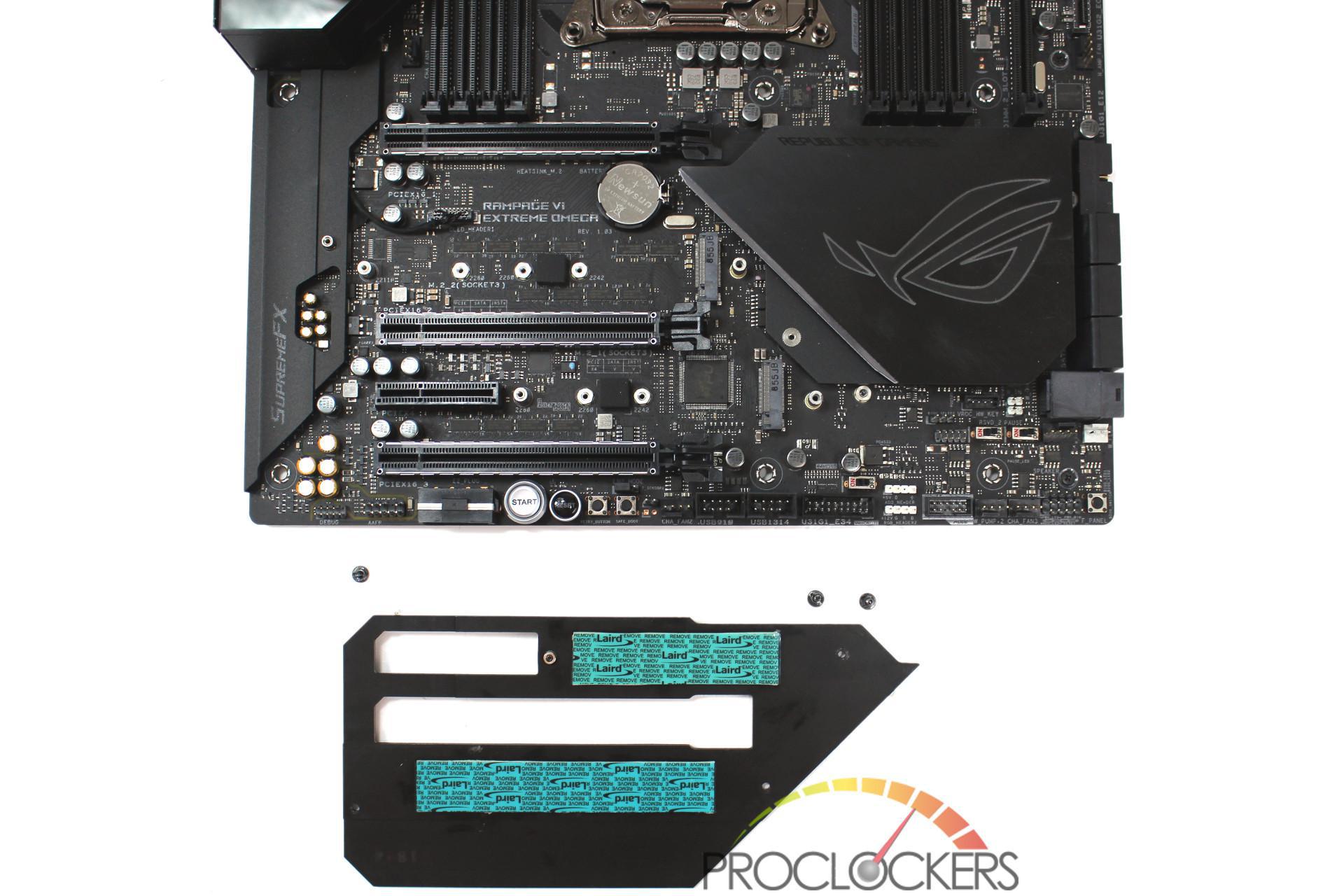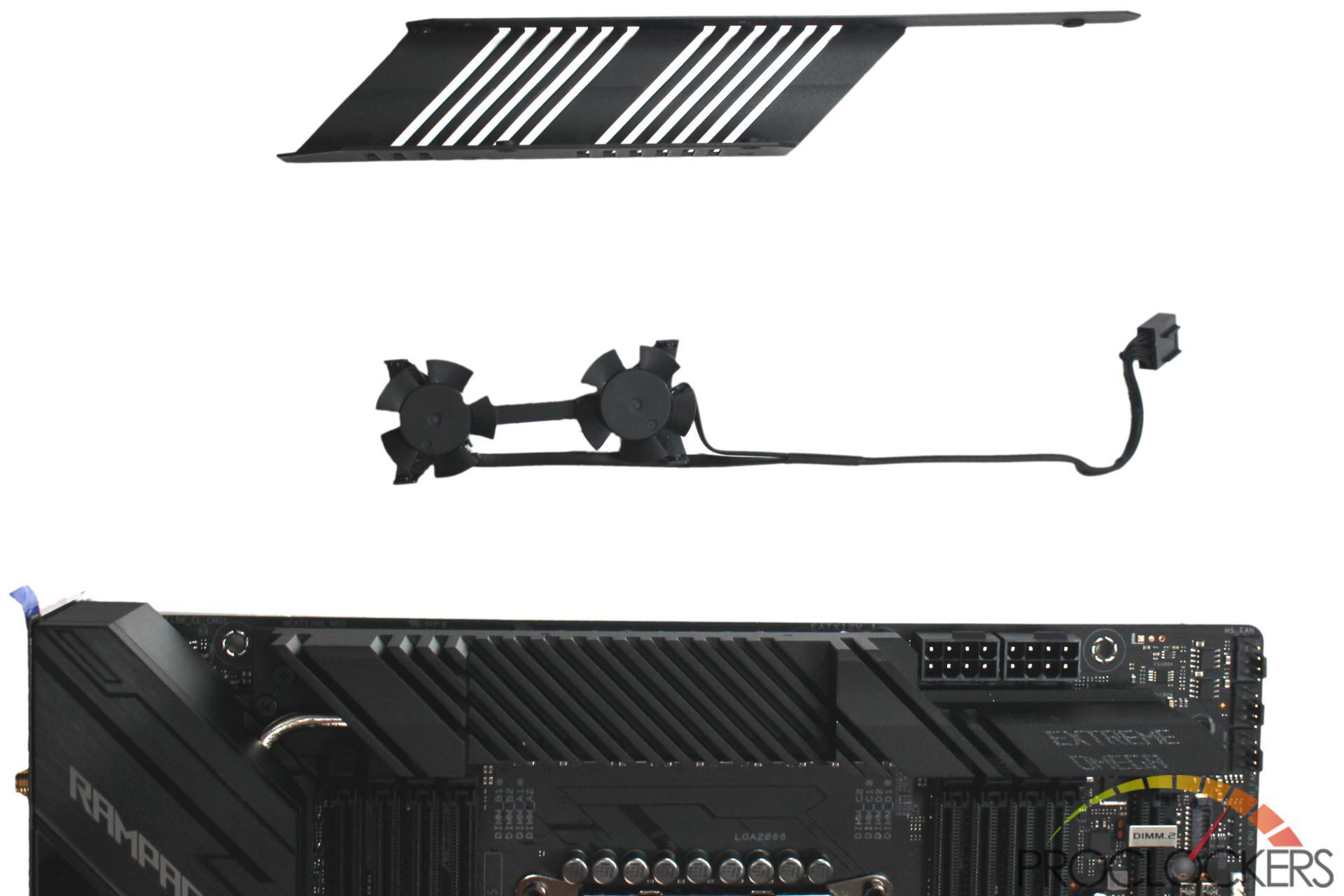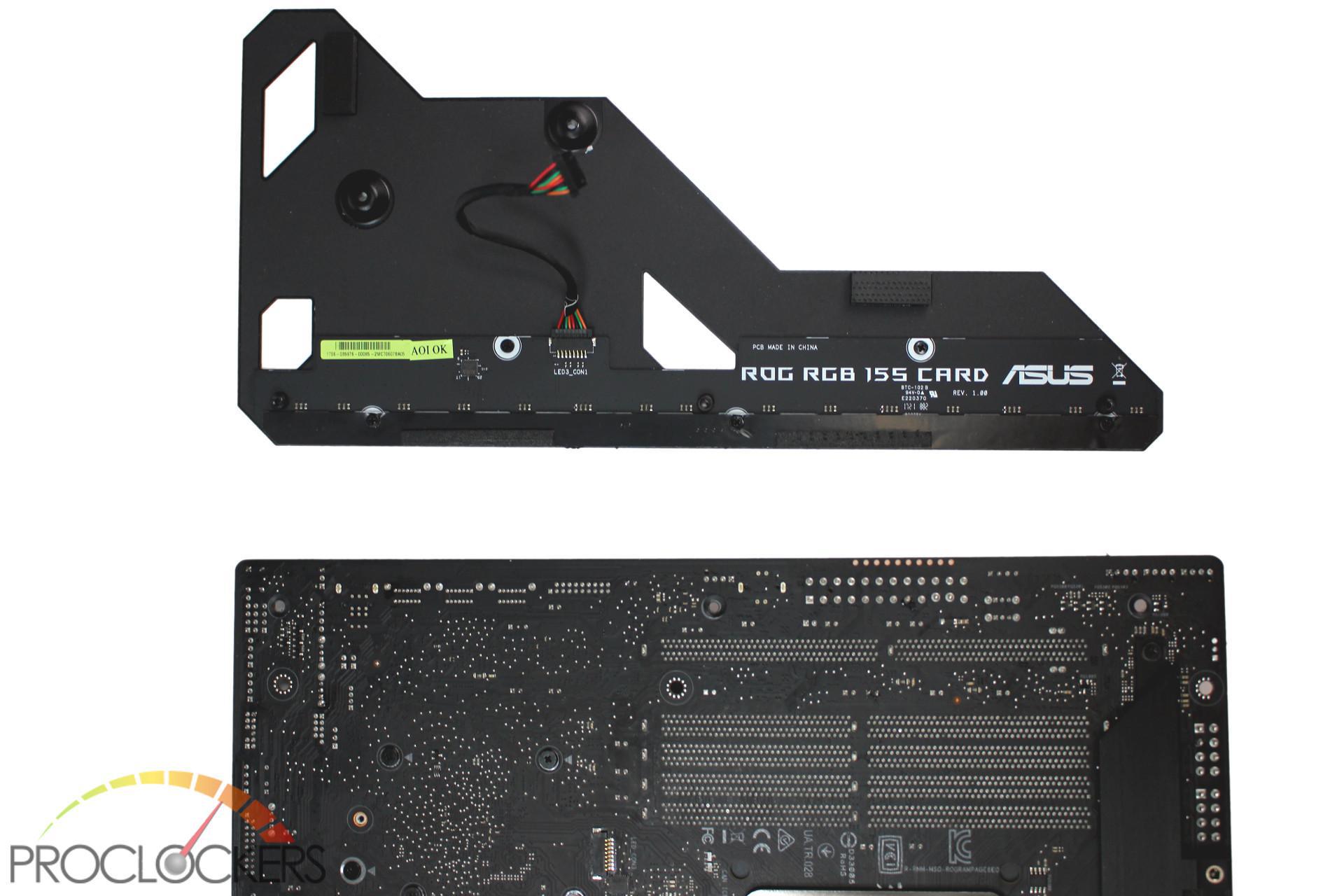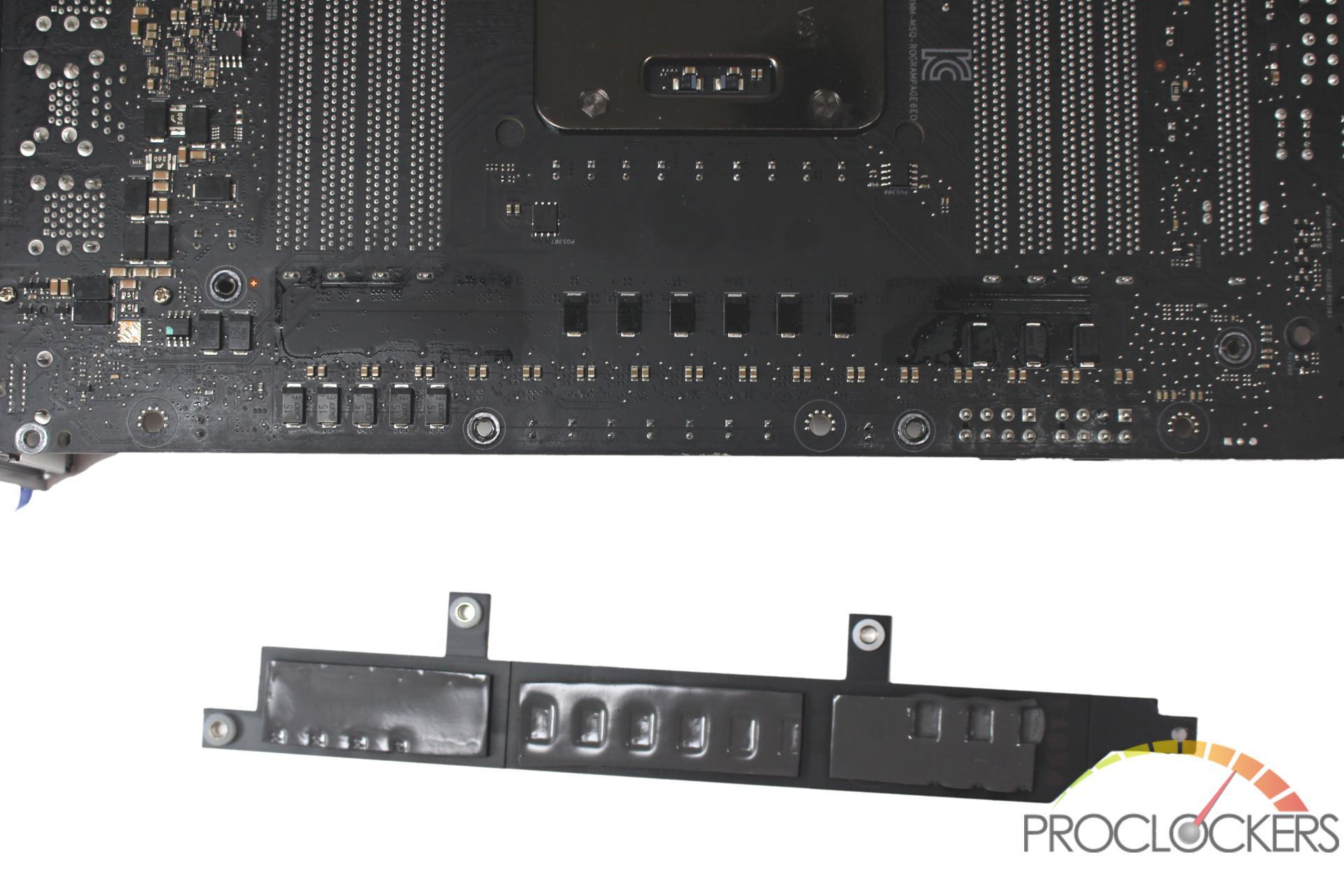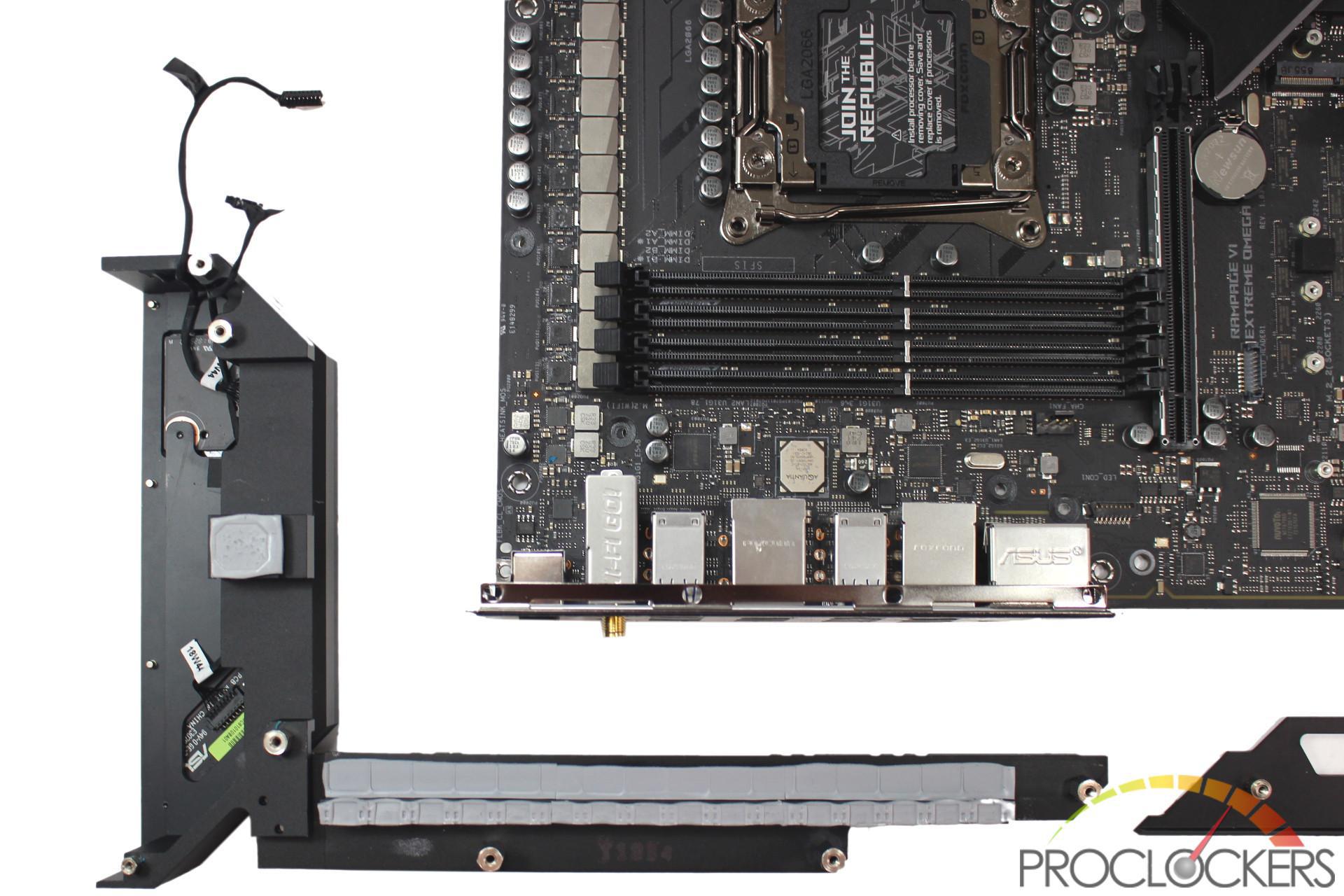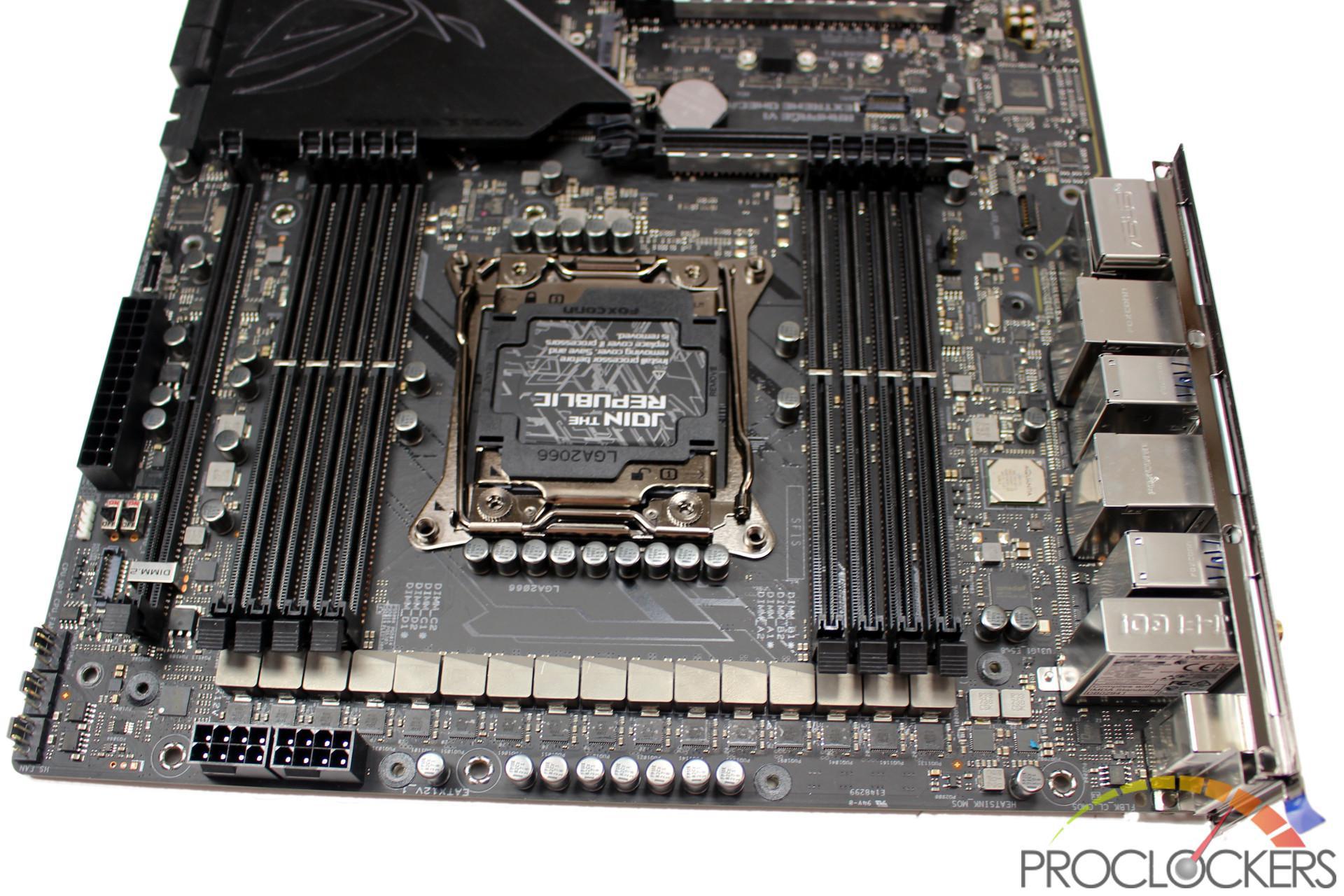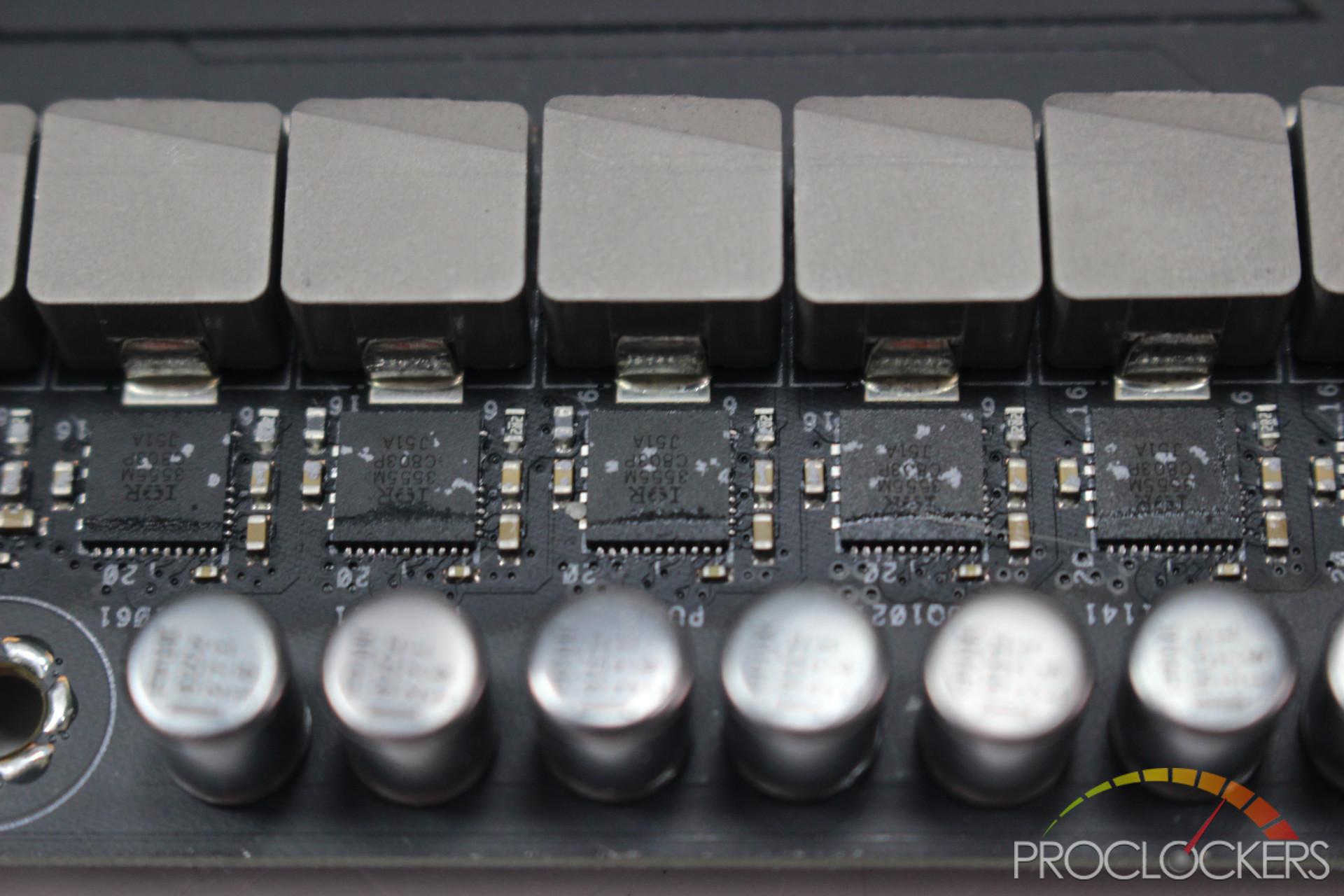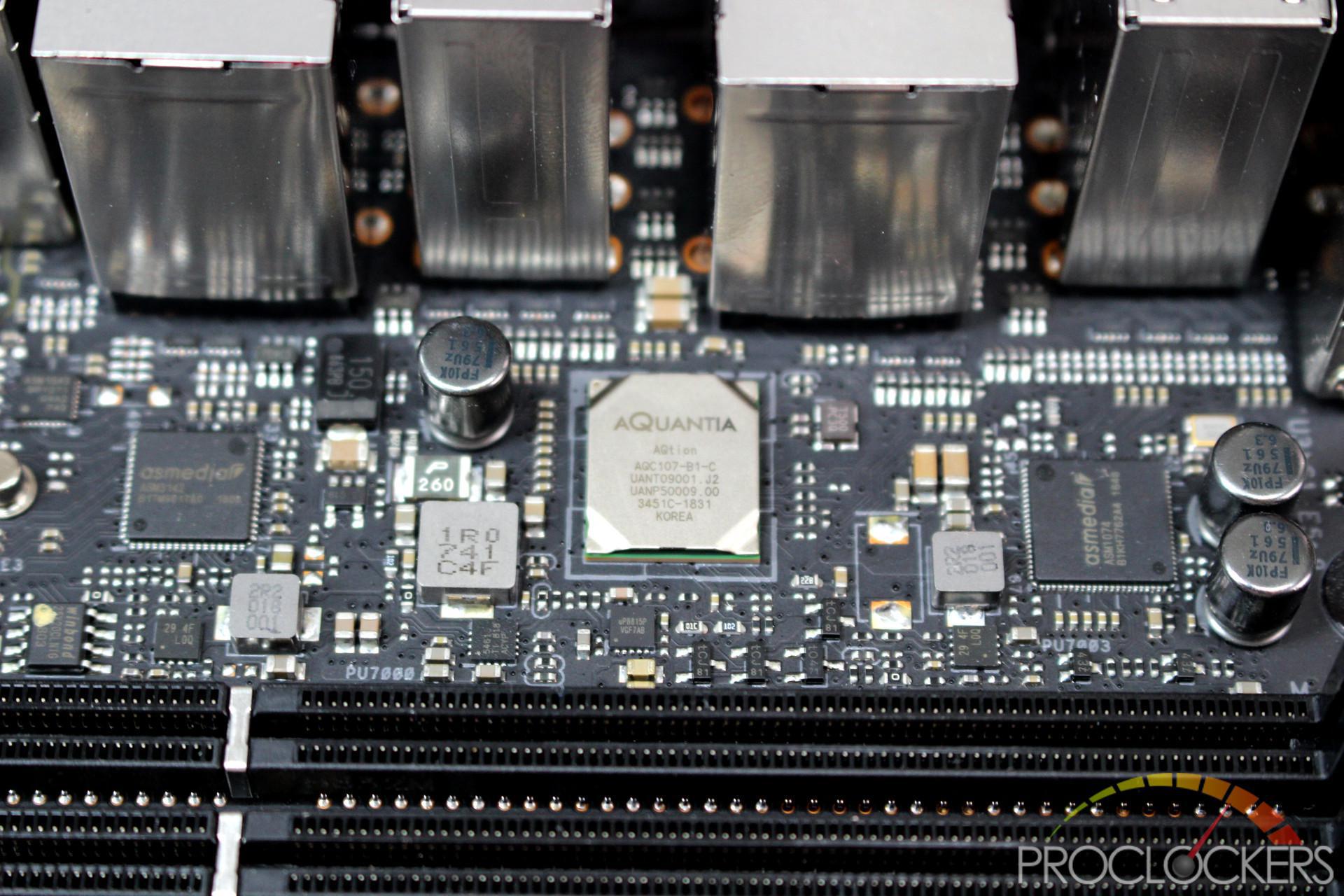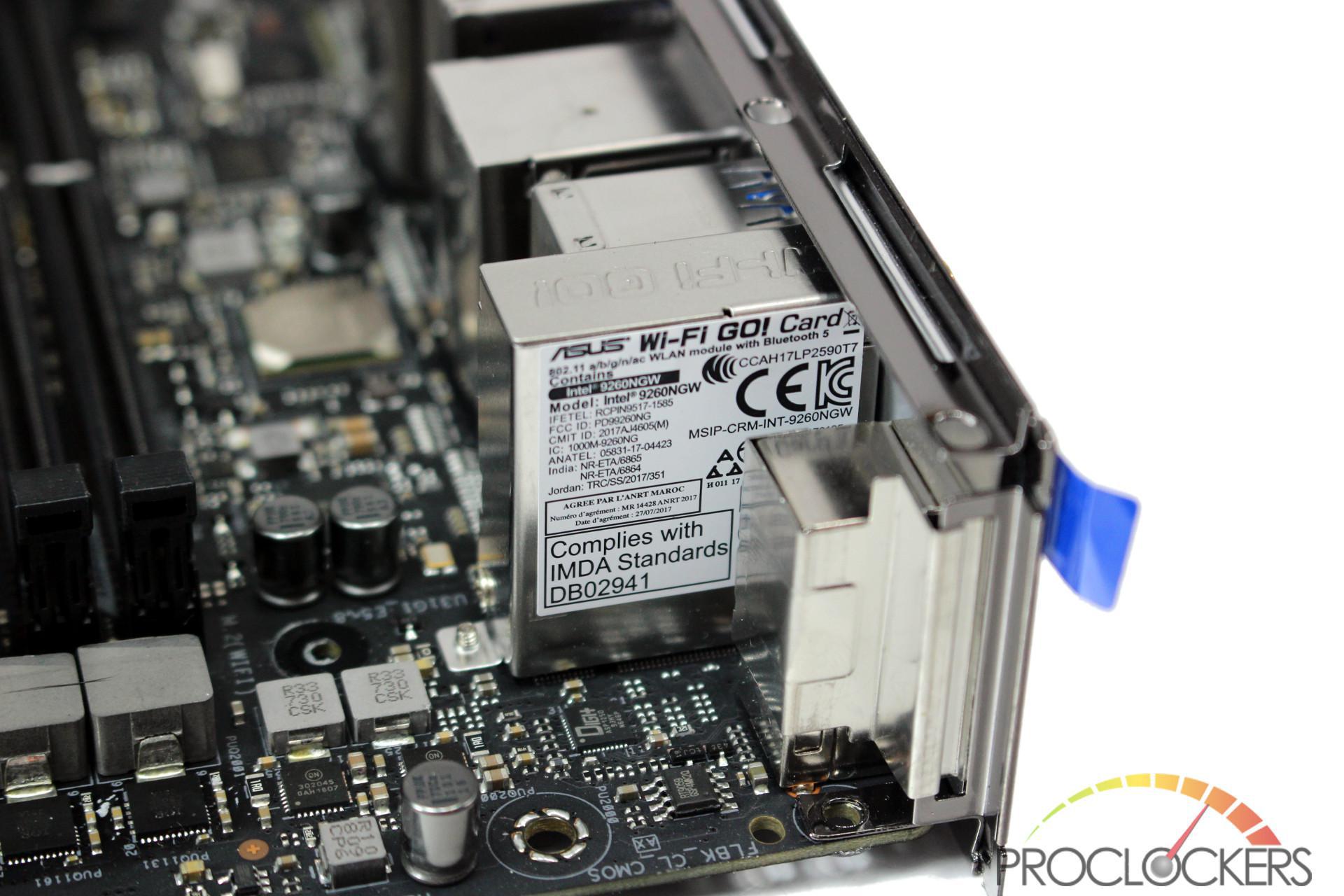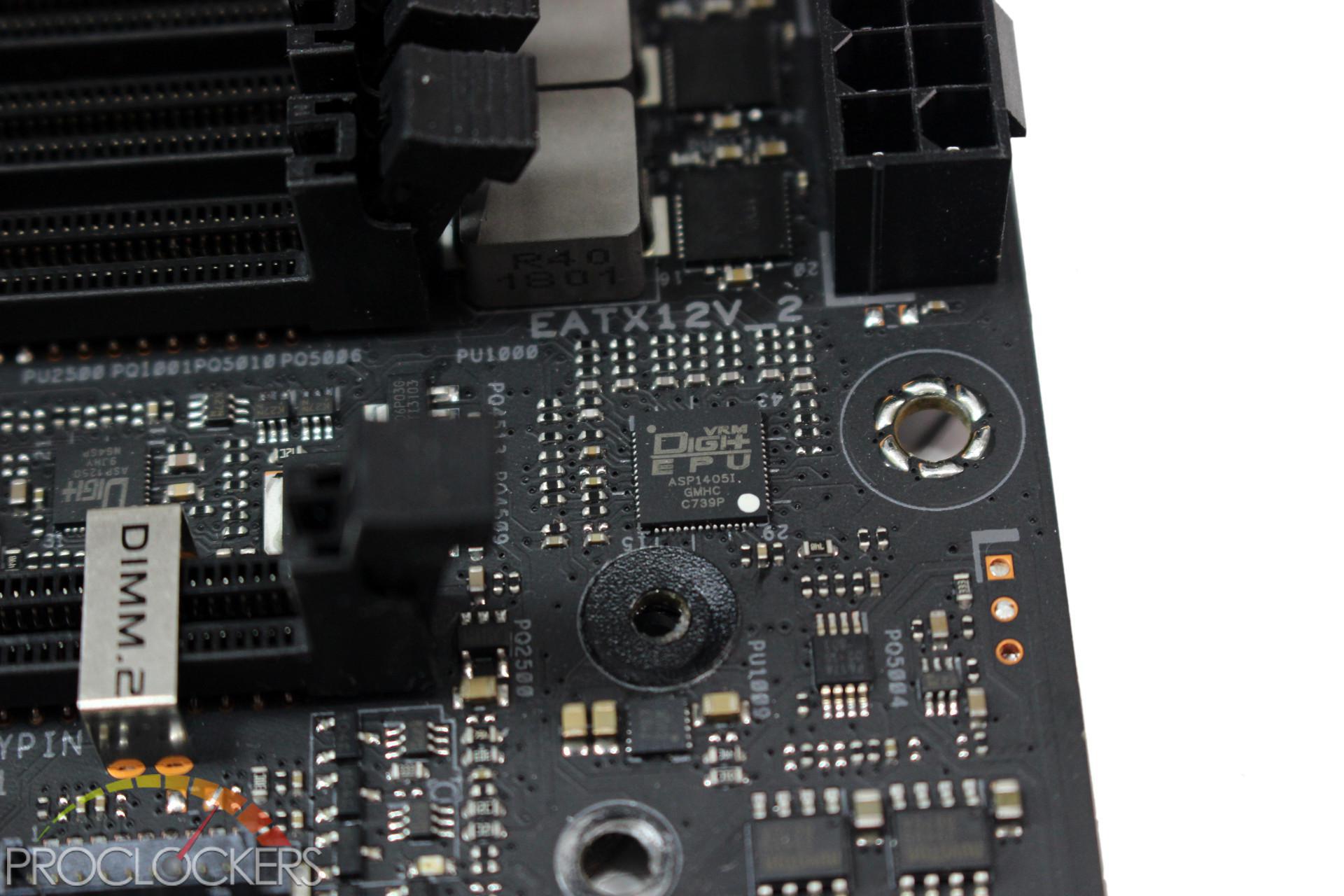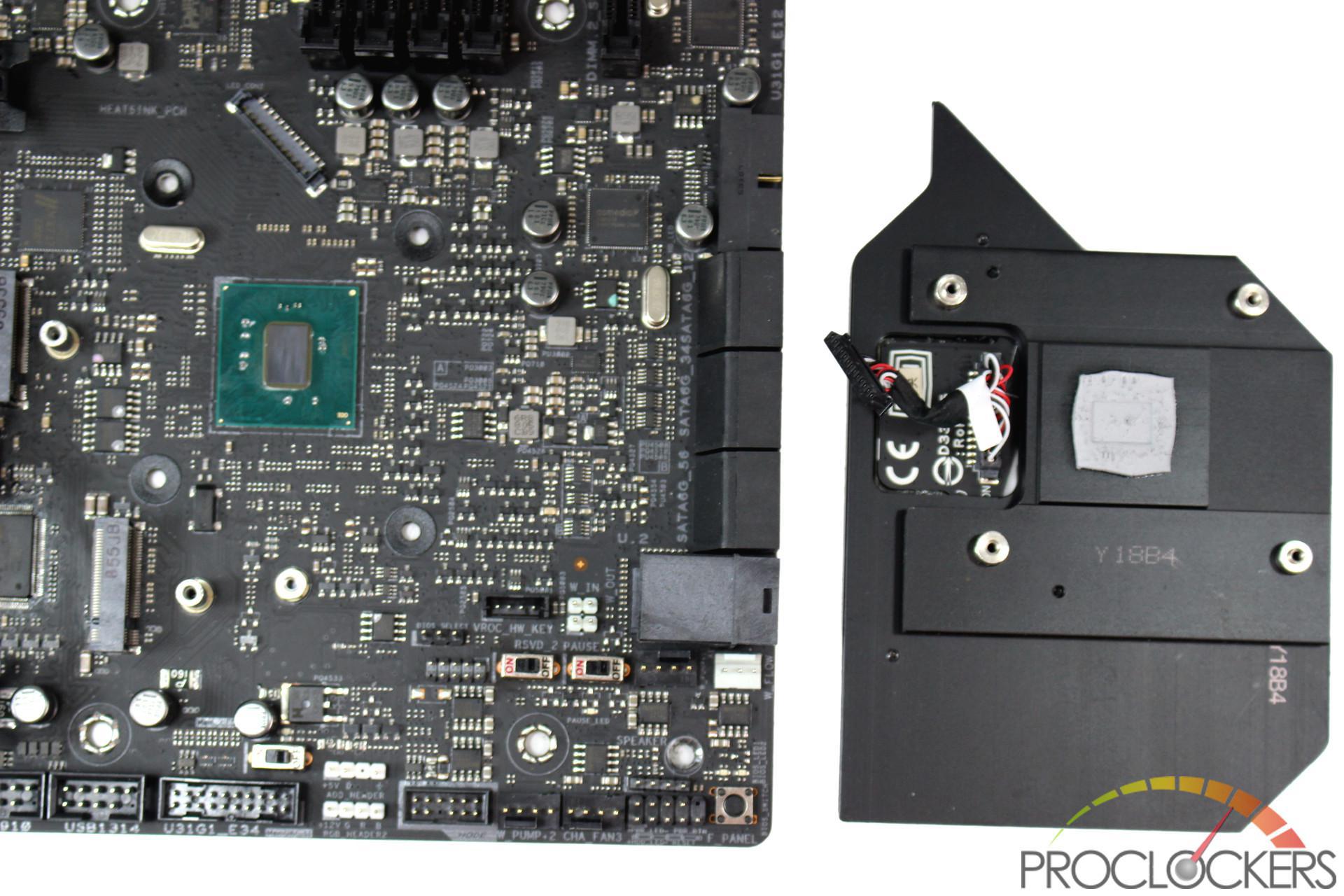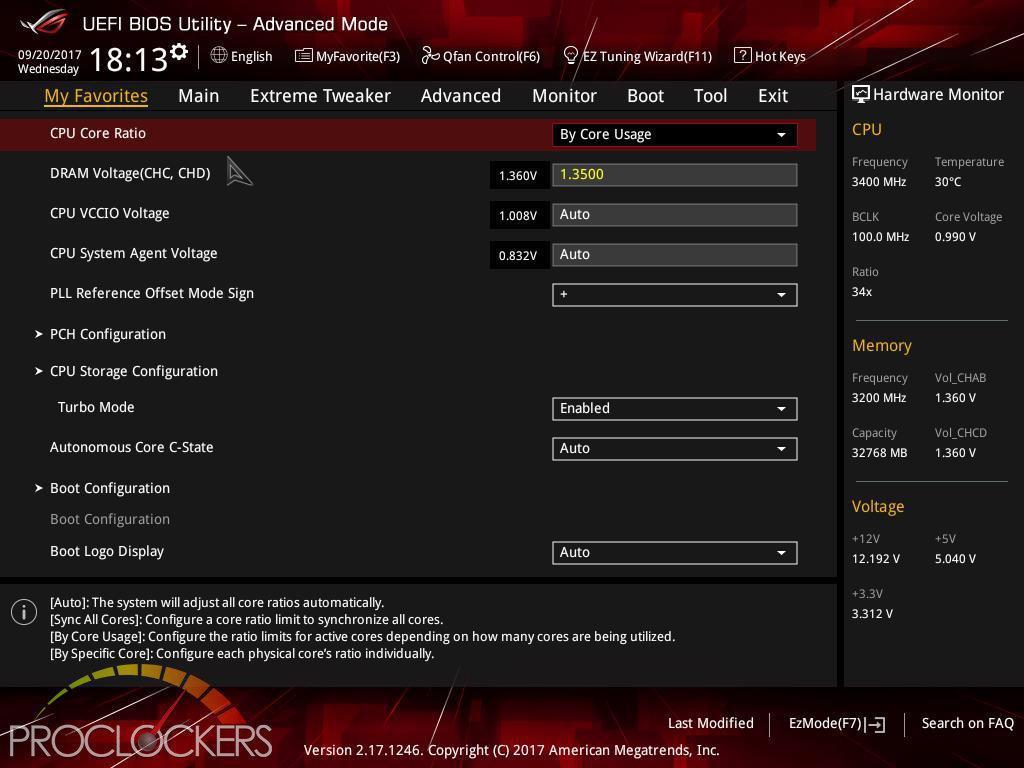Hardware
ASUS ROG Rampage VI EXTREME Omega X299 Motherboard Review
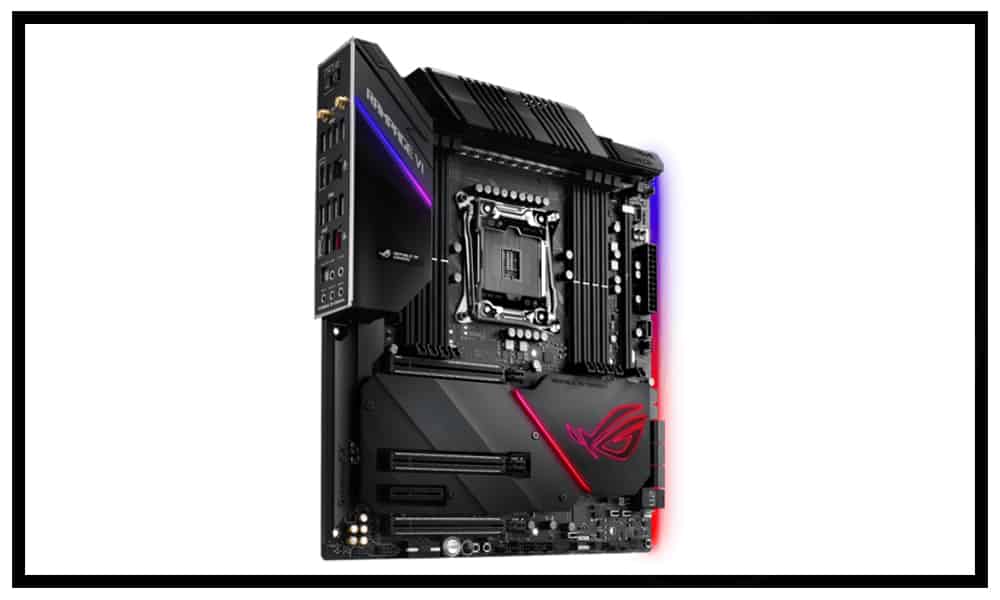
Introduction
Hot on the heels of Intel’s launch of the updated SkyLake-X 9000 series CPU’s and following in the footsteps of the well-loved Rampage VI Extreme, ASUS’s updated ROG Rampage VI Extreme Omega makes some welcome changes to get the most out of Intel’s high core count CPU’s. One of the biggest changes is a new 8-phase VRM with twin power stages that quietly lurks beneath a massive new VRM heatsink with active fan cooling under the hood to handle the extreme demands of overclocking flagship CPU’s. Favorites such as the LiveDash OLED display and 10 Gigabit Ethernet are joined by a new NODE connector, Fan Extension II system, DImm.2 with heatsinks and an updated Intel Wireless-AC 9260. Can the best be bested? Let’s find out!
ProClockers would like to thank ASUS for sending the Rampage VI EXTREME OMEGA to check out.
Asus’s Take on the Rampage VI EXTREME Omega:
Designed for those who play by their own rules, ROG Rampage VI Extreme Omega features a stealthy design packed with cutting-edge ROG technology and intelligent cooling. With 16 strategically paired IR3555 PowIRstages, a VRM heatsink assembly topped with dual fans, 4 M.2 slots with heatsinks and an onboard 10Gbps Ethernet, the Omega gives the most discerning gamers, enthusiasts and overclockers everything they need to push the limits.
Intel X299 EATX gaming motherboard LGA 2066 for Intel Core X-Series processors, with ROG DIMM.2, DDR4 4266MHz, onboard 802.11ac Wi-Fi, 10Gbps LAN, USB 3.1 Gen 2, SATA, Quad M.2, and Aura Sync RGB lighting
- Intel LGA 2066 socket: Ready for the latest Intel® Core™ X-Series processors to maximize connectivity and speed with up to four M.2 drives, USB 3.1 Gen 2, Intel® VROC and Intel® Optane™ memory compatibility.
- Comprehensive thermal design: Active heatsink with integrated VRM fan, PCIe-zone M.2 aluminum heatsink, and dual backplates.
- High-performance networking: Onboard Aquantia® 10Gbps LAN, 802.11ac Wi-Fi with MU-MIMO support, and Intel Gigabit LAN with ASUS LANGuard and GameFirst V technologies.
- 5-Way Optimization: Automated system-wide tuning, providing overclocking and cooling profiles that are tailor-made for your rig.
- SafeSlot technology: Firmly-anchored PCIe slots fortified with metal to support heavyweight graphics cards.
- Unmatched personalization: LiveDash OLED and ASUS-exclusive Aura Sync RGB lighting, including two additional RGB headers and one addressable header.
- Industry-leading ROG audio: SupremeFX S1220 and ESS® SABRE9018Q2C for enthusiast-grade audio performance driven by Japanese capacitors.

Features & Specifications
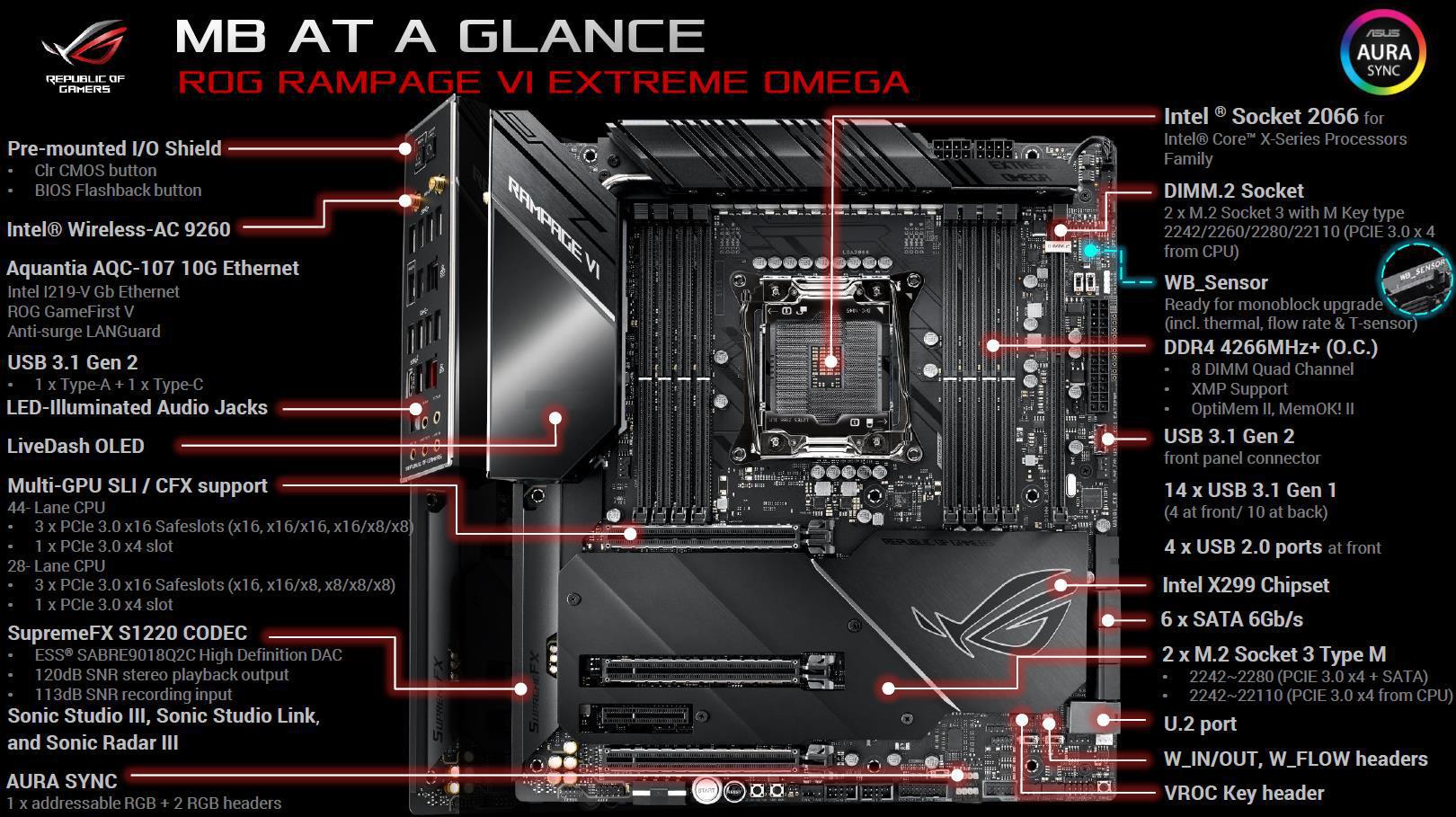
PERFORMANCE
We’ve rethought and refined every aspect of Rampage VI Extreme Omega to provide the solid foundation needed to create an extreme gaming system that delivers the highest performance.

DDR4 4266MHZ+
HCC processors crunching multi-threaded compute workloads can demand colossal memory space and bandwidth. The Omega features choice Optimem II enhancements to maximize signal integrity and drive high-density memory configurations to speeds previously reserved for low-capacity setups.

POWER DESIGN THAT BUCKS TRENDS
The monstrous compute power of high core count (HCC) processors necessitates a power circuit that rapidly responds to massive current swings. And those demands increase exponentially when the CPU is overclocked. Featuring an array of 16 strategically paired power stages, the Omega’s VRM is geared for any workload and all operating conditions.

POWER ARCHITECTURE
Overclocked multi-core processors place incredible loads on the VRM when transitioning between load states. However, conventional motherboard design practices place primary focus on component specs without implementing circuit topologies that provide optimal transient response. The Omega bucks industry trends by utilizing teamed PowIRstages to double the burst current of each phase and rapidly respond to load changes.
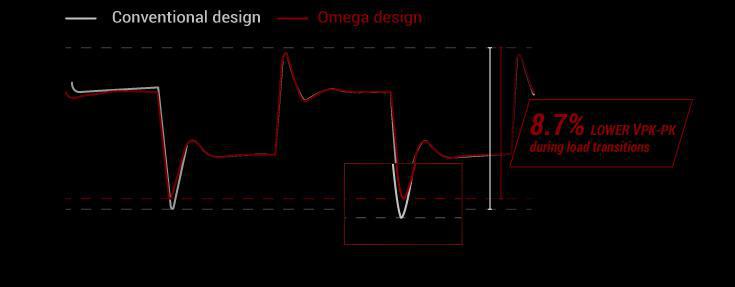
The Omega’s VRM reacts quickly to load changes and suffers from less overshoot and undershoot than alternative power solutions, allowing the processor to remain stable at lower average core voltages.
COOLING
Effective cooling is extremely important for up to 18-core processing beasts, even at stock speeds. That’s why ROG Rampage VI Extreme Omega is fully armed to provide the best foundation for extreme PC systems, enabling higher performance at lower temperatures.
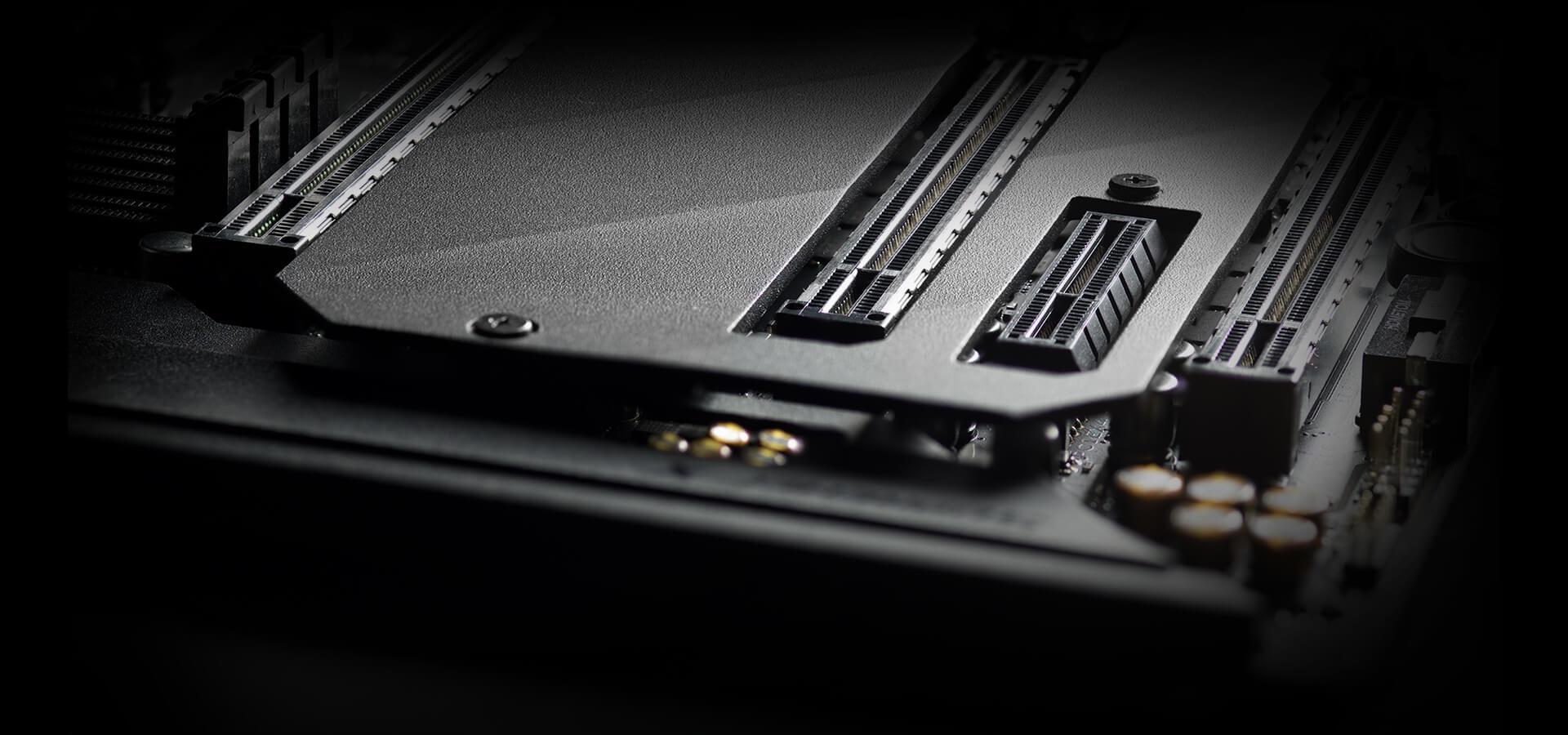
COOLING HEATSINKS
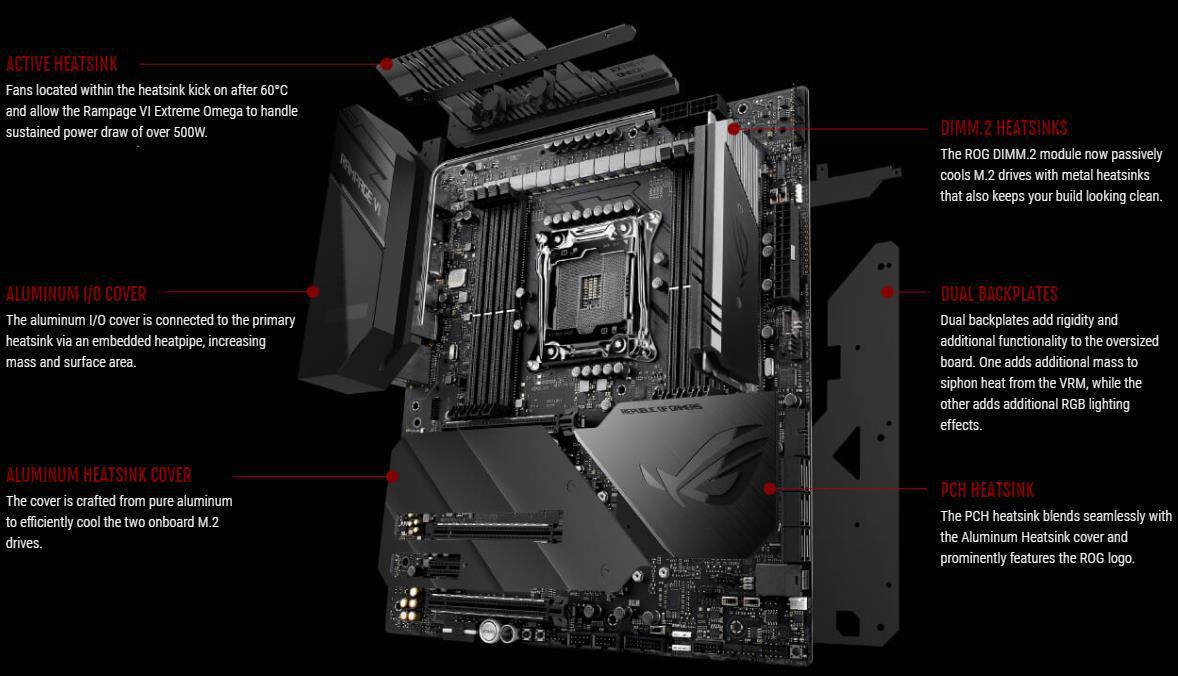
COOLER BY DESIGN
Rampage VI Extreme Omega features the most comprehensive cooling options ever, configurable via Fan Xpert 4 or the UEFI BIOS.

ROG WATER-COOLING ZONE
ROG Water-Cooling Zone’s dual water-temperature headers and flow-rate header feed information straight into the AI Suite utility, so you can keep track of coolant temperatures, and the flow rate of the entire loop.

AN EXTENSION CARD II
ROG Rampage VI Extreme Omega includes our new Fan Extension Card II, which adds six headers that are controllable via FanXpert 4. The card has three temperature-sensor headers to complement the one available onboard and, more importantly, it comes with three thermistors that you can affix to different components. In addition to supplying extra headers for cooling, it has three primed for RGB LED strips.
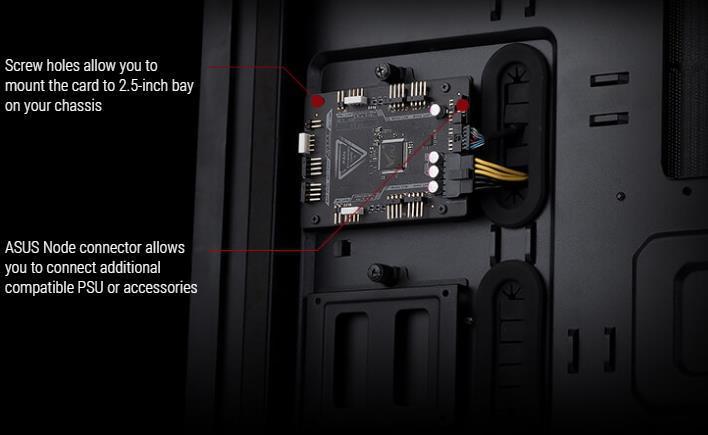
OPTIMIZATION
Rampage VI Extreme Omega is packed with intuitive and flexible tools that let you customize every aspect of your system to deliver the performance and features you want. Take advantage of 5-Way Optimization for intelligent, automatic overclocking or enjoy full manual control via comprehensive UEFI BIOS settings.
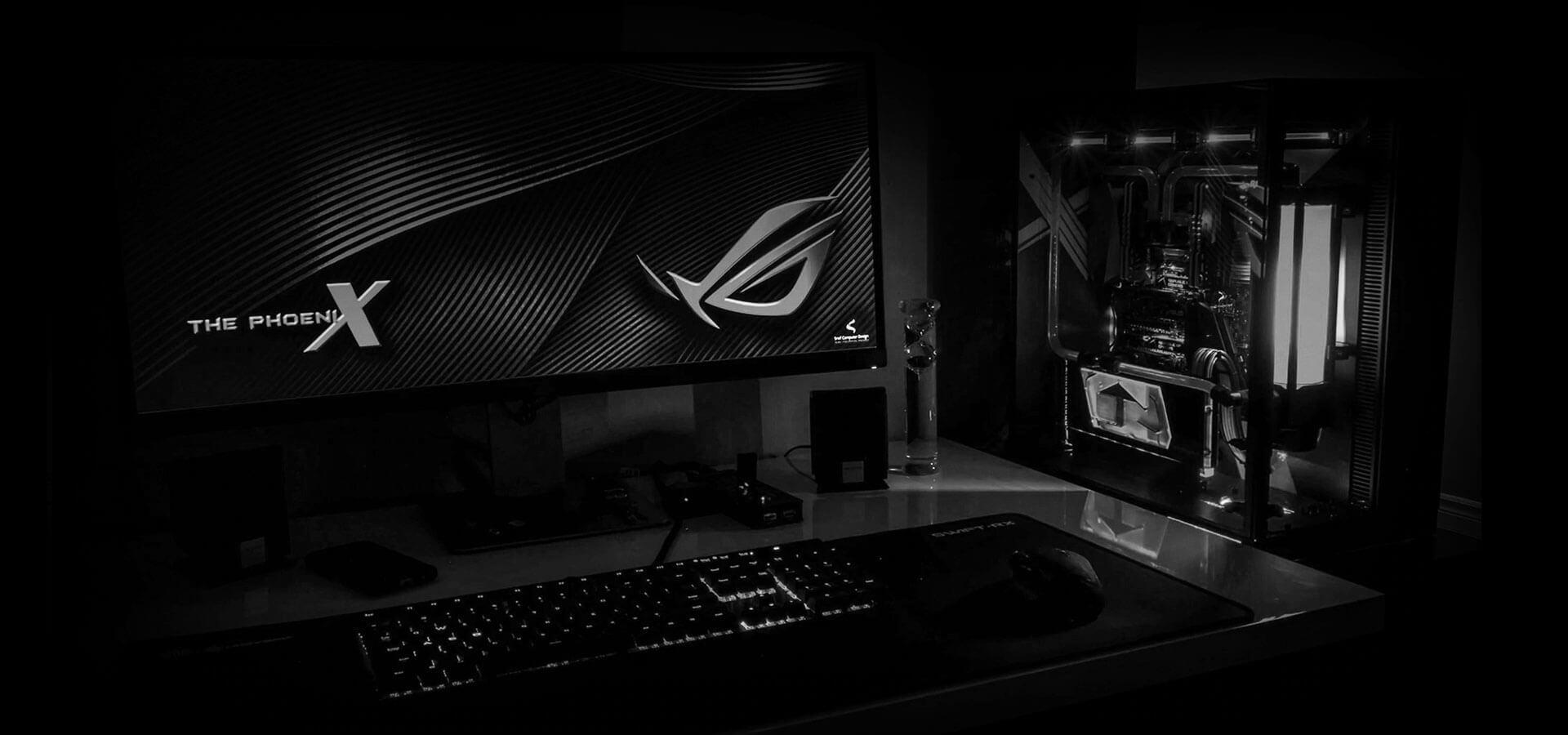
CONNECTIVITY
Every aspect of Omega is designed to enhance your gaming and creative experience. The Intel 10Gbps Ethernet controller opens the door to massive files transfers and ultralow latency, while four M.2 slots offer fast load times and flexible storage expansion. Finally, integrated SupremeFX audio enhances recording quality to ensure superb clarity for streaming, gaming chat and more.
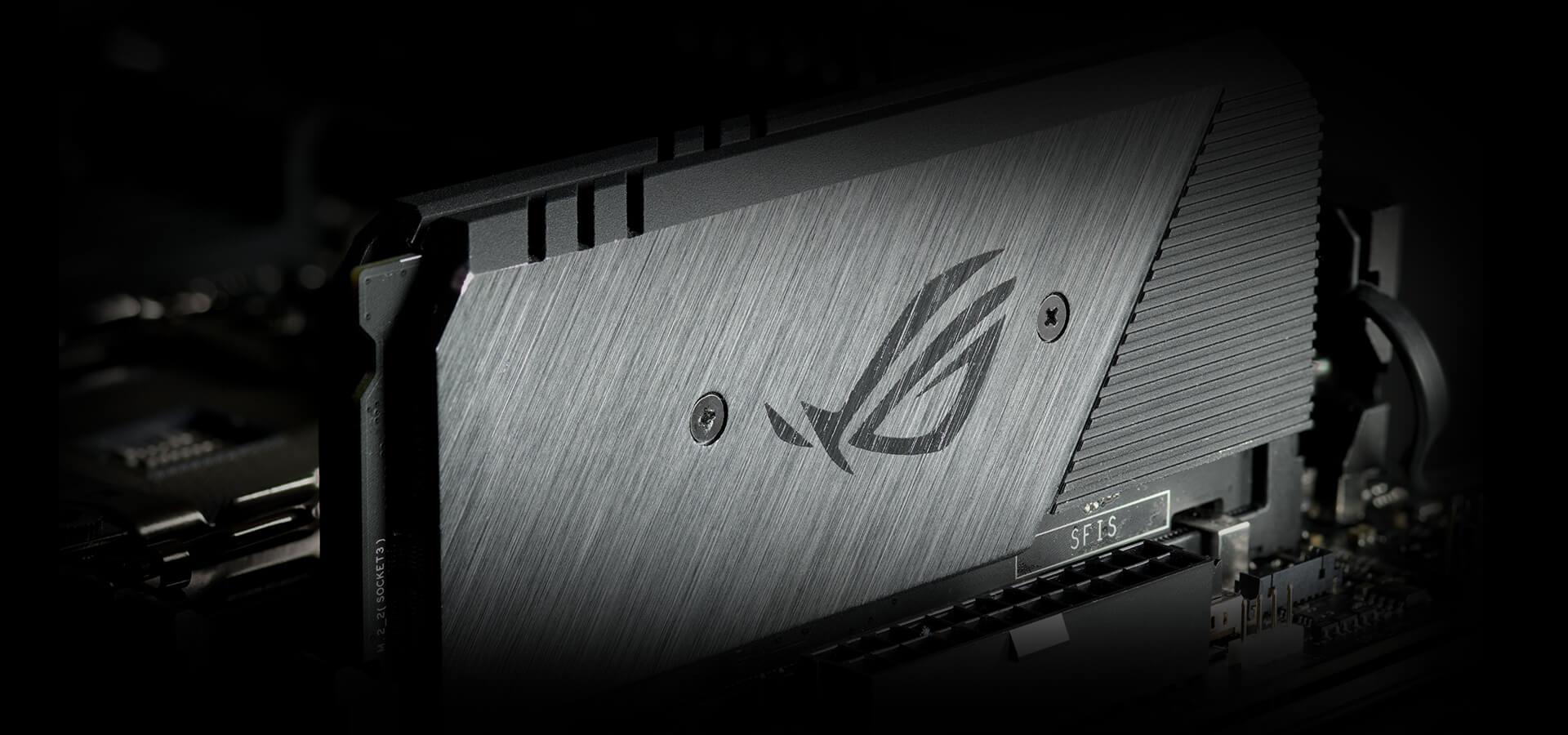
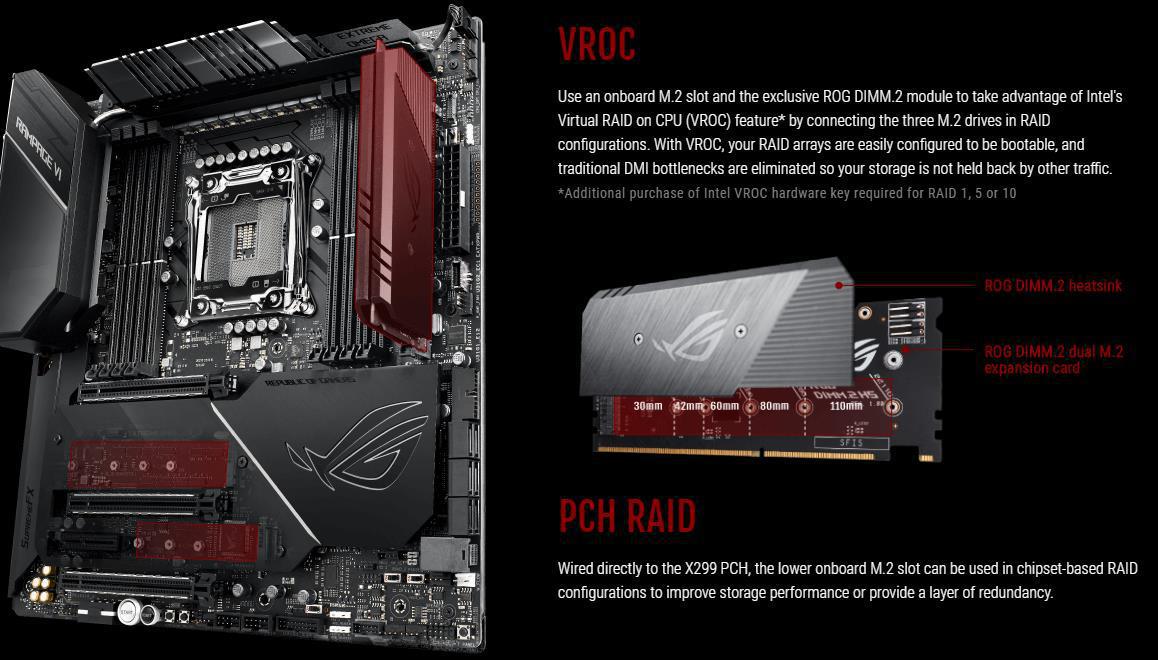
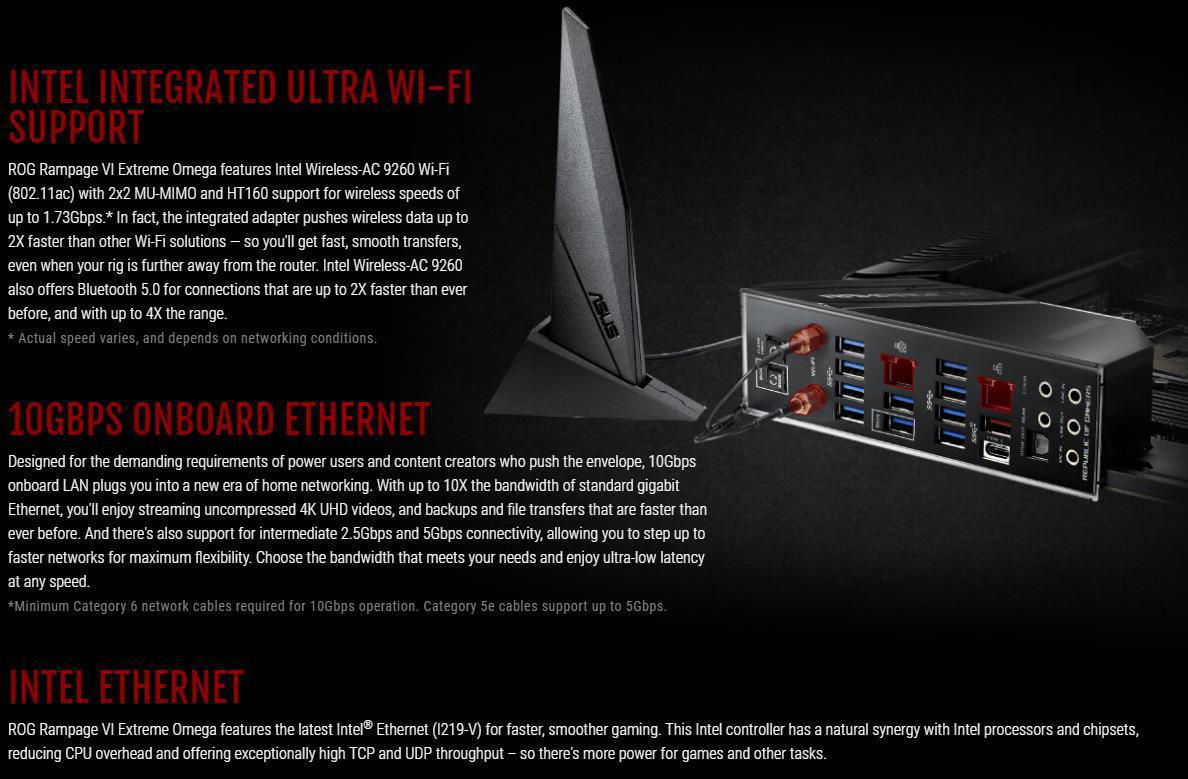
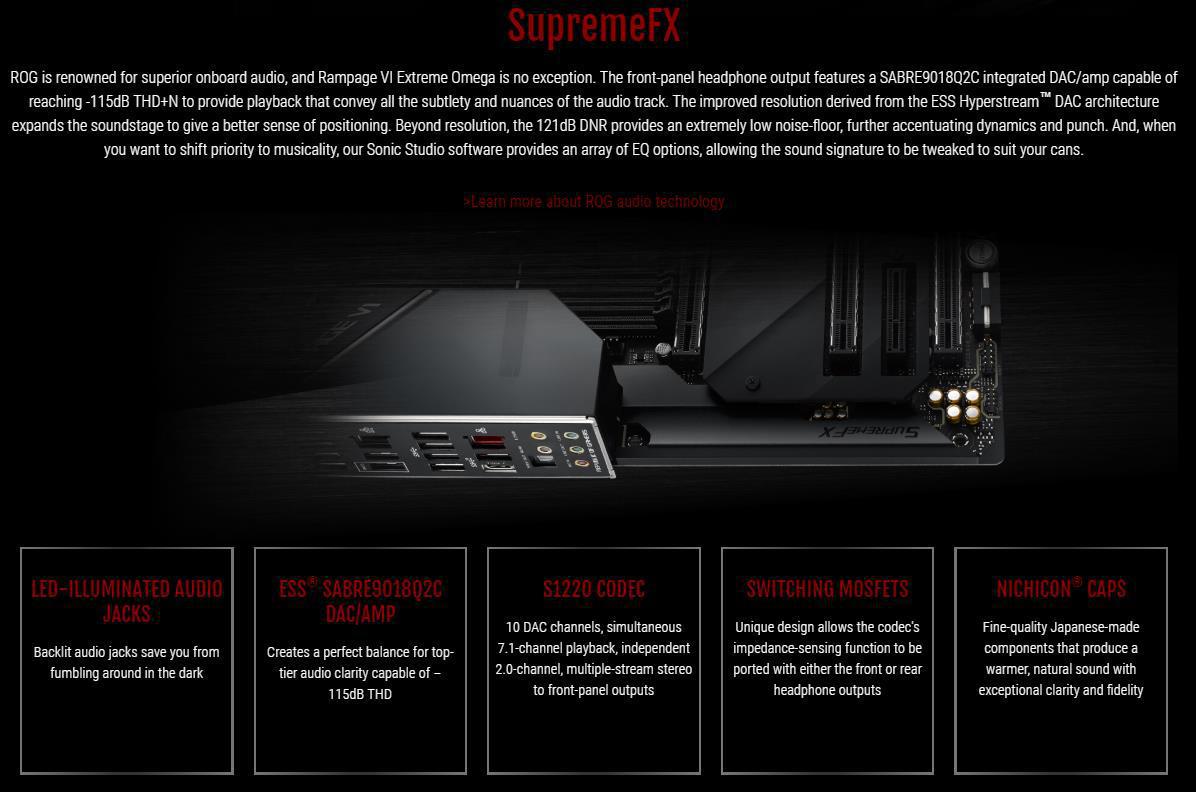
PERSONALIZED FOR YOU
In addition to extraordinary performance, Rampage VI Extreme Omega provides extensive styling and customization options to let you build a system that truly stands apart.
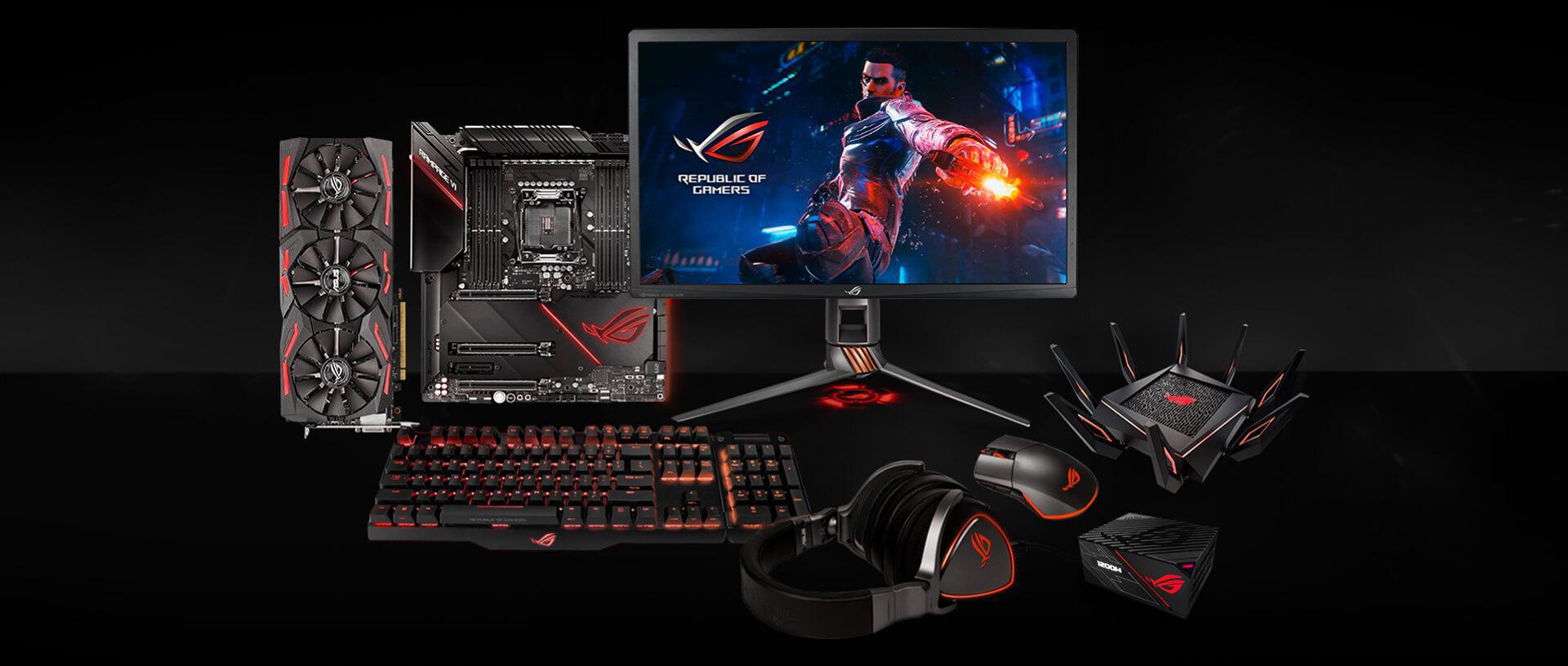
AURA SYNC
GROW YOUR GAMING WORLD
Gear up with ROG components, from graphics and monitors to mice and keyboards, and up your game with complementary aesthetics, control, and compatibility. The ROG ecosystem is more extensive than any competing brand, so enjoy greater choice as your system expands.
GAMEFIRST V
ROG FIRST
Interface directly with a ROG router and automatically configure QoS to prioritize network bandwidth to games.
RAMCACHE III
SMART MODE
Automatically caches all your storage devices to maximize your system’s resources
SONIC STUDIO III
SONIC STUDIO LINK
The new Sonic Studio Link now allows you to apply Sonic Studio effects on all playback devices. Simply press the Sonic Studio Link button to enjoy the effect on any playback devices.
LIVEDASH
HARDWARE MONITORING
During the power-on, self-test (POST) phase, LiveDash shows key progress stats, in simple language and via traditional POST codes. Then, during normal operation, the vibrant panel shows a choice of CPU frequency, device temperatures, fan speeds or information from the Water Cooling Zone.
ARMOURY CRATE
The brand-new Armoury Crate portal keeps you updated with the latest drivers and BIOS releases. Its easy-to-use UI can be configured to show a variety of information, including security updates, bug patches, the latest ROG news, gaming events, and special offers.
SPECIFICATIONS
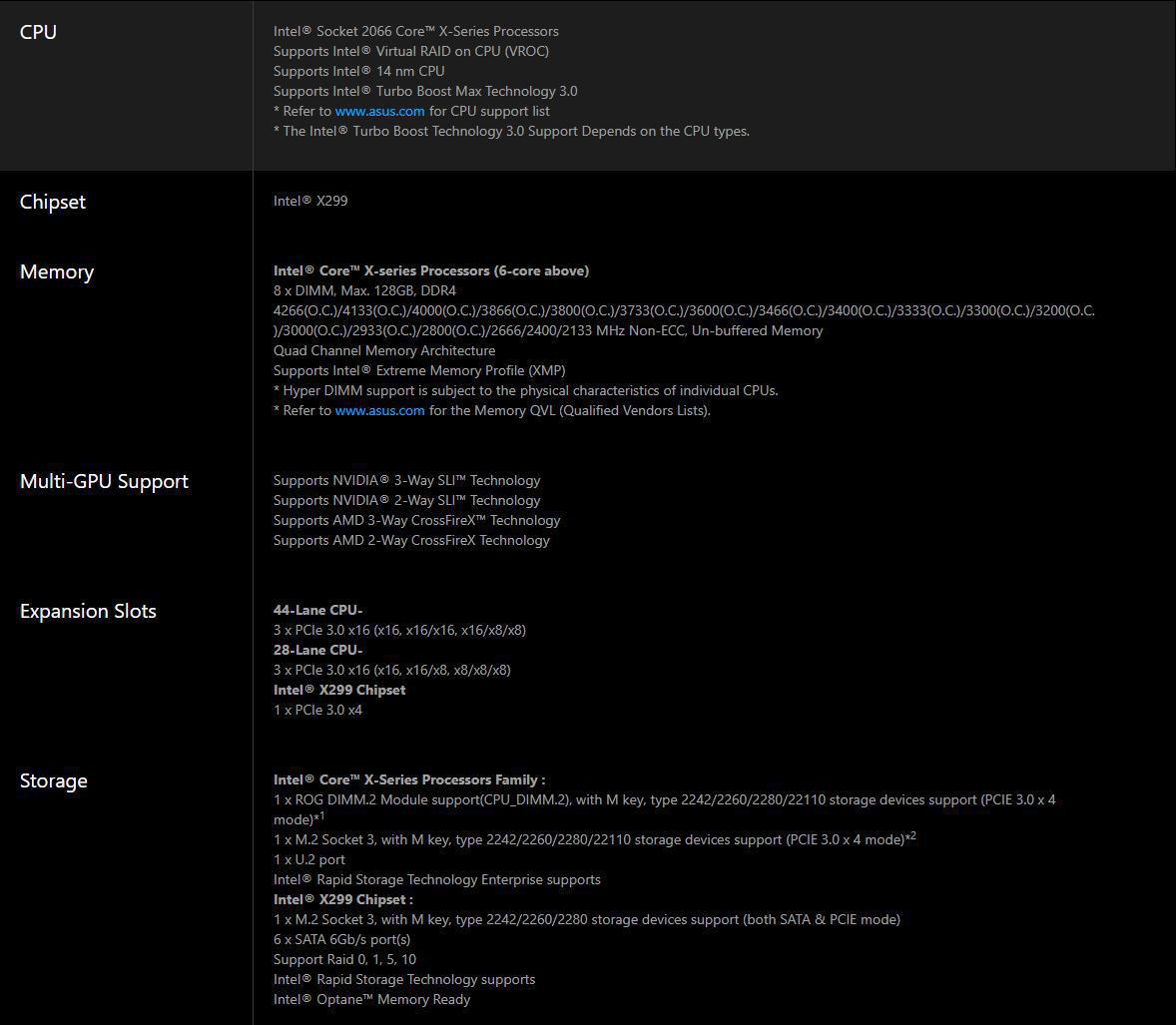
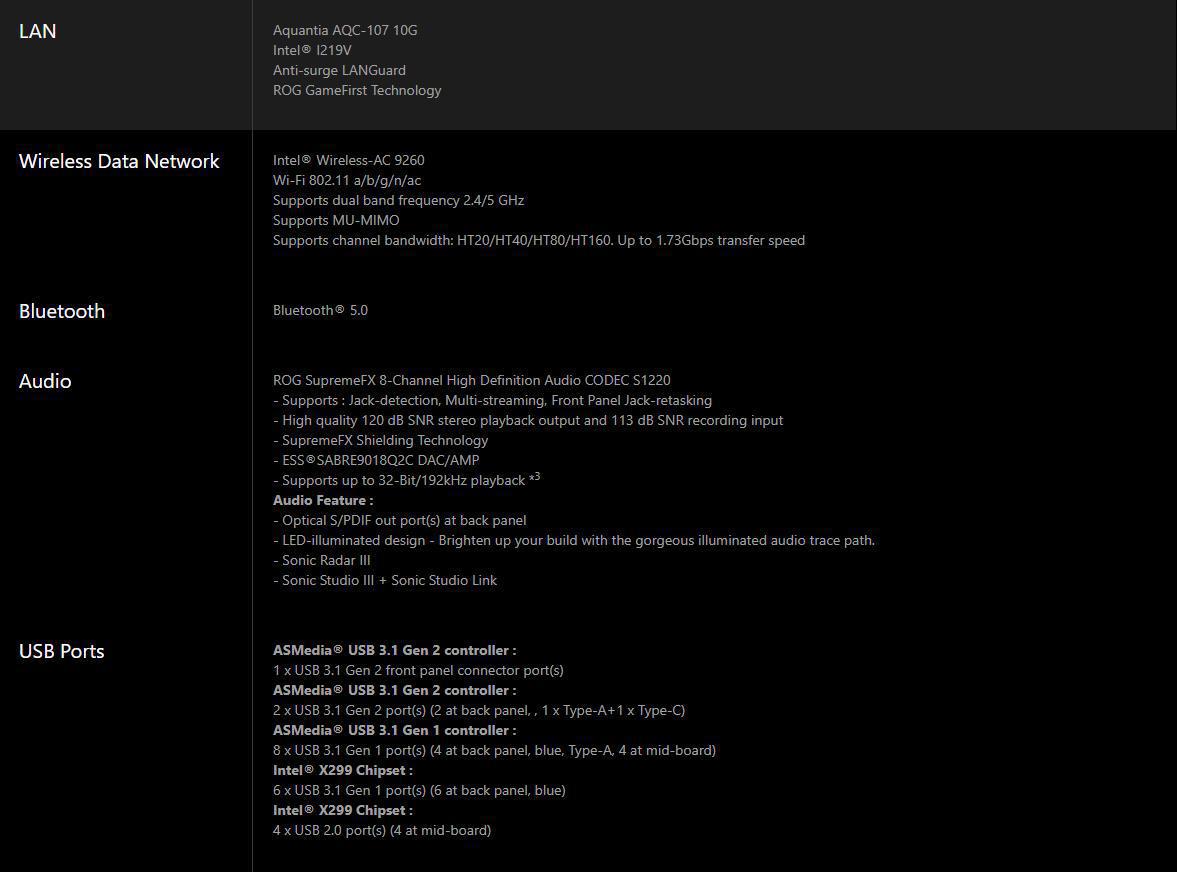
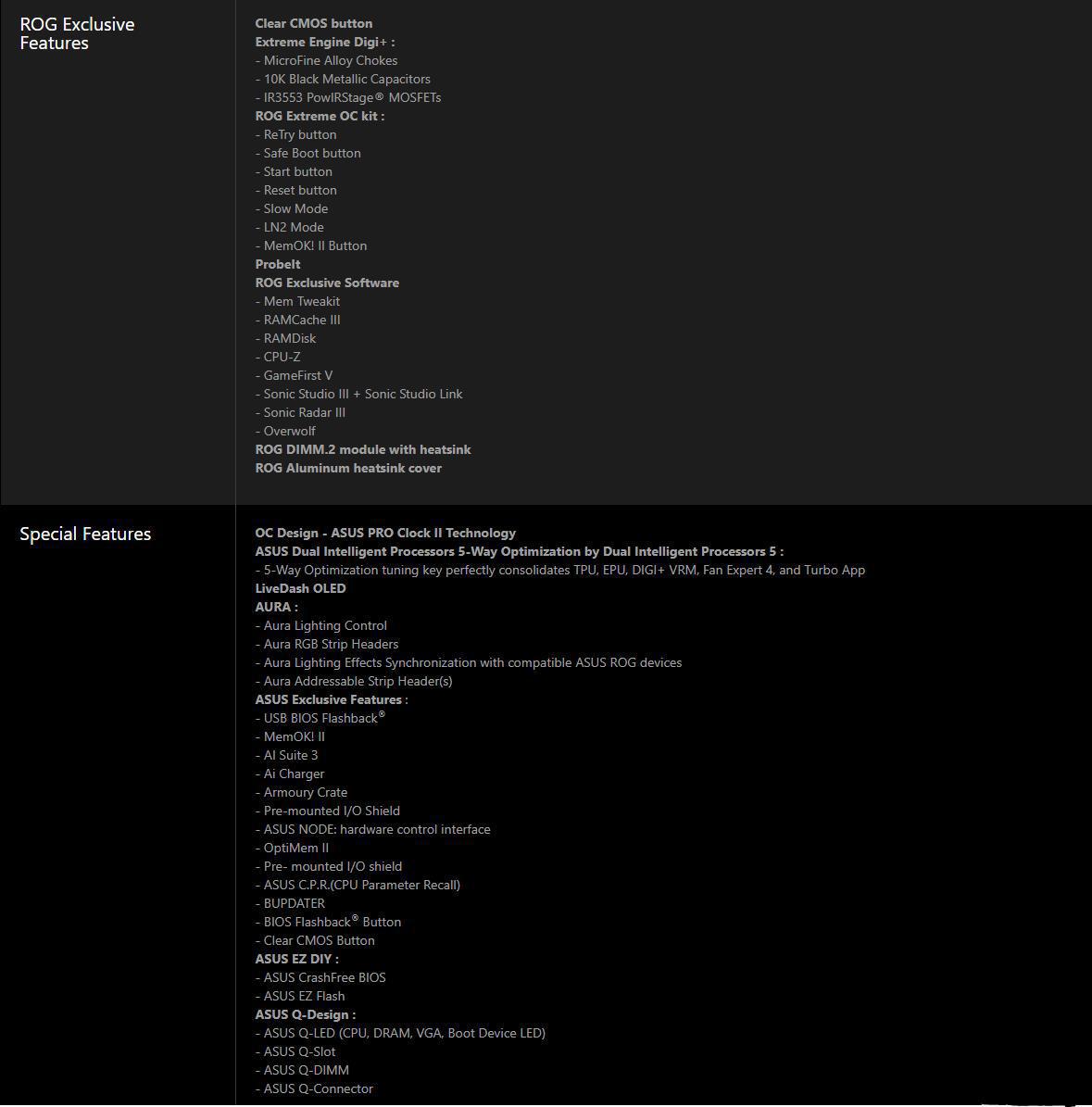
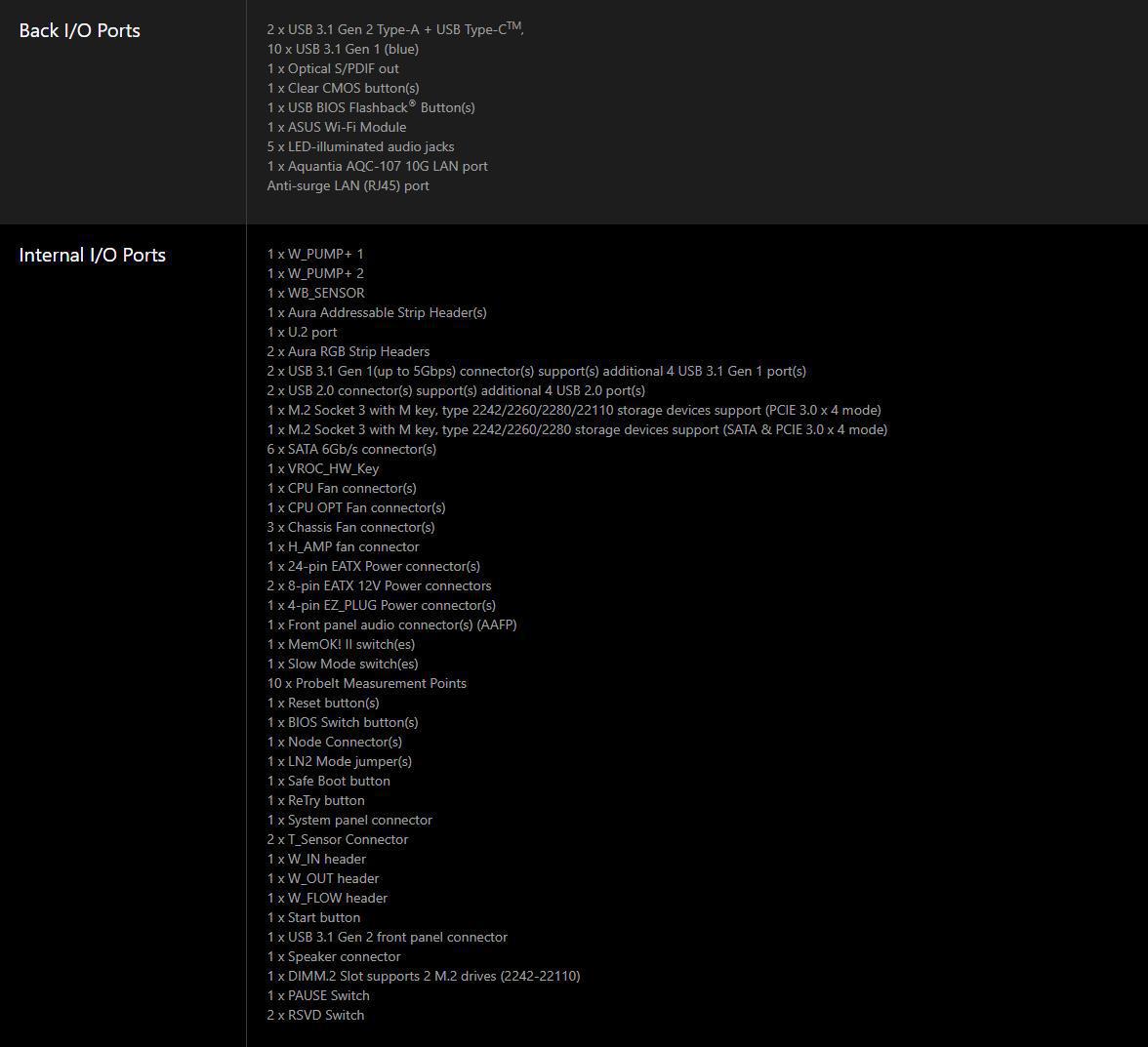
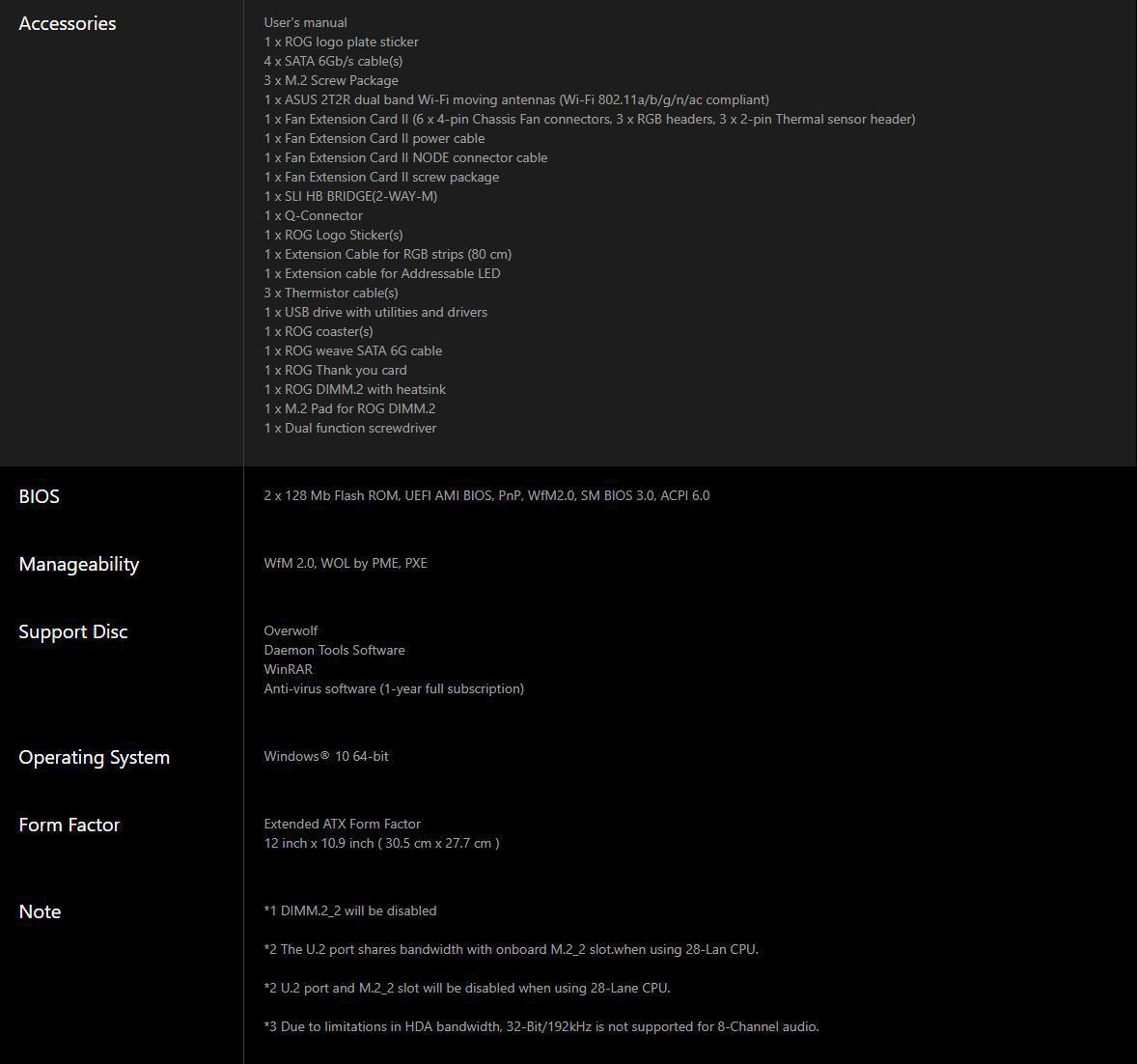
Packaging & Unboxing
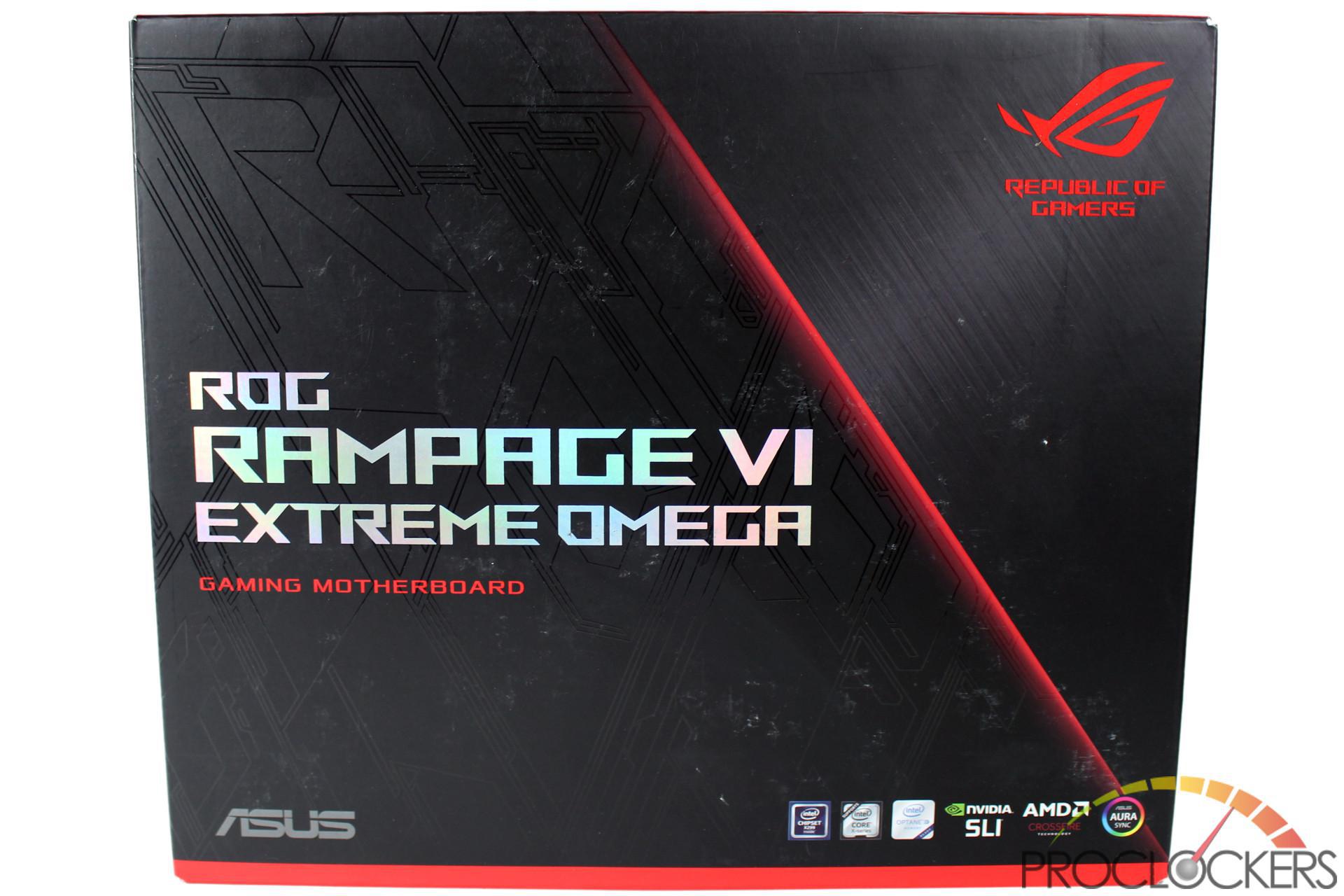
ASUS’s ROG Rampage VI Extreme Omega comes in a black box with a brushed metal finish. The ROG logo sits in the corner and the model of the board covers a large swath of the box in metallic color changing letters.
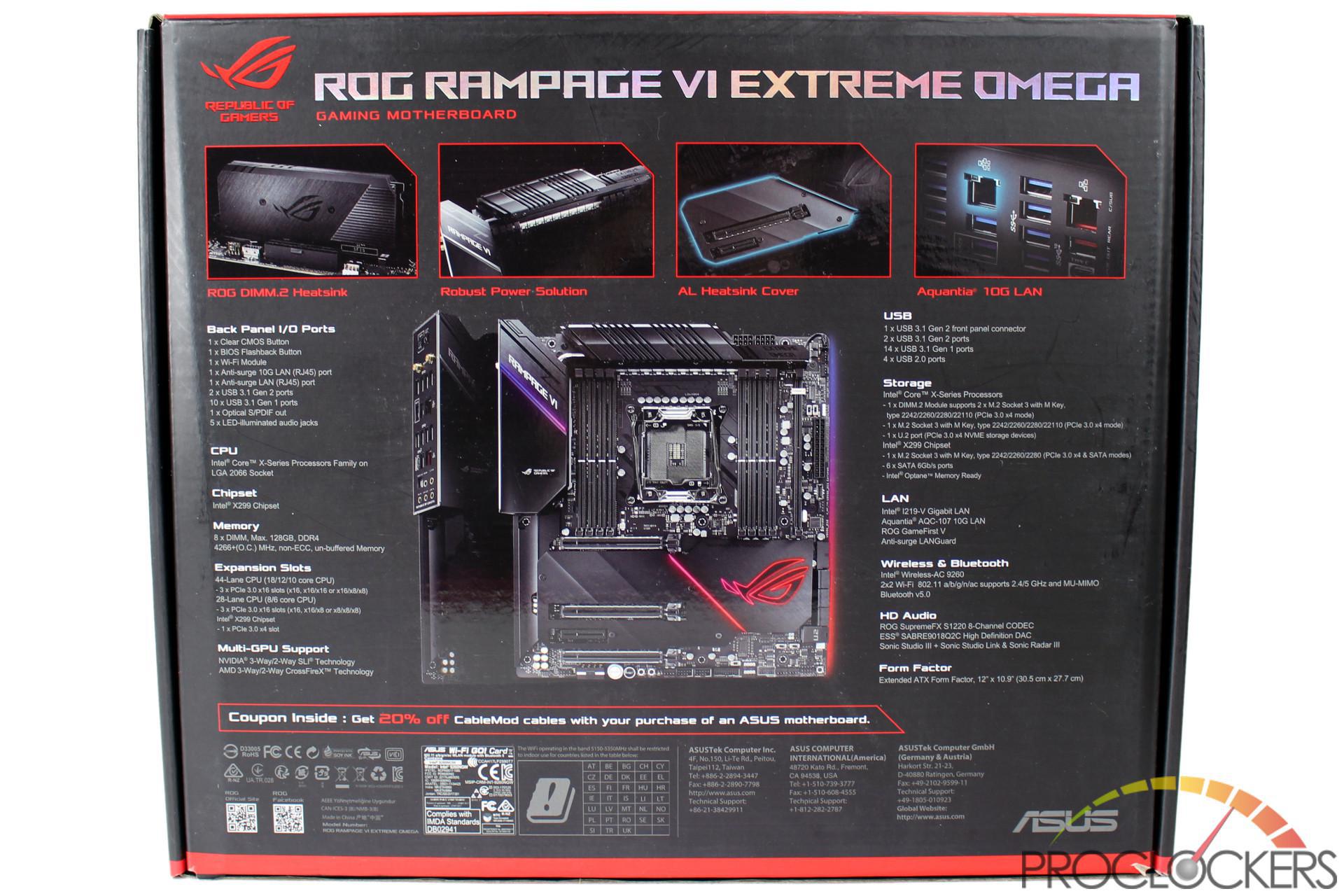
The rear of the box has a picture of the board in the center and is surrounded with features and specs.
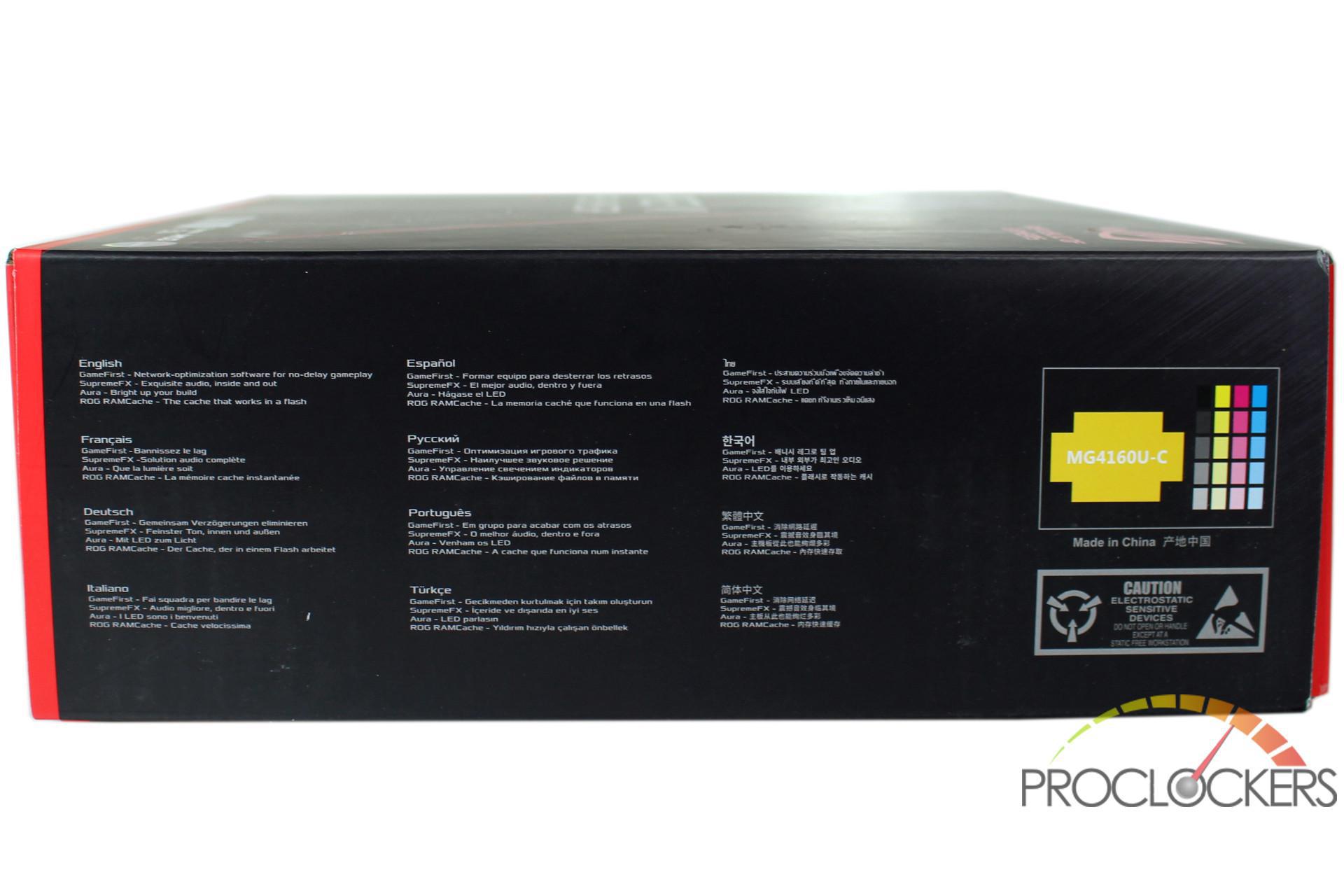
Some features can be found in several languages on one edge.

The bottom of the box has a simple slogan: The Choice of Champions.
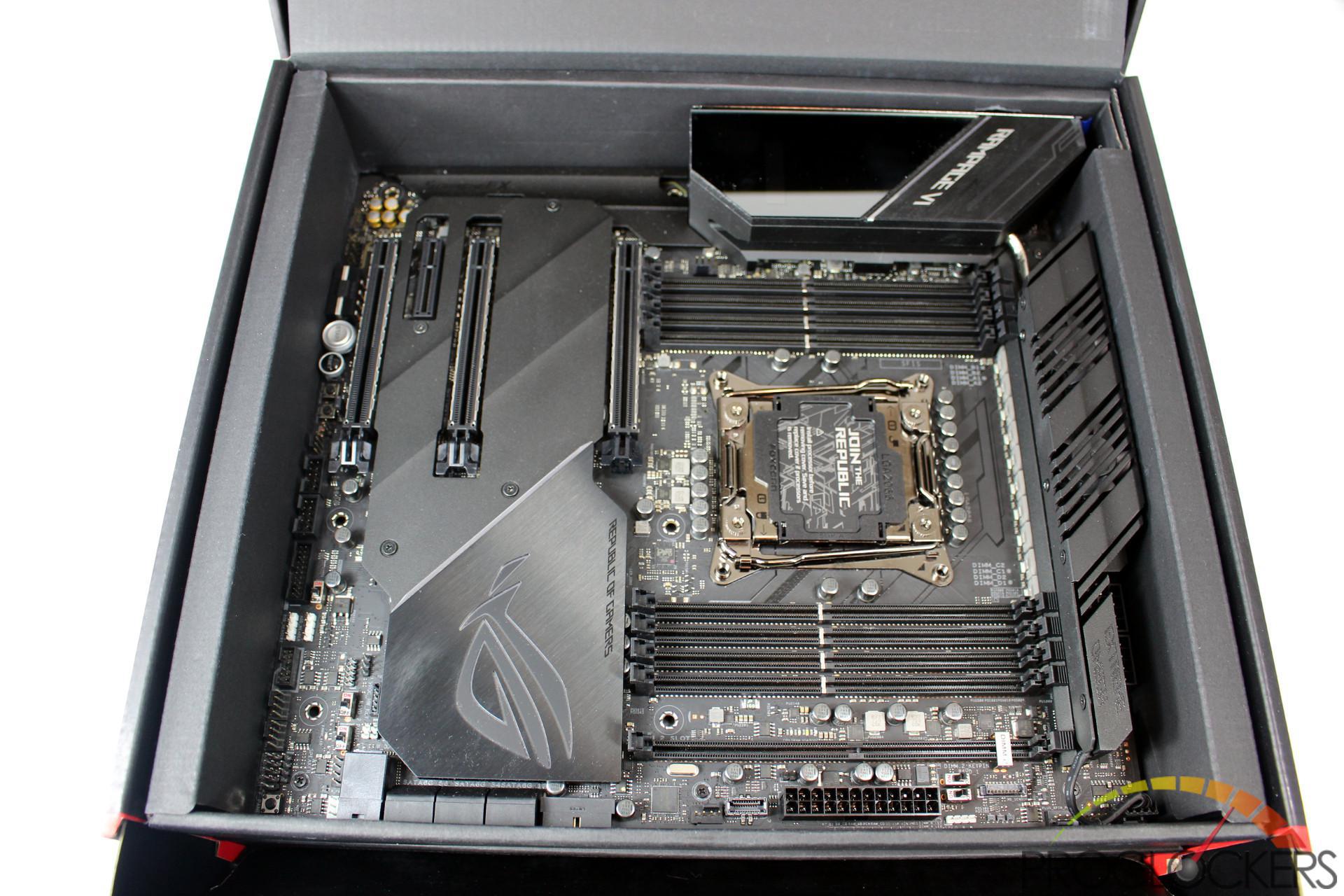
Inside, the Omega can be seen clearly under the clear cover in its own tray.
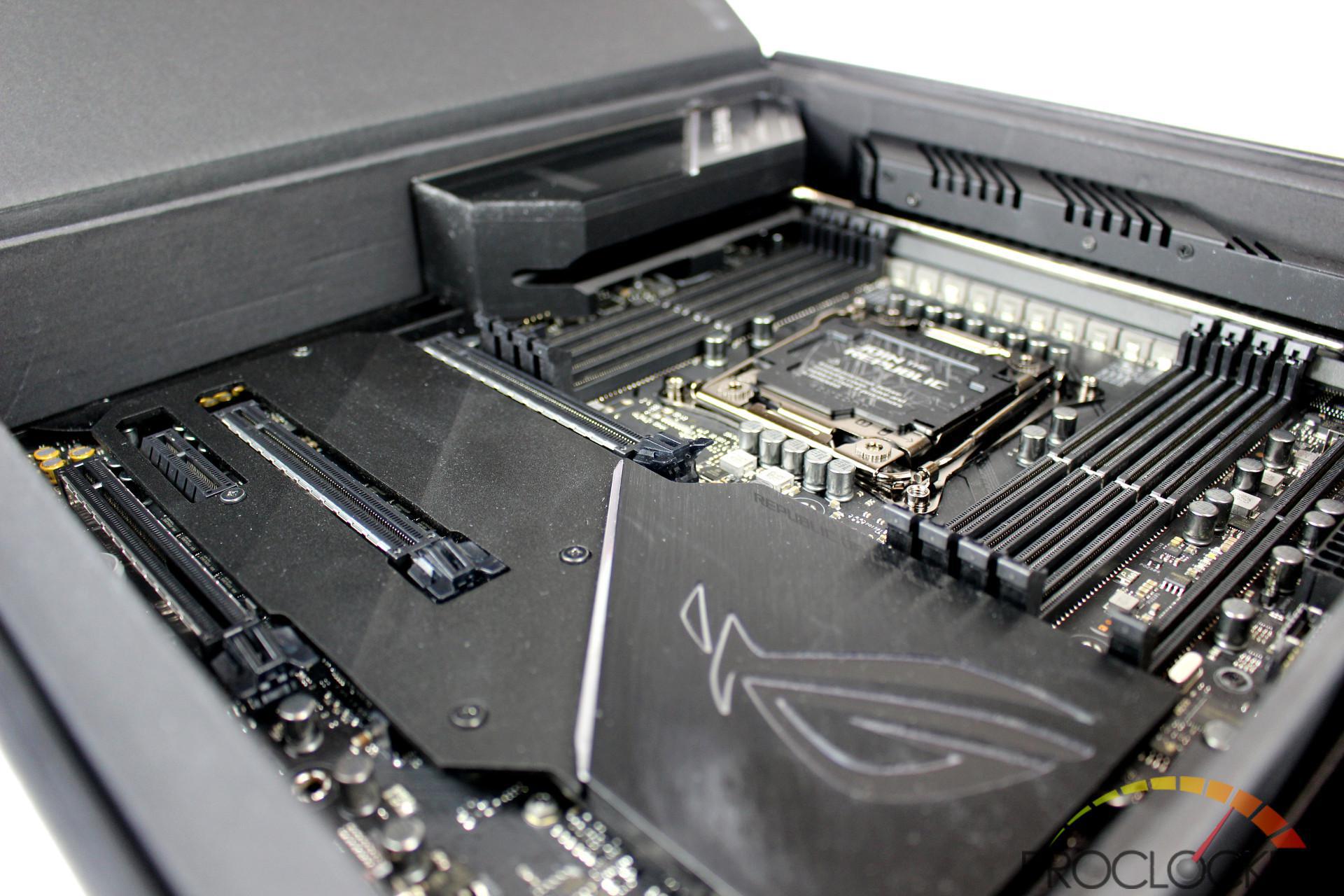
The board is very heavy, and you can see it is somewhat in part from a massive amount of aluminum heatsinks. There is very little plastic compared to the former Rampage VI Extreme
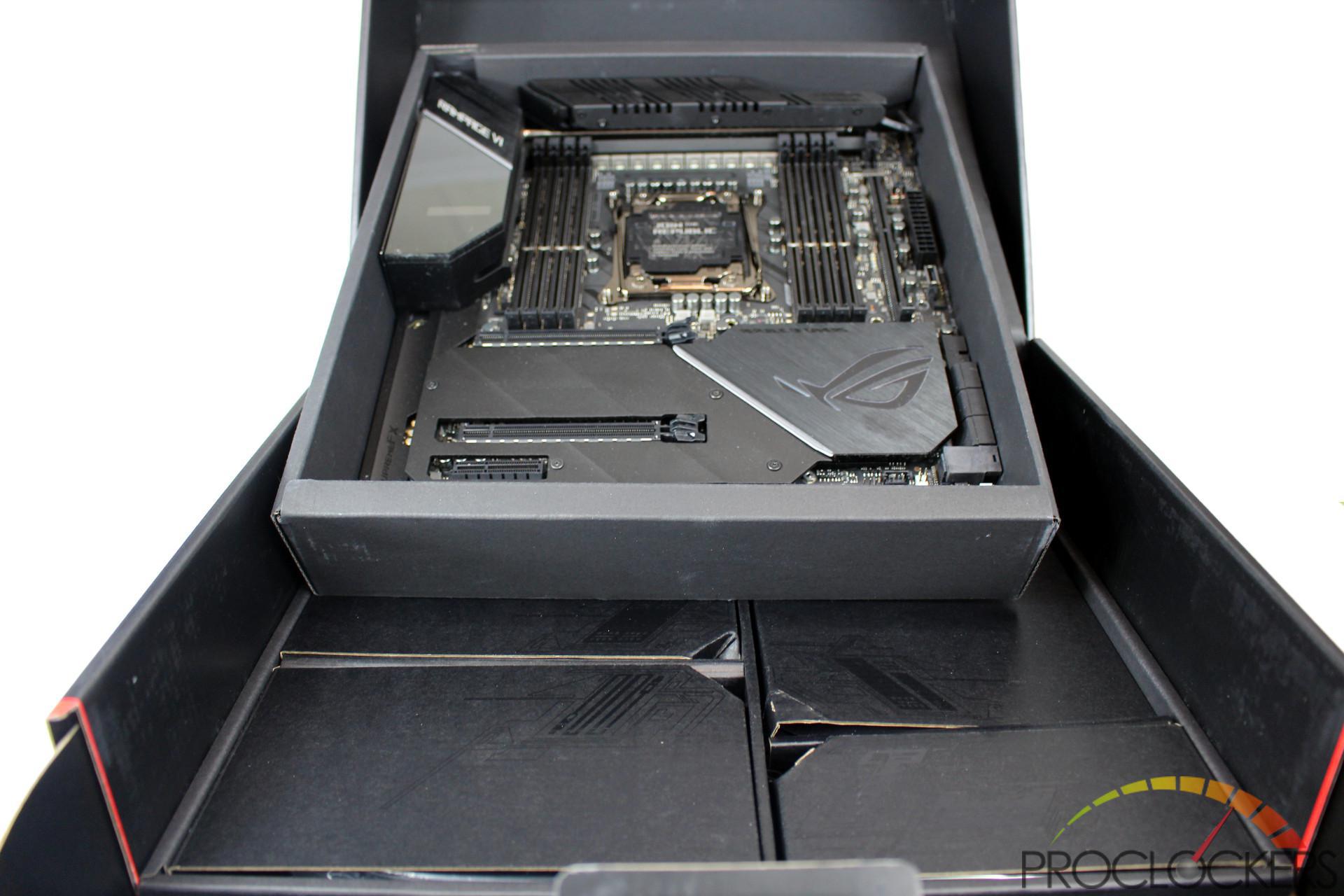
Under the motherboard tray is four compartments that hold all of the included goodies.
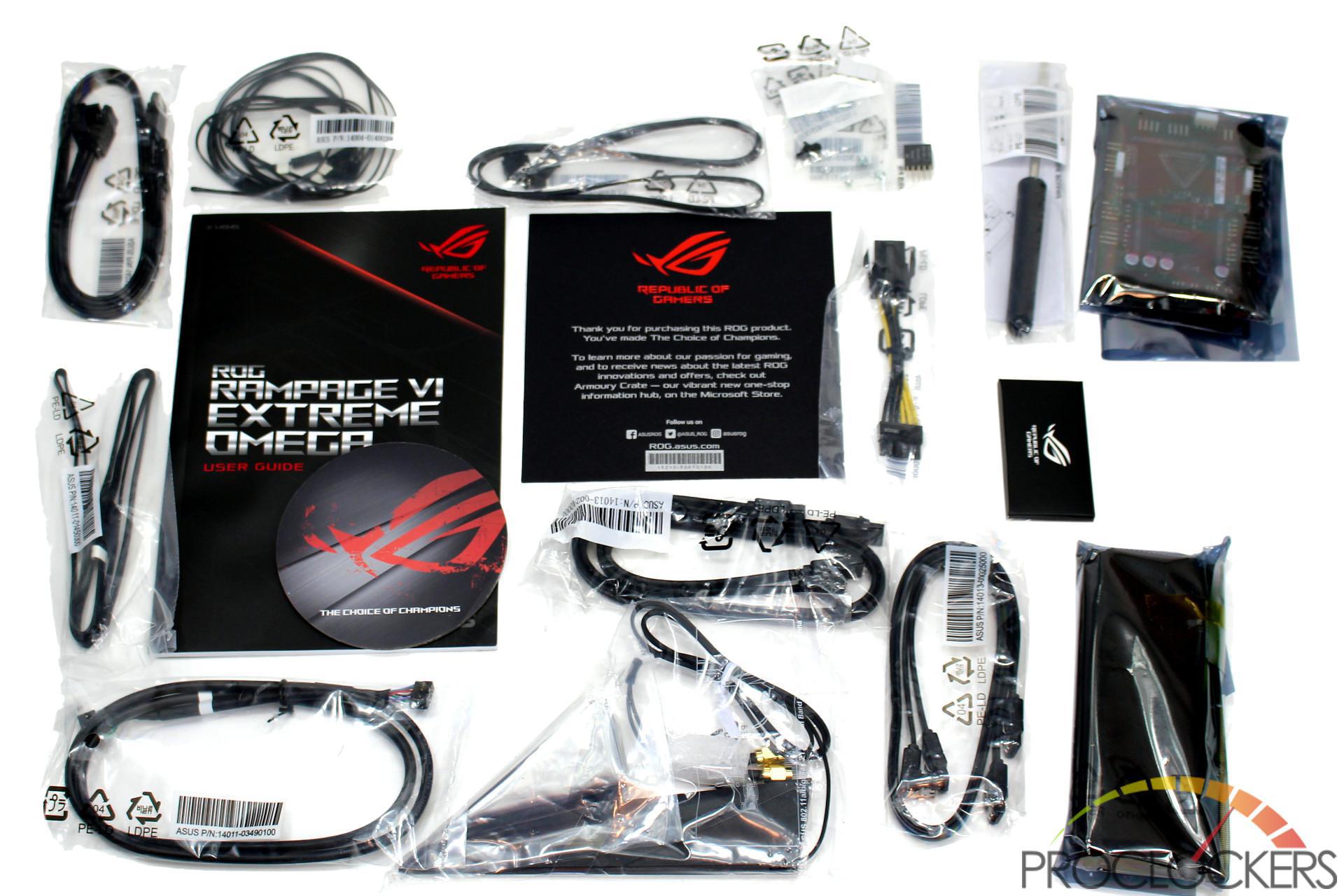
Like most of ASUS’s ROG products, the list of things included is extensive. Beyond the normal lot, you get the new Fan Extension II card and related cables, the Wifi Antenna, the updated Dimm.2 module, and a screwdriver. The drivers and software come on a small ROG USB drive now as well.
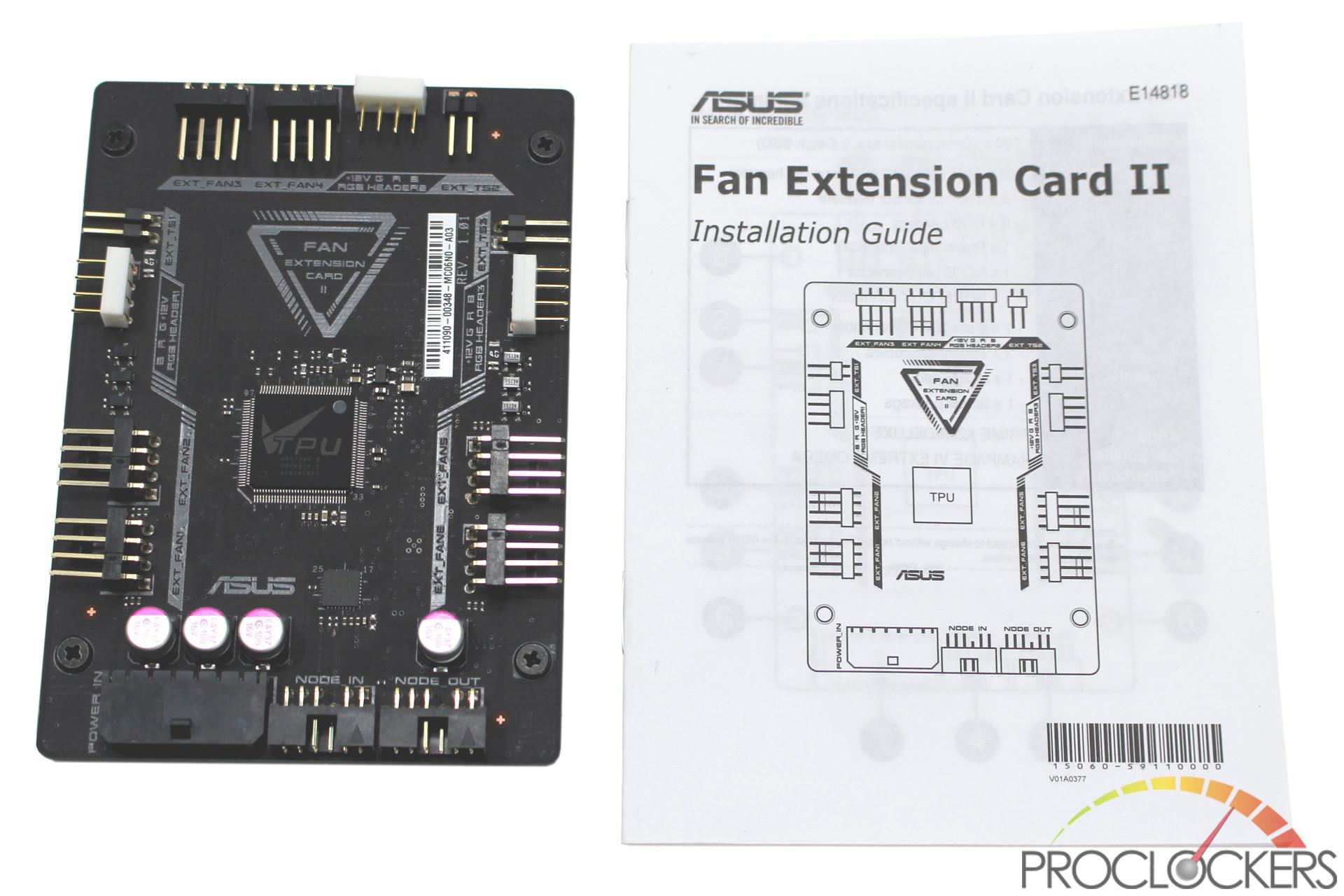
ASUS’s new Fan Extension Card II can be mounted anywhere a 2.5” drive can and provides six fan headers, three RGB headers, and three temperature probe connections. It runs over ASUS’s NODE connection and provides another NODE port for another downstream device.
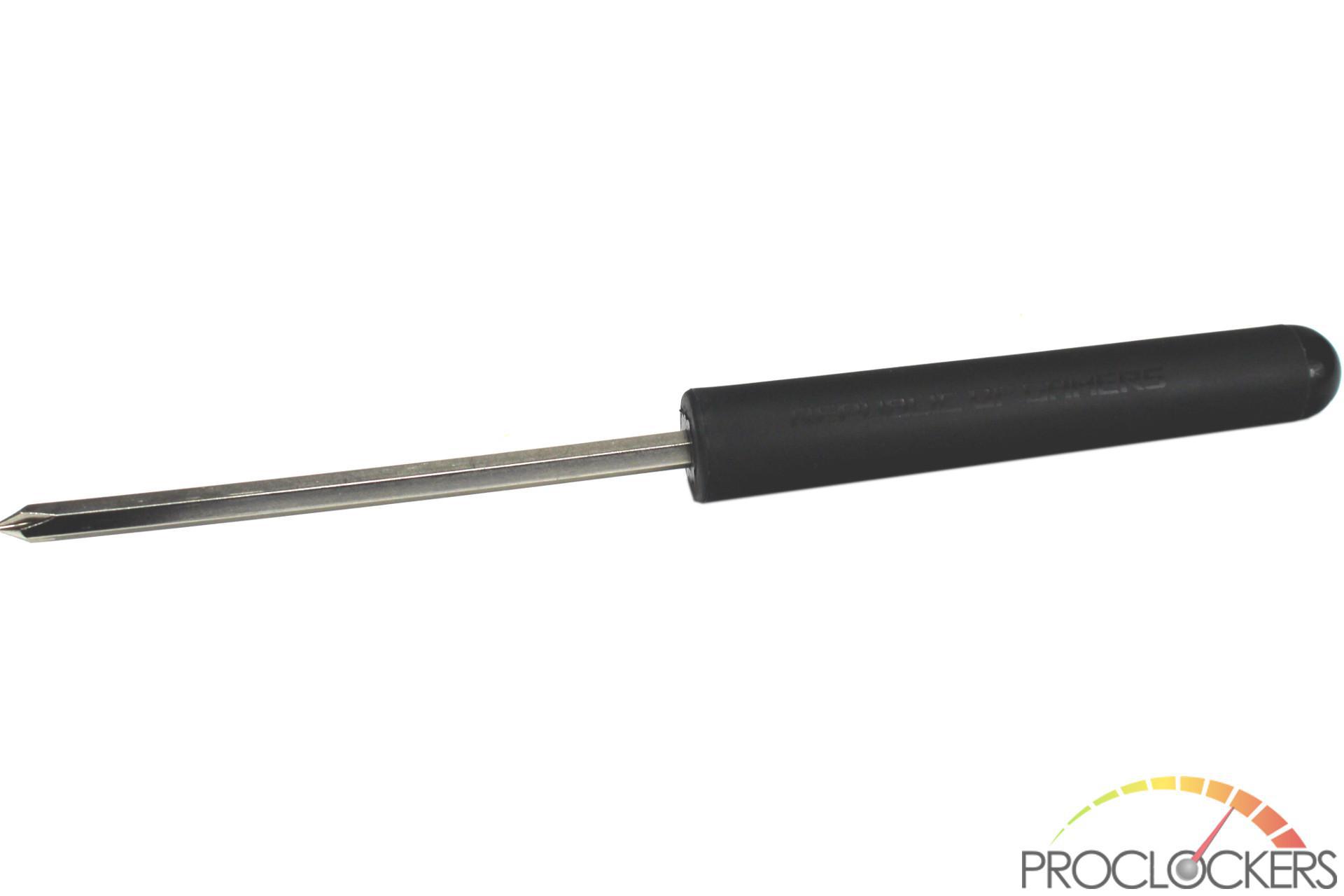
ASUS provides a small screwdriver with Republic of Gamers on the handle. The business end can be pulled out and flipped around to provide both Phillips and a hex driver. We’re not really sure what the Hex end is for, but it can be used to release ram sticks and PCIe slots that are hard to get to sometimes.
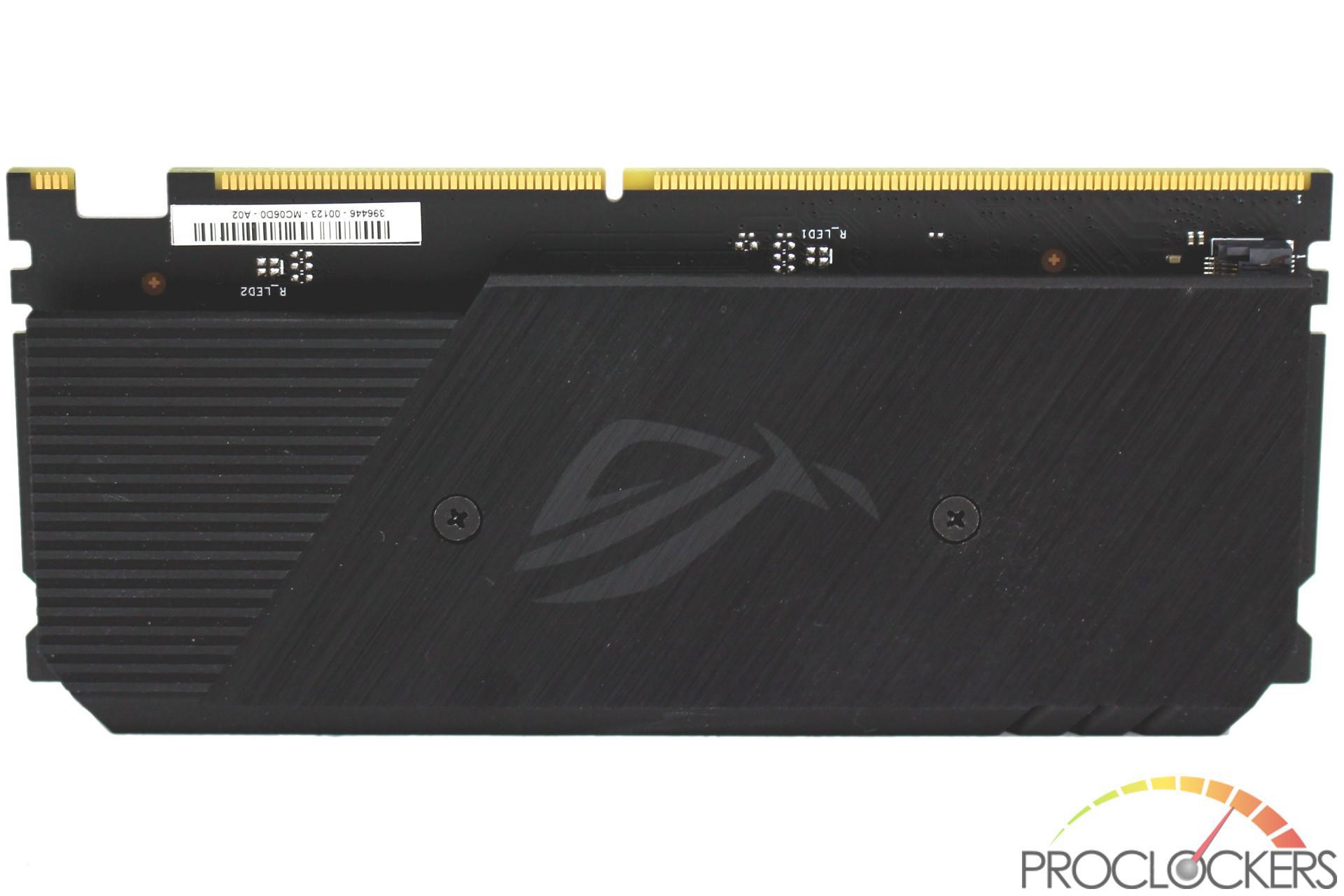
ASUS’s Dimm.2 module makes a comeback, but with a stylish matching, heatsink system to provide maximum performance with minimum temperatures.
A Closer Look
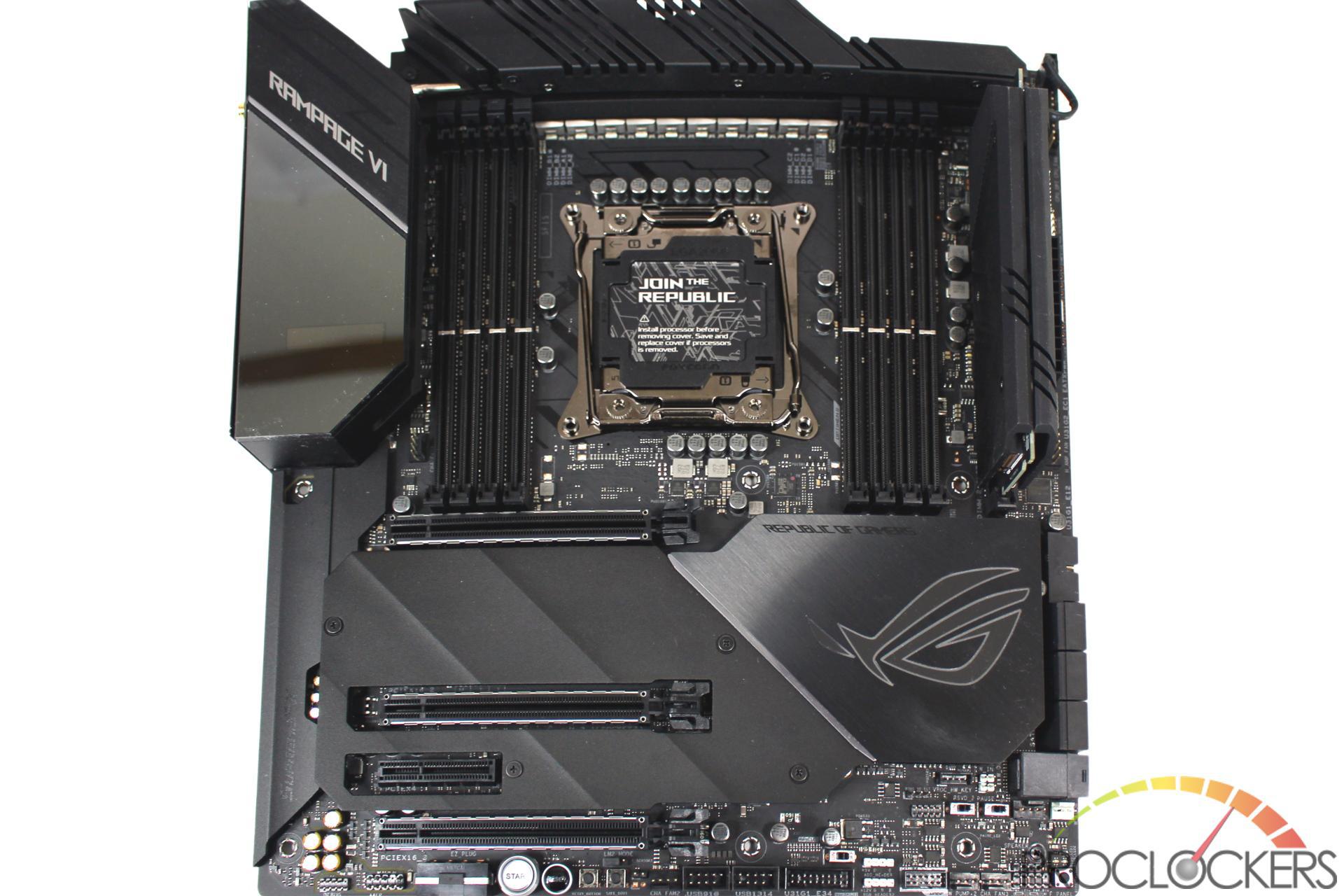
Similar to its sibling, the ROG Rampage VI Extreme Omega is an EATX board with a decidedly black metallic color scheme. You just can’t fit this much awesome in an ATX footprint.
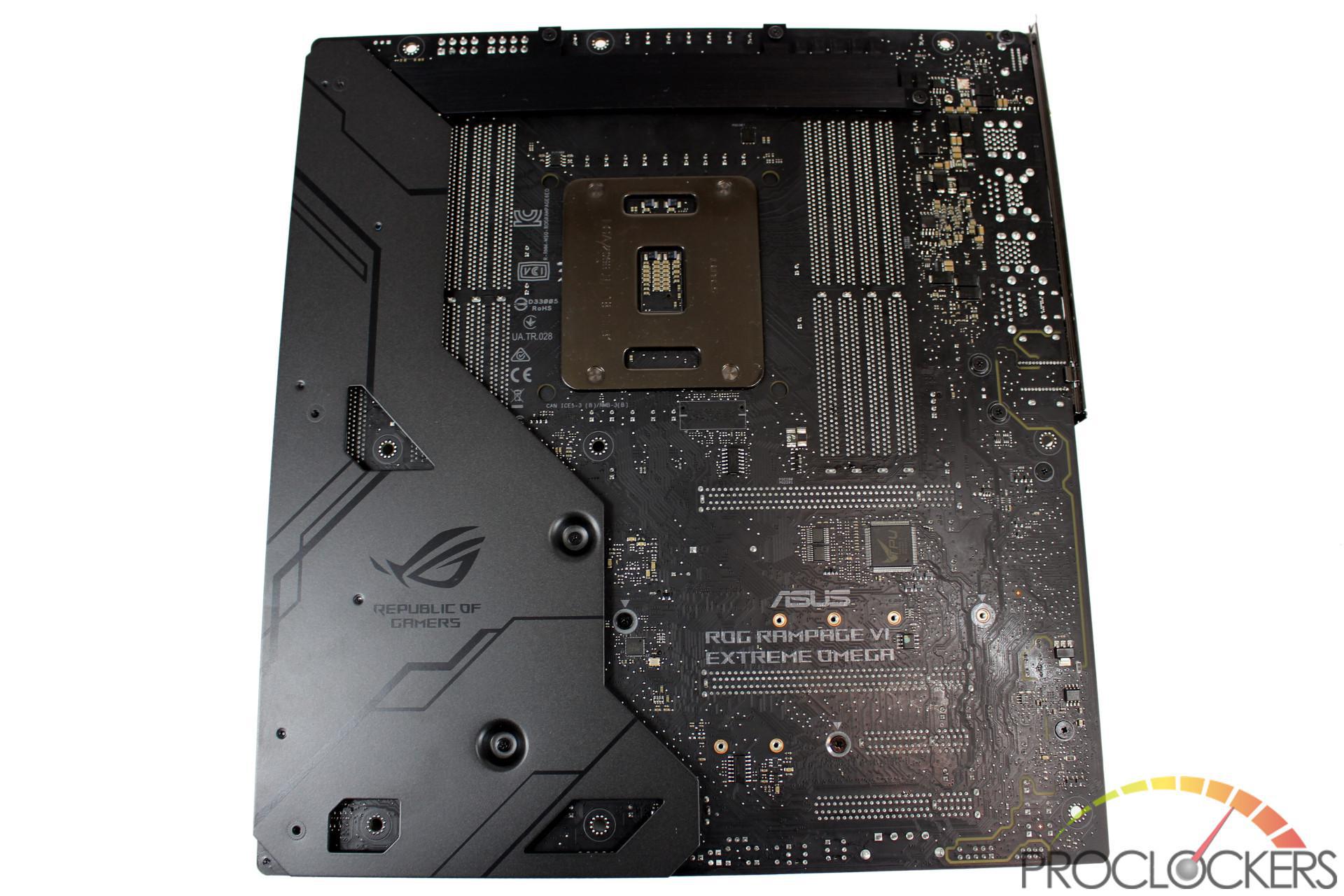
The rear of the board has a decent amount of components on the PCB. An armored plate covers a decent amount of the rear and a large backplate sits behind the massive VRM.
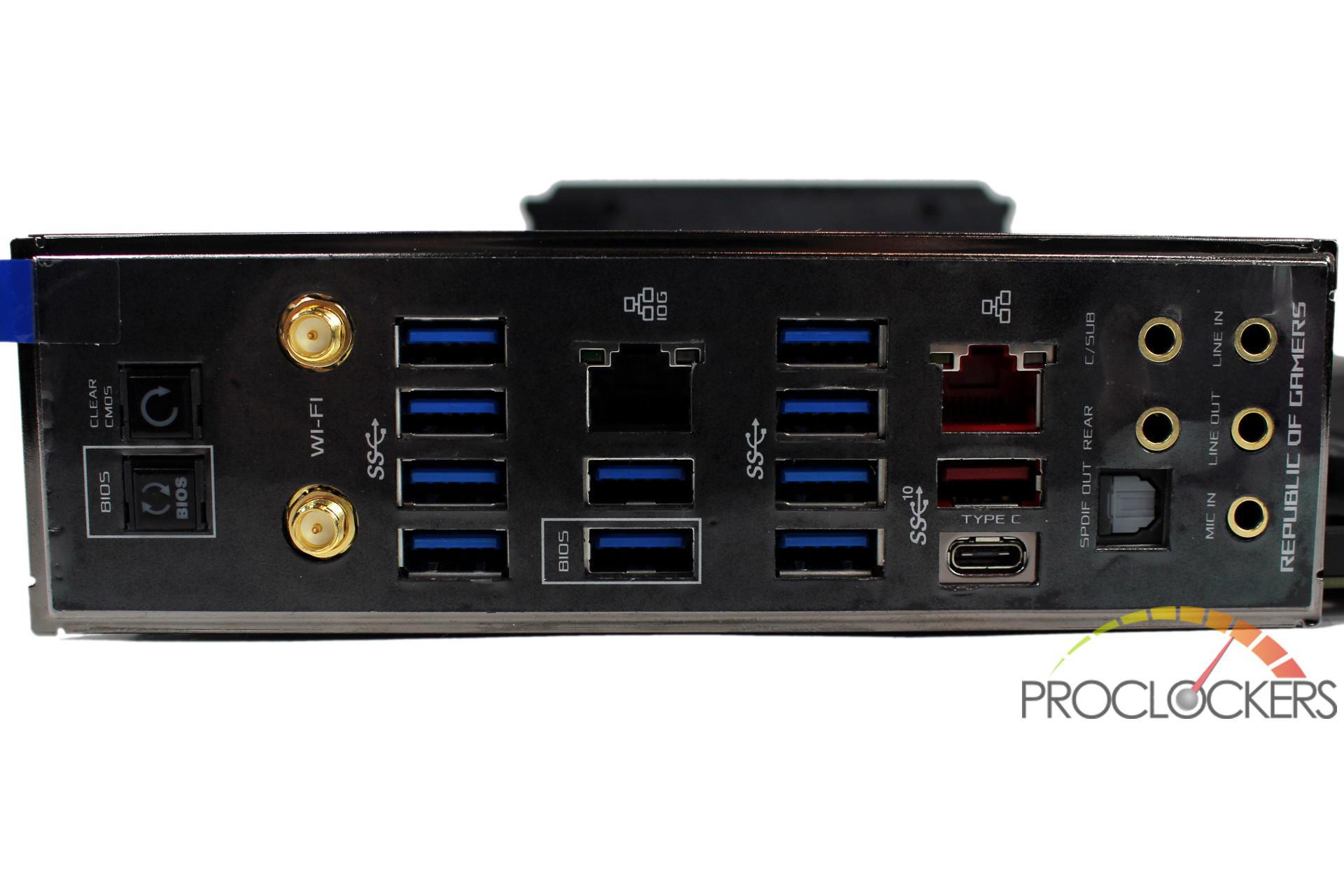
Rear I/O is comprised of USB ports. Ok, not ONLY USB ports, but it does have a dozen of them, all of them the 3.1 flavor. You also get two LAN ports, one Intel-powered gigabit, and one Aquantia 10-gigabit port. Intel’s Wireless-AC 9260 provides 2×2 WiFi and Bluetooth. USB BIOS flashback and Clear CMOS buttons are here, as well as lighted and gold plated audio ports. AN optical output finished up the roundup.
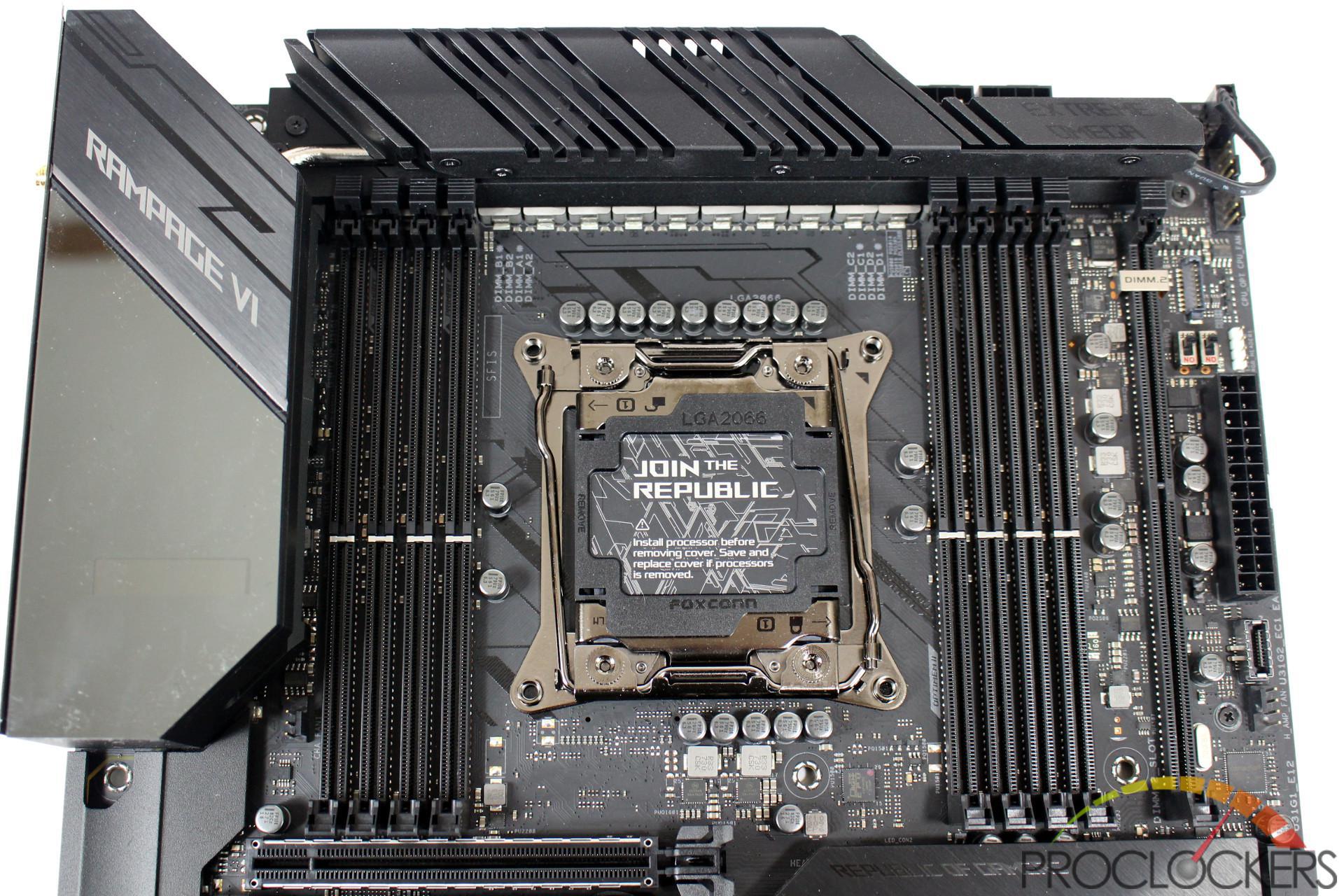
The top of the board is dominated with Intel’s LGA2066 socket, eight DDR4-4266+ DIMM slots and a massive heatsink over an equally massive VRM. A fully covered rear I/O area with LiveDash OLED display and a Dimm.2 slot take up the rest.
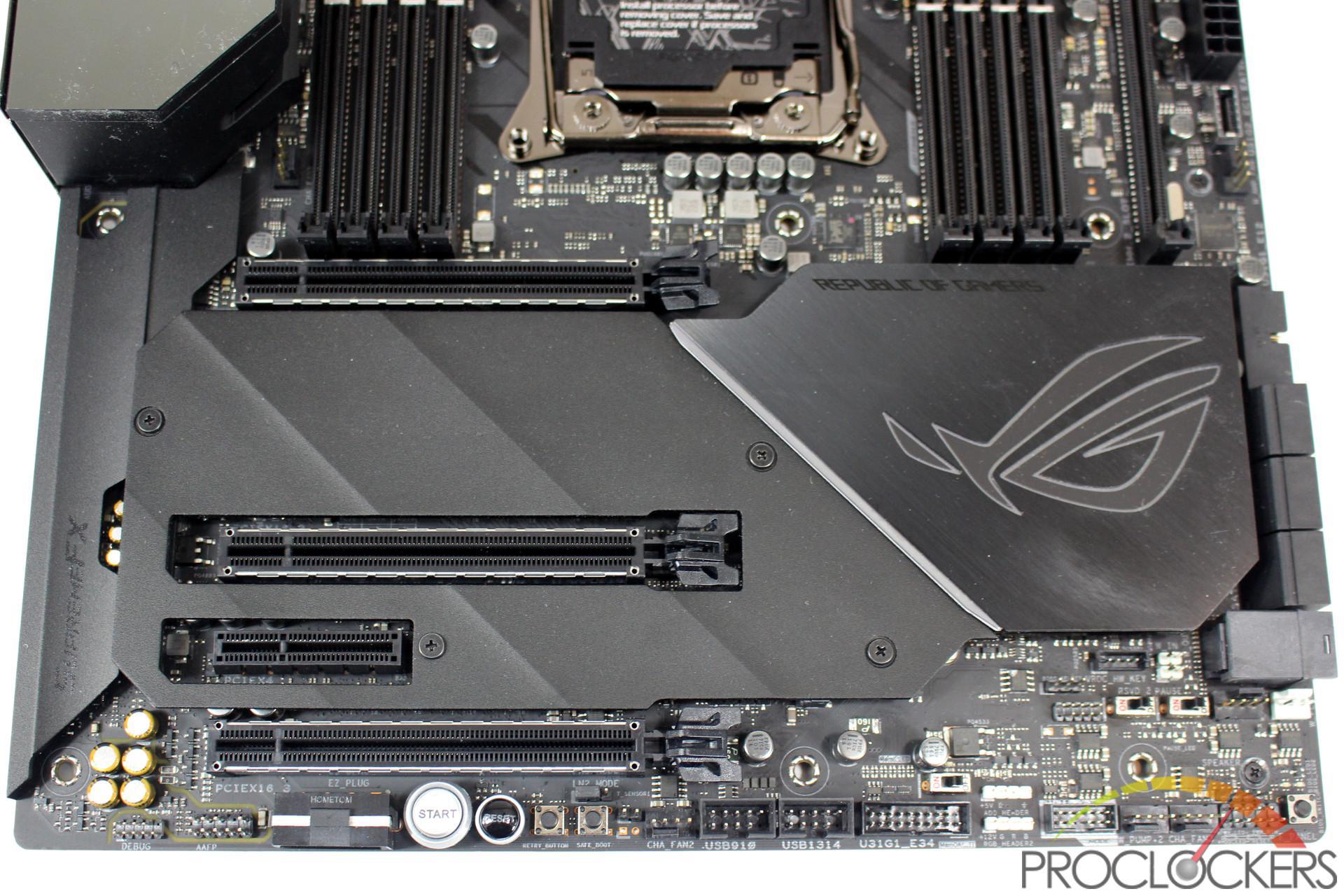
The massive new VRM system causes the socket and memory slots to be pushed down a bit compared to the previous iteration. You get three PCIe x16 slots that are more tailored to the larger GPU’s with >2-slot spacing. A single PCIe x4 comes from the chipset. Two M.2 slots hide under the massive aluminum heatsink around the PCIe slots.
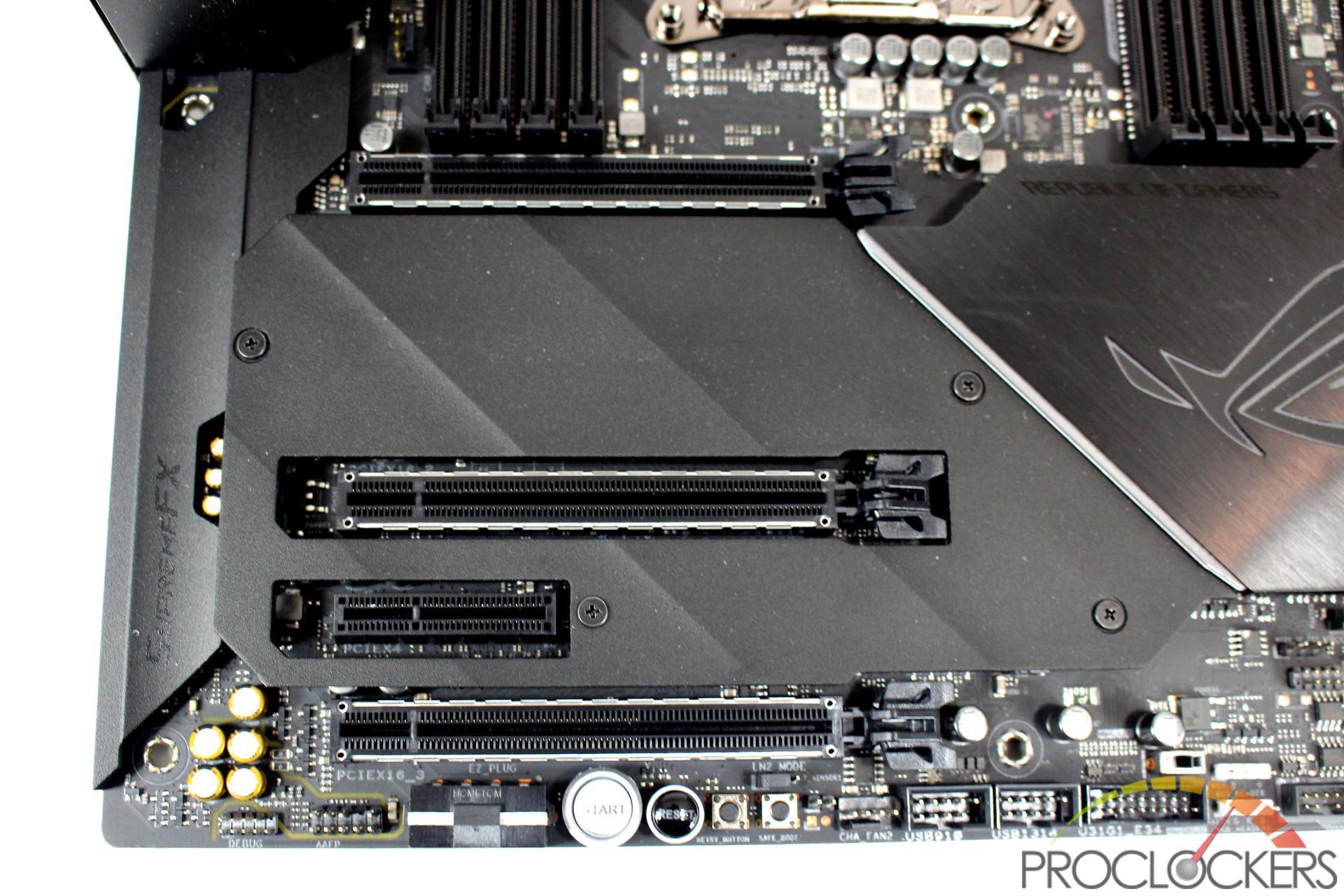
The amount of ports around the edge of the board is almost too much to list. Starting at the bottom corner, you get a debug port and front panel audio header and auxiliary power inlet for PCIe power. A white lighted power and reset switch sit next to a retry and safe boot button. An LN2 mode jumper is just above. A 4-pin fan header sits next to twin USB 2.0 headers and a USB 3.0 header.
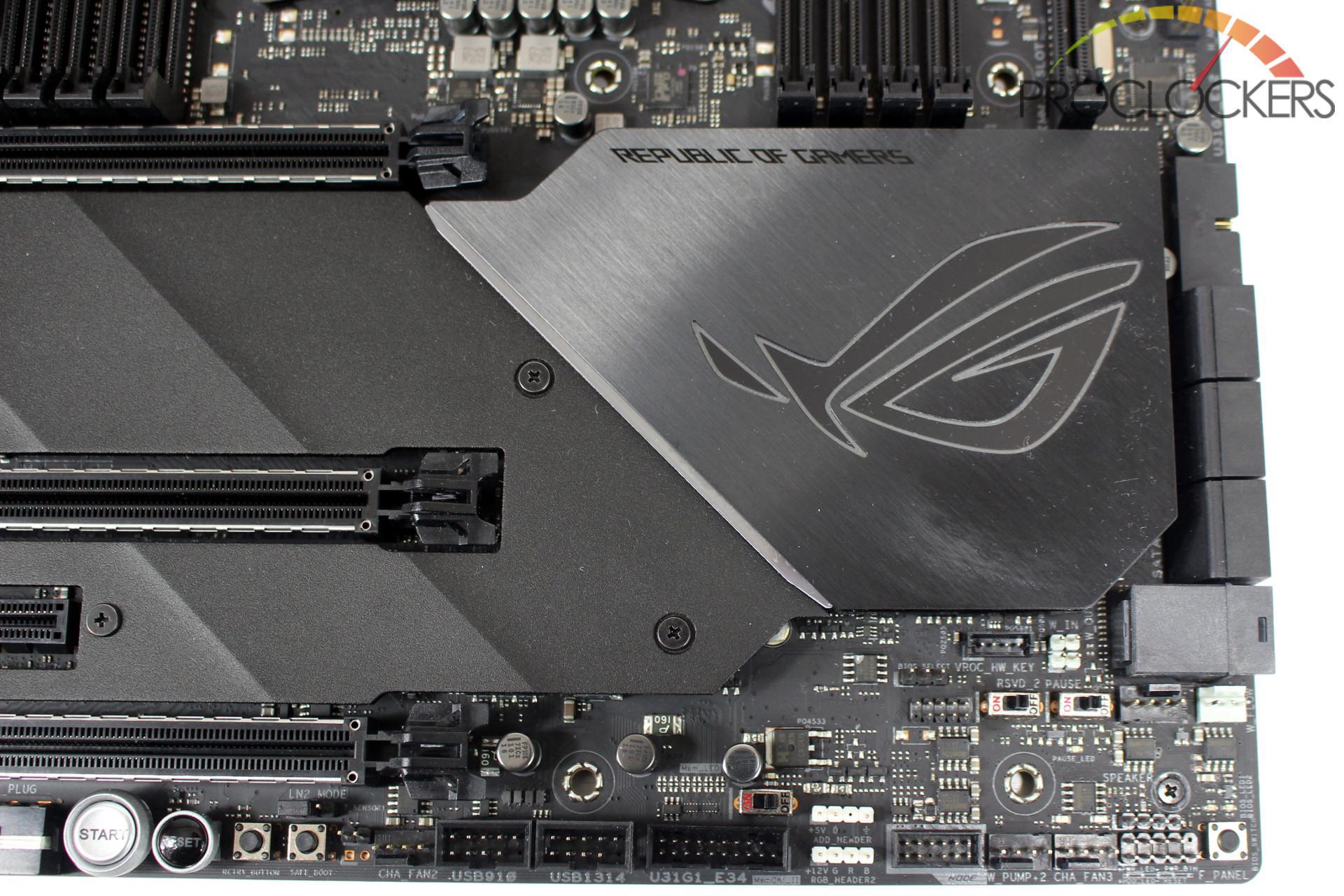
A switch for the Mem_OK II switch sits above the USB header. Two RGB headers and the new node connector are joined by two 4-pin fan headers, one of which is ready for high powered pumps, and the front panel I/O connections. A BIOS select switch sits in the corner. Up a bit, you have a VROC key plug, two temp probe connections, another pump header, a flow meter header, and Pause switch.
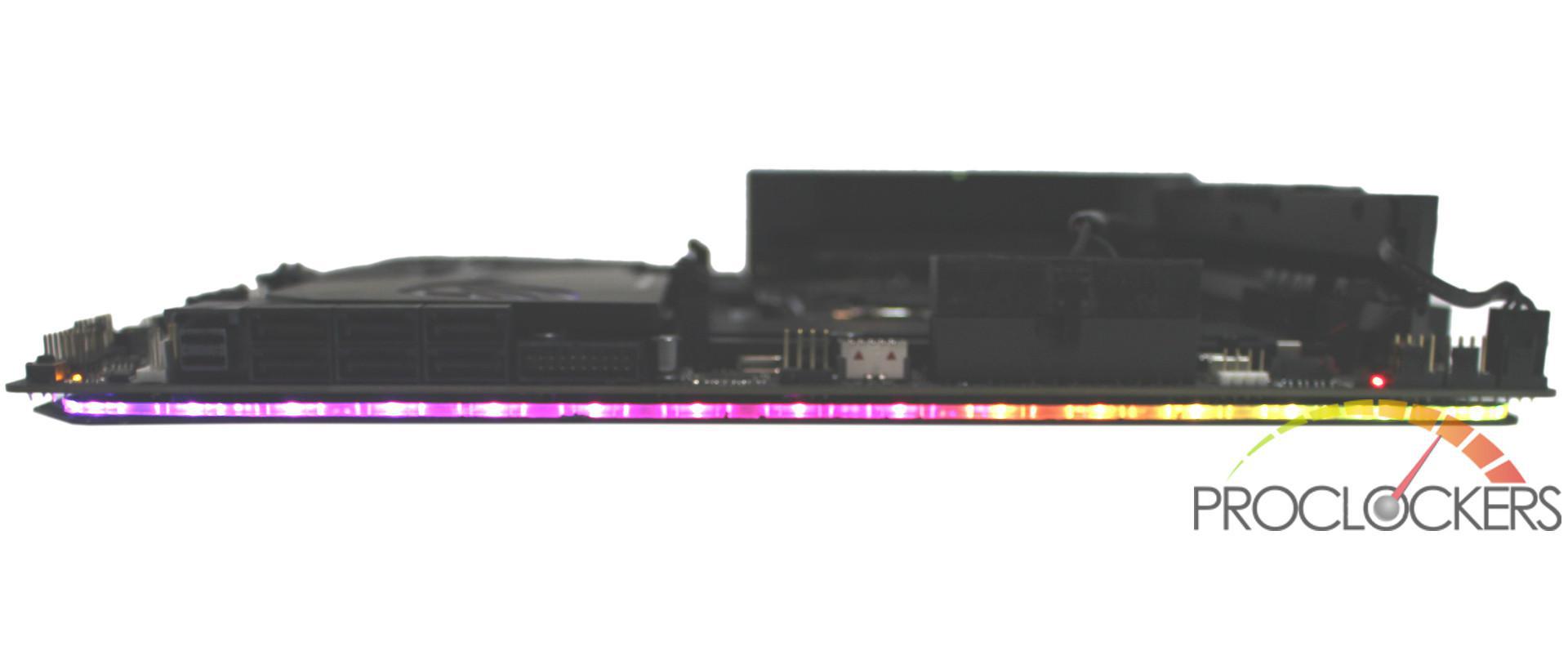
Going up the front you have a U.2 port, six SATA ports, USB 3.0 and 3.1 ports, and another 4-pin header. The AURA sync compatible edge lighting system makes a return here as you can see.
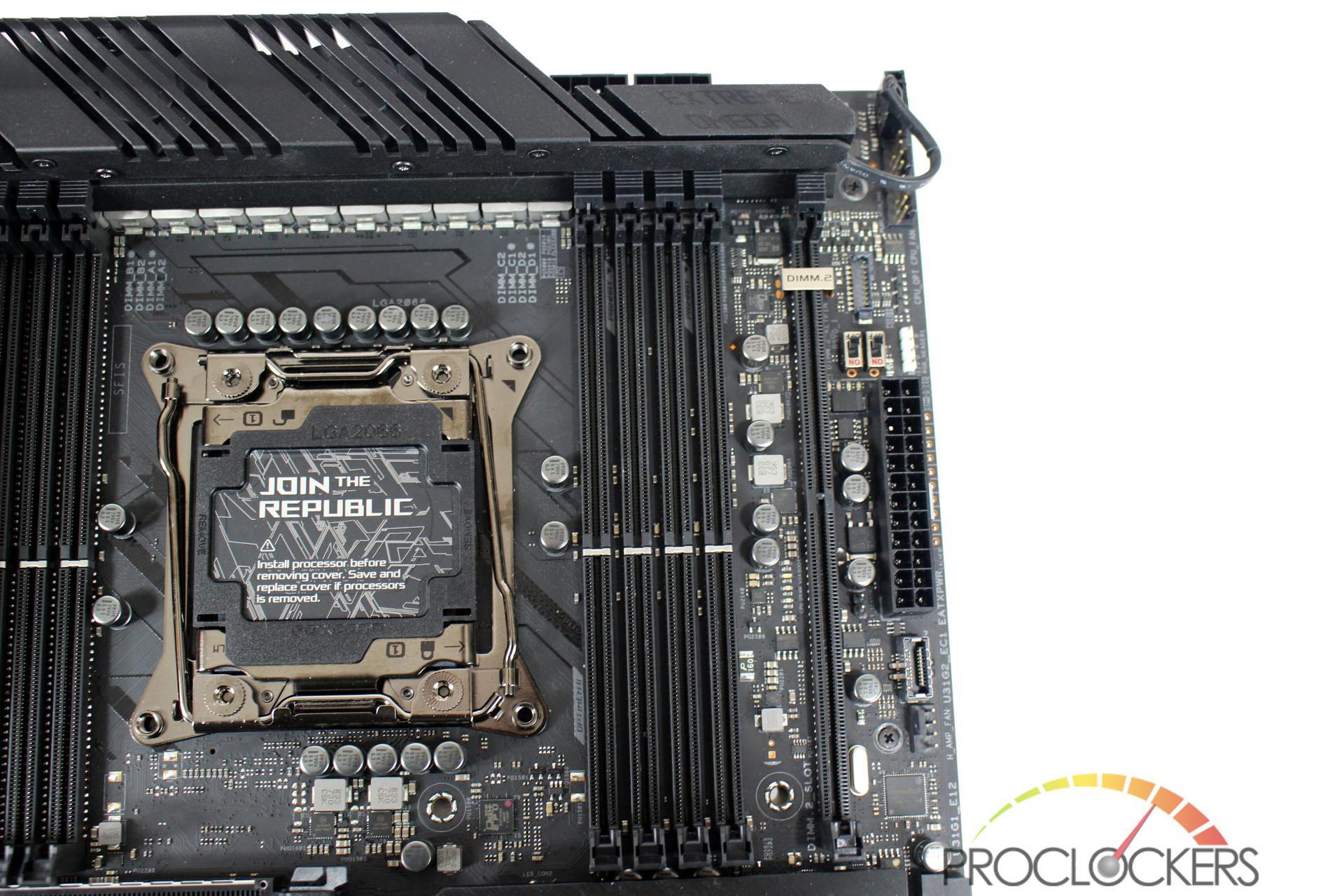
The top corner has the main 24-pin power, Probe-IT spots, and another RGB header, slow mode switch, monoblock header, CPU and heatsink fan headers and an extra CPU fan header. The twin 8-pin EPS power connectors sit in this corner as well just above the heatsink.

The rear I/O area has the LiveDash OLED display and an RGB accent strip under the RAMPAGE VI logo.
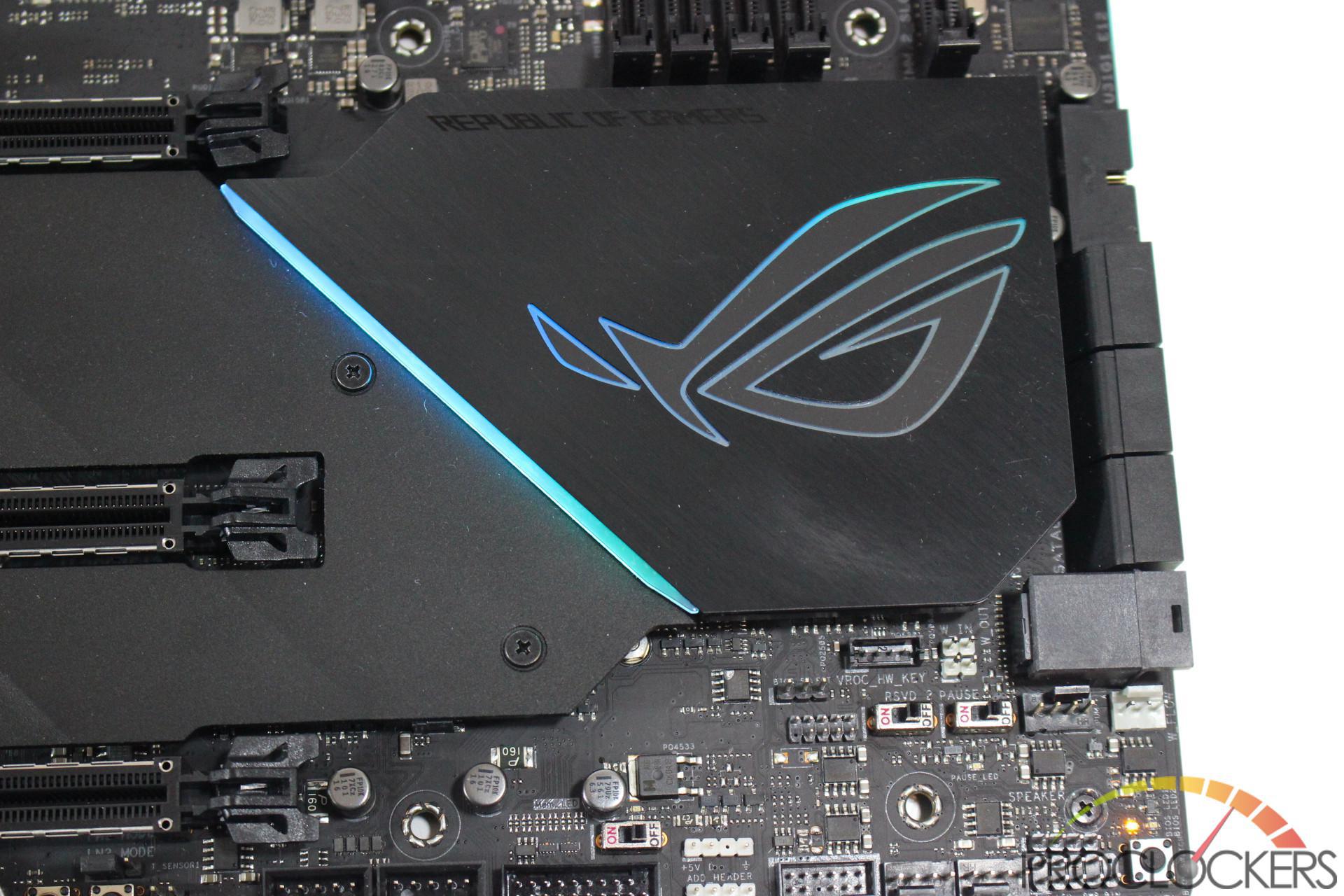
The chipset heatsink also has an accent strip as well as the entire ROG Eye logo that glows.
Under the Hood
Four screws hold the M.2 heatsink on, one of which is captive. Pre-installed thermal pads thermally link each drive to the heatsink.
One of the biggest changes is the new VRM. Twin fans sit inside the heatsink to provide active cooling, but they don’t turn on until the heatsink reaches 60C. you can change this in ASUS’s software.
The rear armor piece is what has the front edge RGB strip.
Behind the VRM is a large backplate that helps to spread heat as well with a few thick thermal pads.
With all of that out of the way, you can finally remove the massive VRM heatsink assembly. Even though there is a large heat pipe in it, it comes off as one large piece. It also cools the Aquantia 10GB LAN chipset as well.
The Twin power stage 8-phase VRM is comprised of 16 power stages and 16 chokes and can provide a staggering 720A continuously which can equate to more than 1500W to an overclocked CPU while remaining cool thanks to improved efficiency. The twin power stage per phase also shortens transient response time for more stable power with less over and undershoots.
Each of the 16 IR3555 PowIRstages is rated to handle 60 amps while each Microfine Alloy Choke can handle 45 amps continuously. 10K Japanese caps provide output filtering with a long life, even in a high heat environment.
Aquantia’s AQC107 chipset provides wired LAN that can run at 10M, 100M, 1G, 2.5G, 5G, and 10G speeds.
Intel’s latest Wireless-AC 9260 provides dual-band 2×2 wireless up to 1.73Gbps as well as Bluetooth 5.0.
All of the VRM controllers on the board are fully digital and based on International Rectifier’s designs. This one provides the 8-phase control to the main Vcore VRM.
Intel’s X299 chipset hides under a large heatsink in the corner.
And here we go, the ROG Rampage VI Extreme Omega in all its nude glory. Even without all the functional decorations, it still looks great!
System Configuration & BIOS
CPU: Intel Core i7-7900X
Motherboard: ASUS ROG Rampage VI EXTREME Omega
RAM: 32GB Corsair Dominator Platinum 3200Mhz
GPU: Nvidia RTX 2080 FE
SSD: Toshiba RC400 480GB
OS: Windows 10 Professional X64
The first page you land on when entering the BIOS is the My Favorites tab. You can, of course, customize this to your heart’s desire, but this is what you get by default.
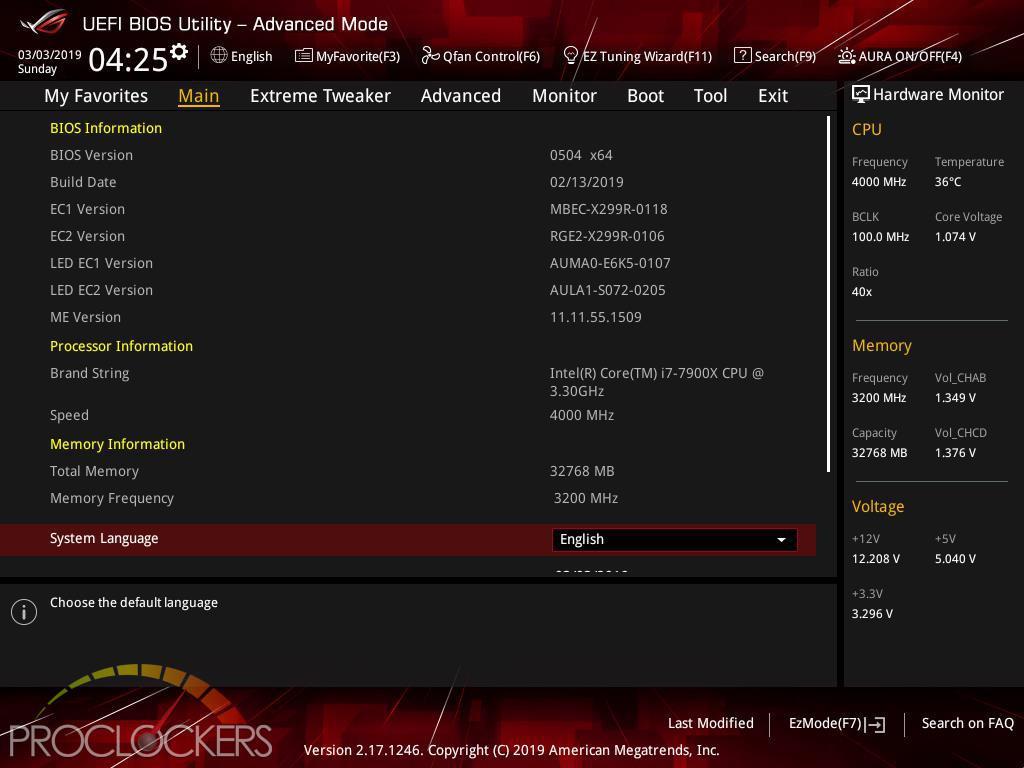
The Main Tab gives all the basic Info. You can see here with have an Intel Core i9-7900X CPU installed and 32GB of ram running at 3200Mhz.
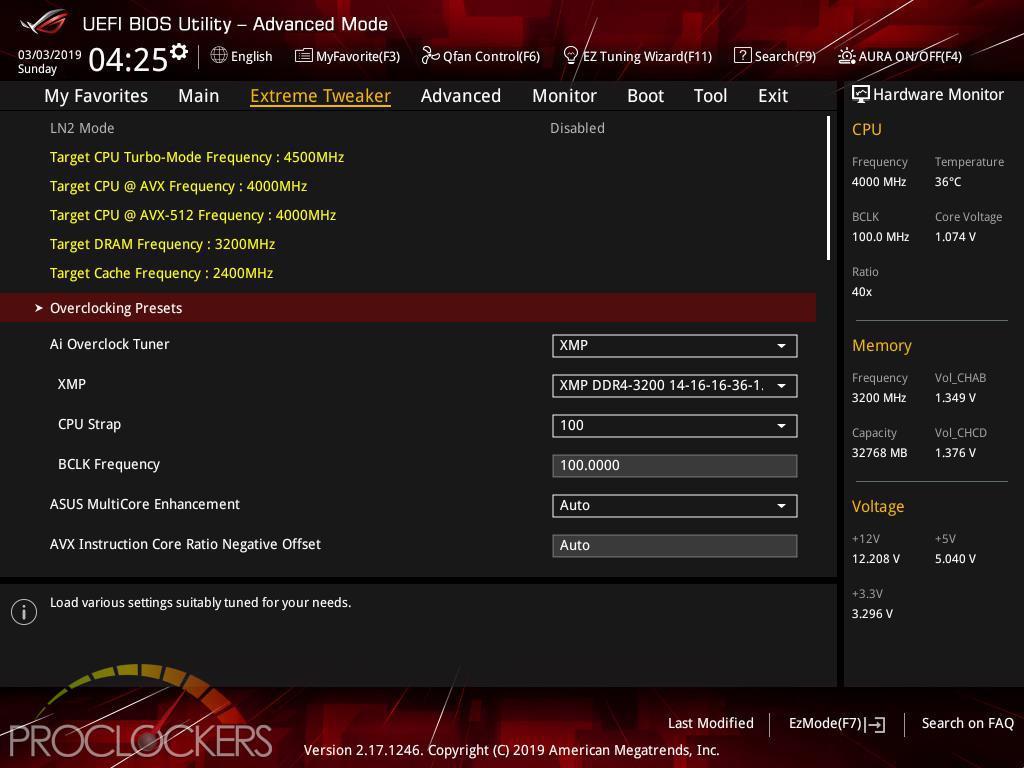
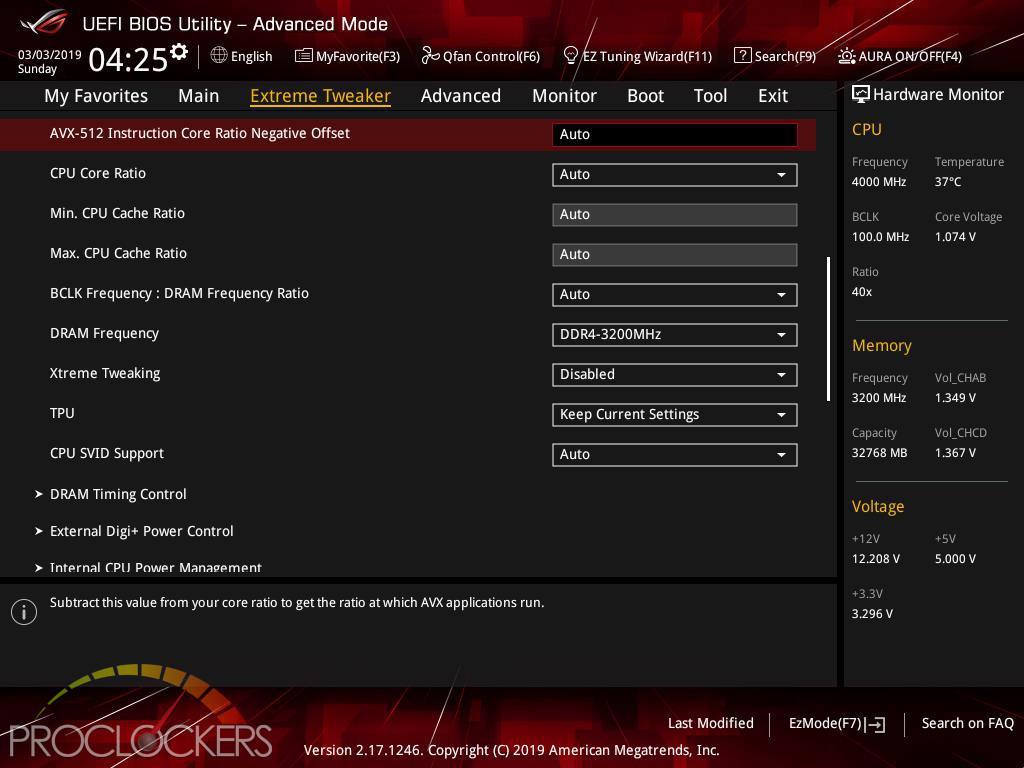
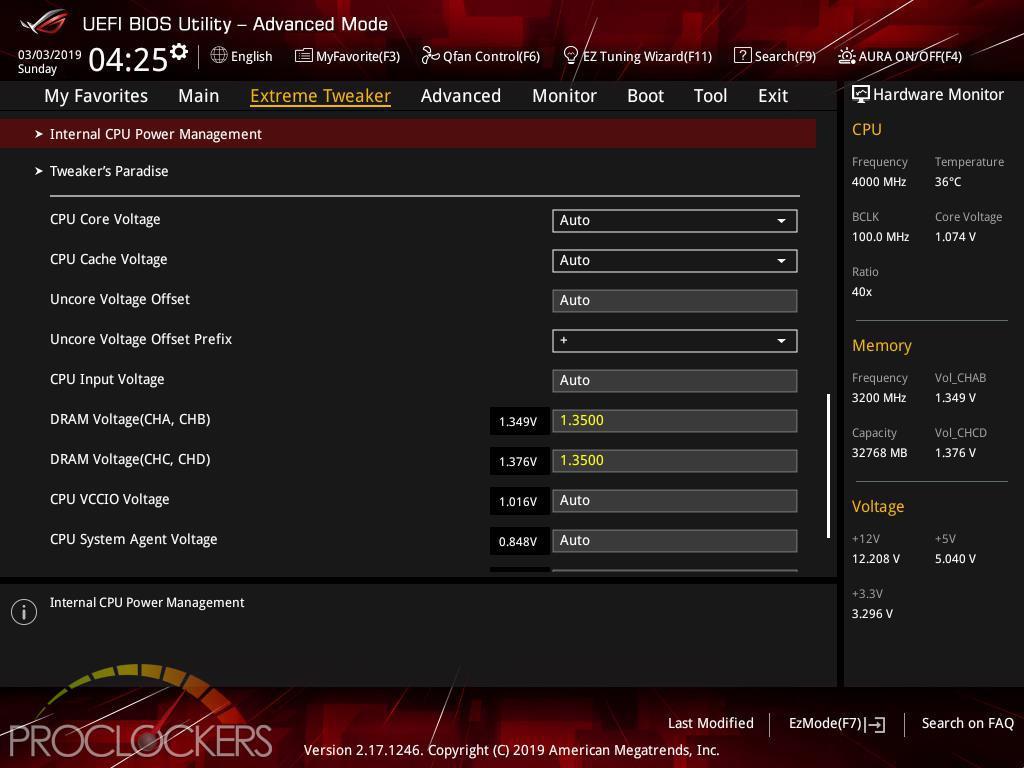
The Extreme Tweaker tab is home to all of your overclocking controls. Voltages, multipliers, dividers, and even things like memory timings can be controlled from here or one of the submenus.
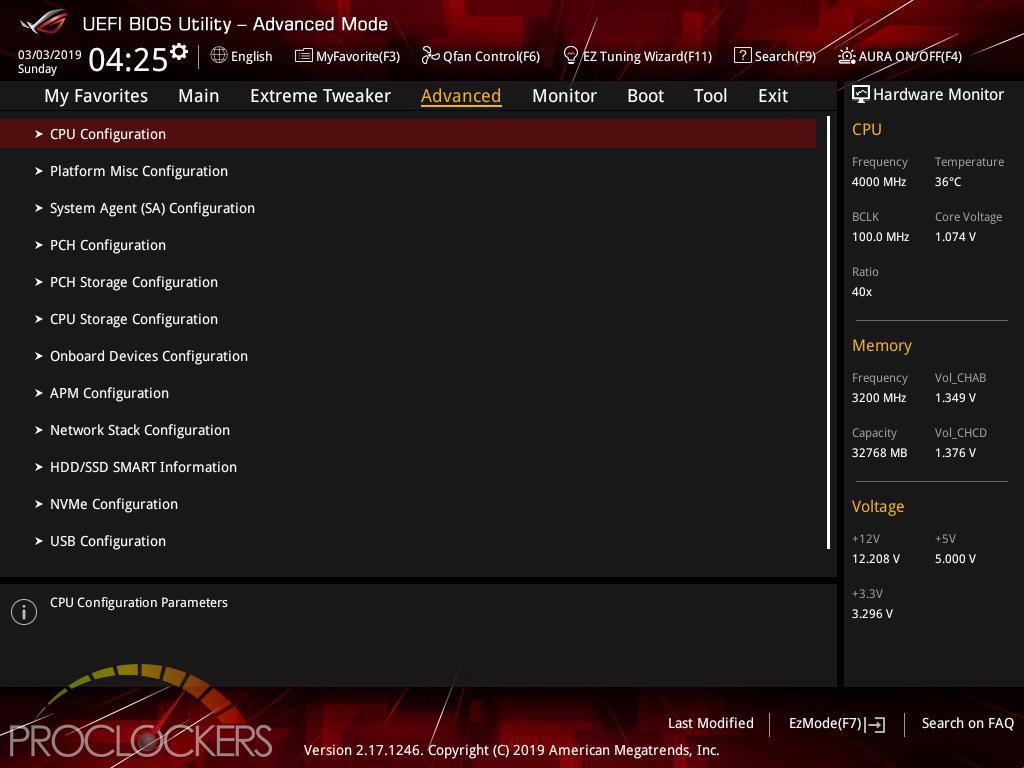
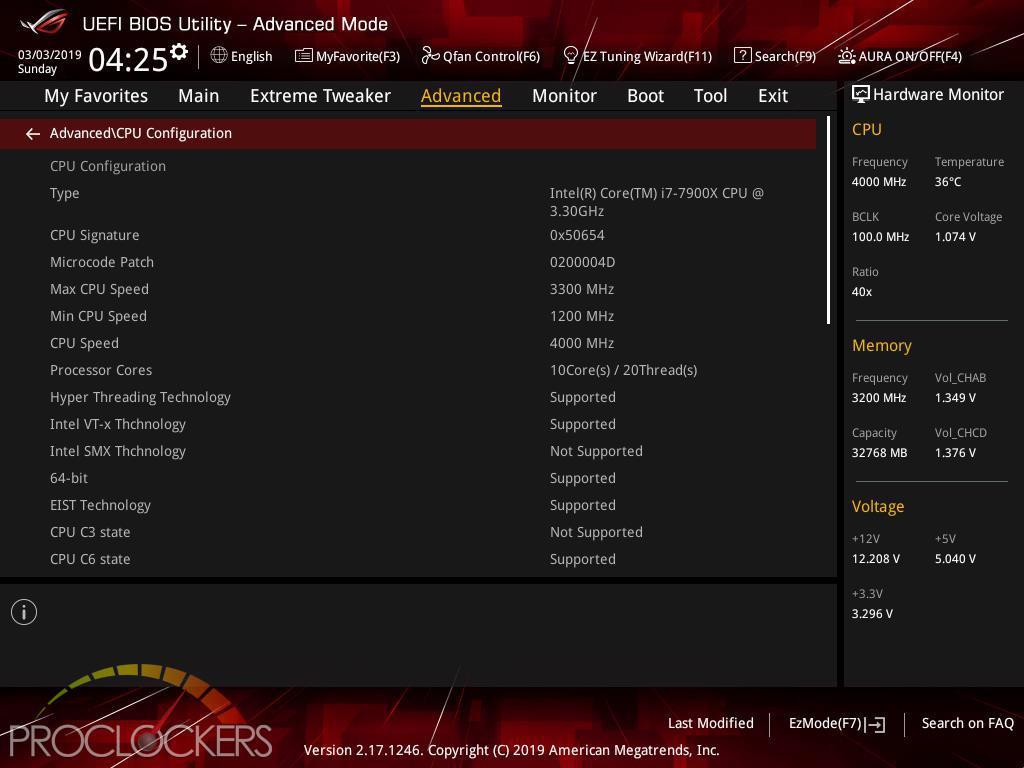
Advanced is as it says, all the advanced features. Things like disabling cores, Hyper-Threading, and system devices are in here.
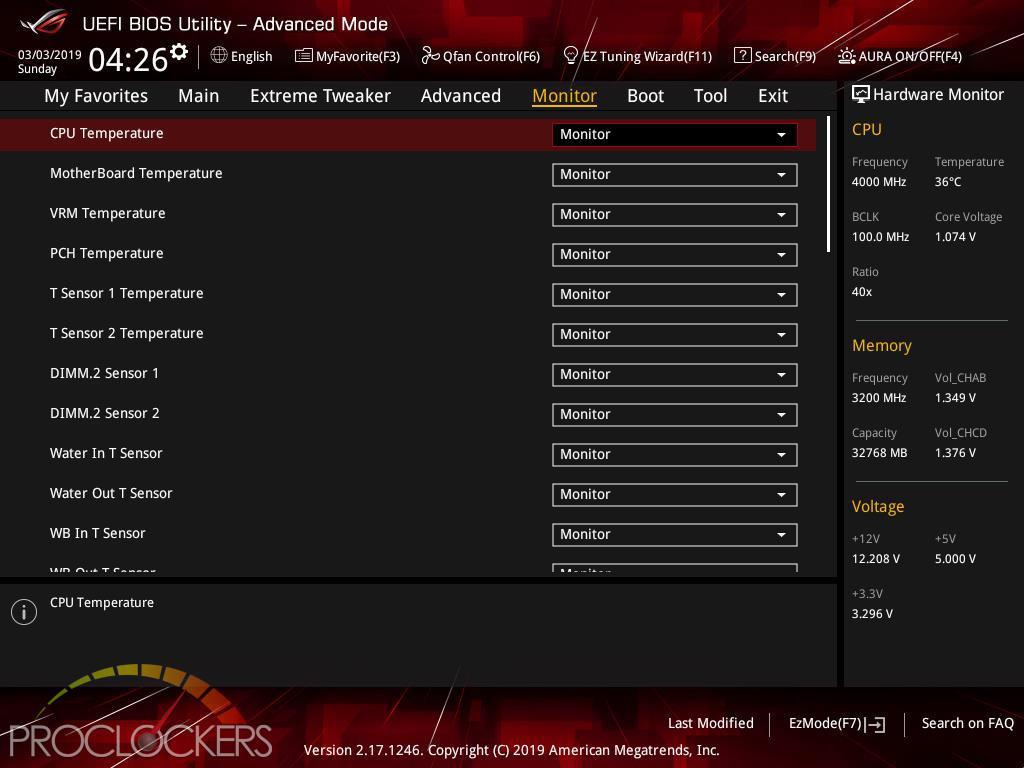
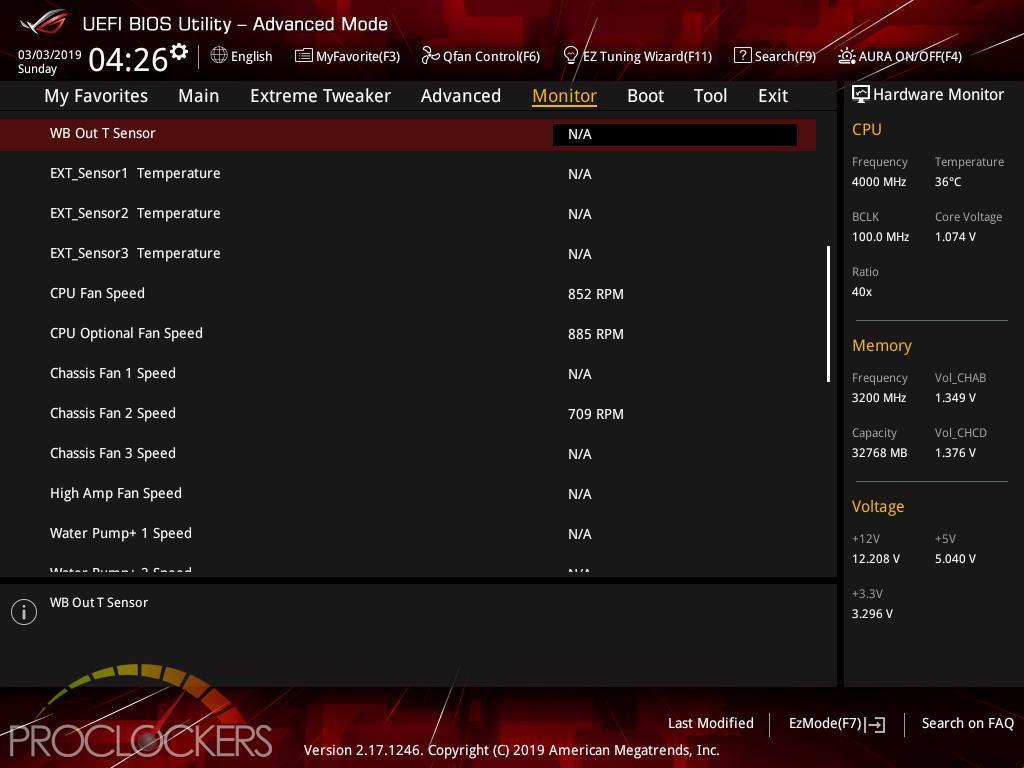
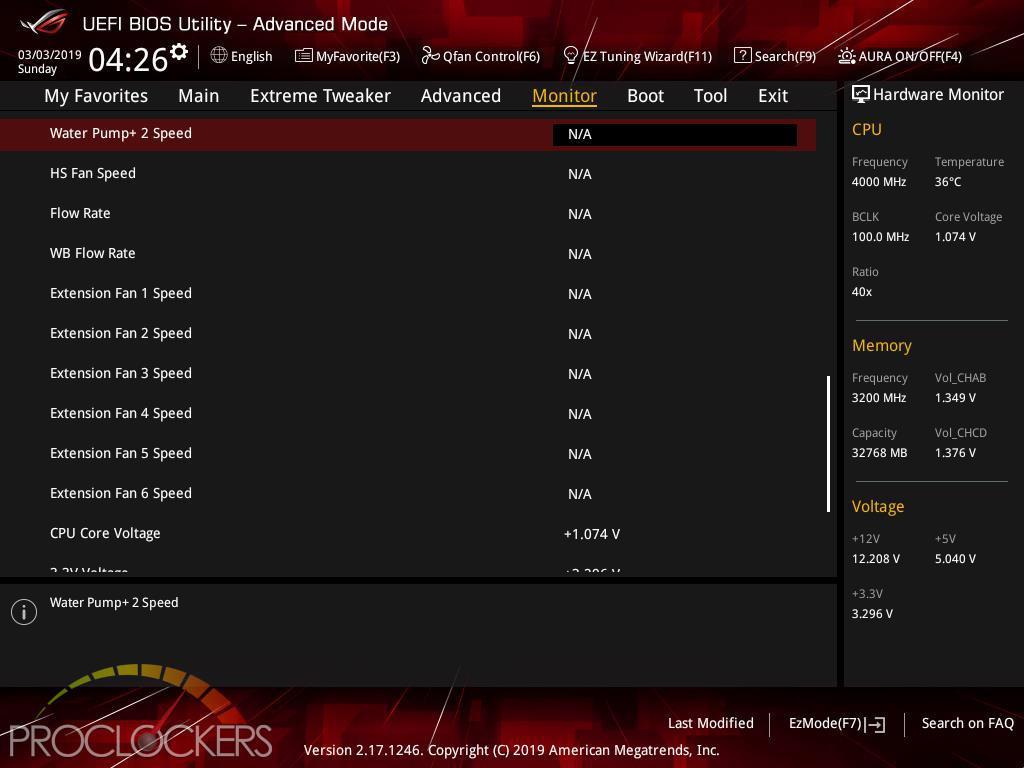
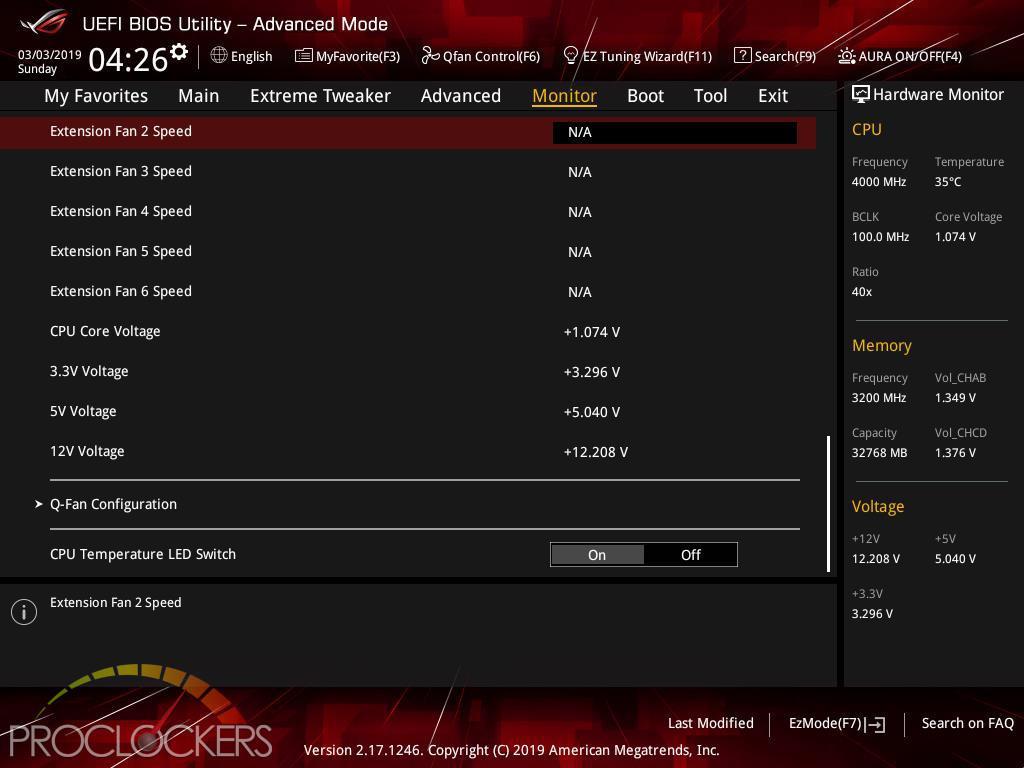
The Monitor tab is where you get track of the physical attributes of the board. Temps, fan speeds, voltages, flow rates, and everything connected to all those temp probes and fan headers can be monitored from here, as well as controlled where applicable.
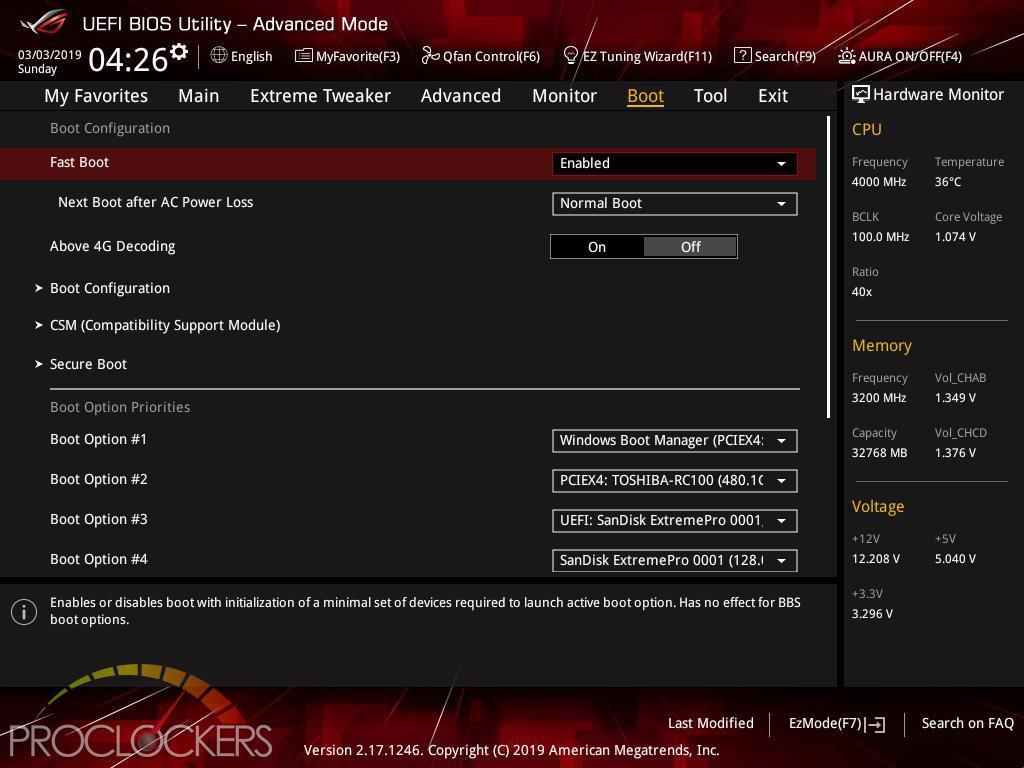
The Boot page is pretty self-explanatory. This is where you control everything related to booting from Boot order, and Fast Boot, to enabling the Compatibility Support Module.
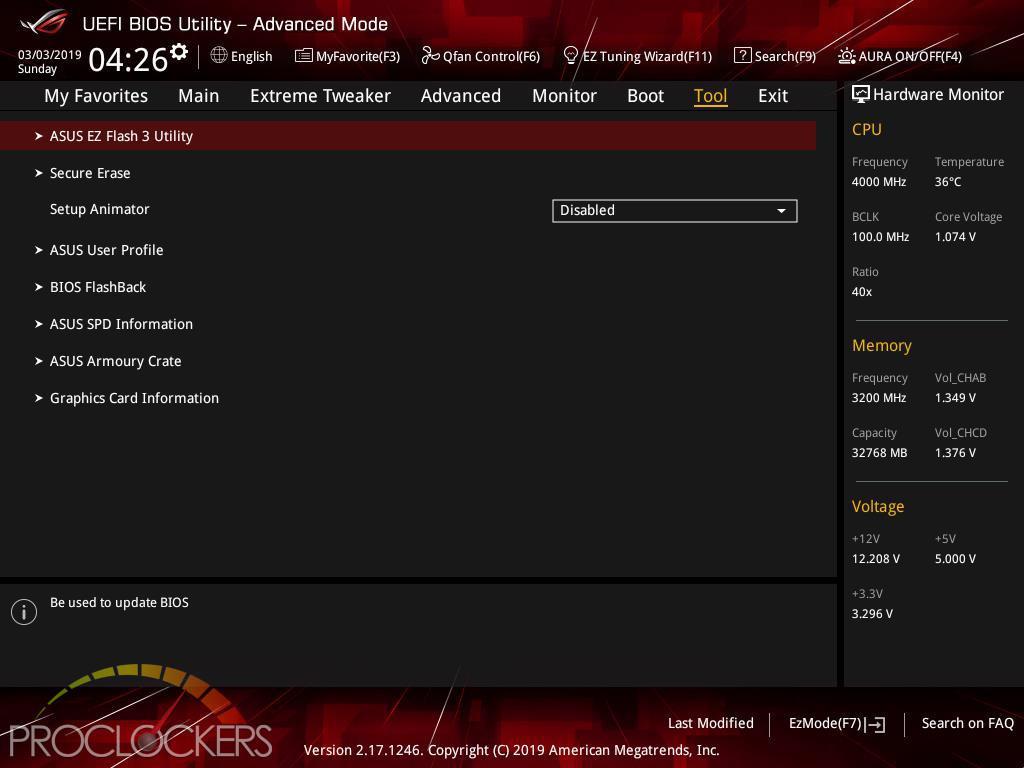
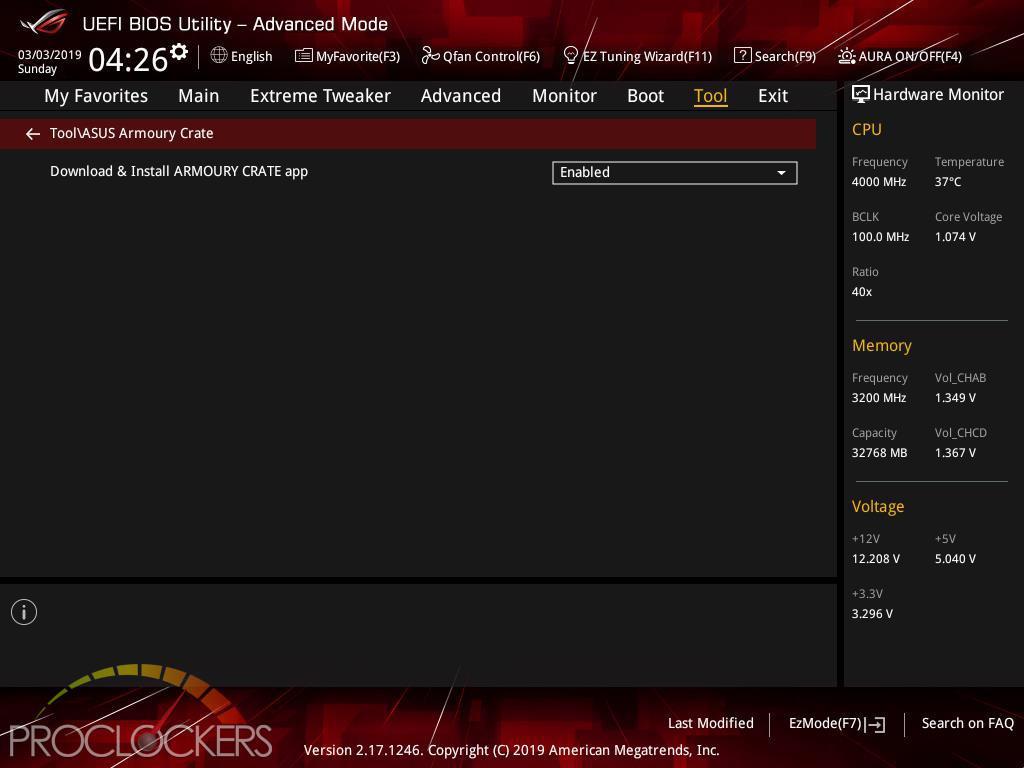

The Tools Menu is full of useful things and is one of our very first stops. The EZ Flash tool can be found here and out testing always includes updating to the very latest BIOS. Checking out your memory and GPU are also handy.
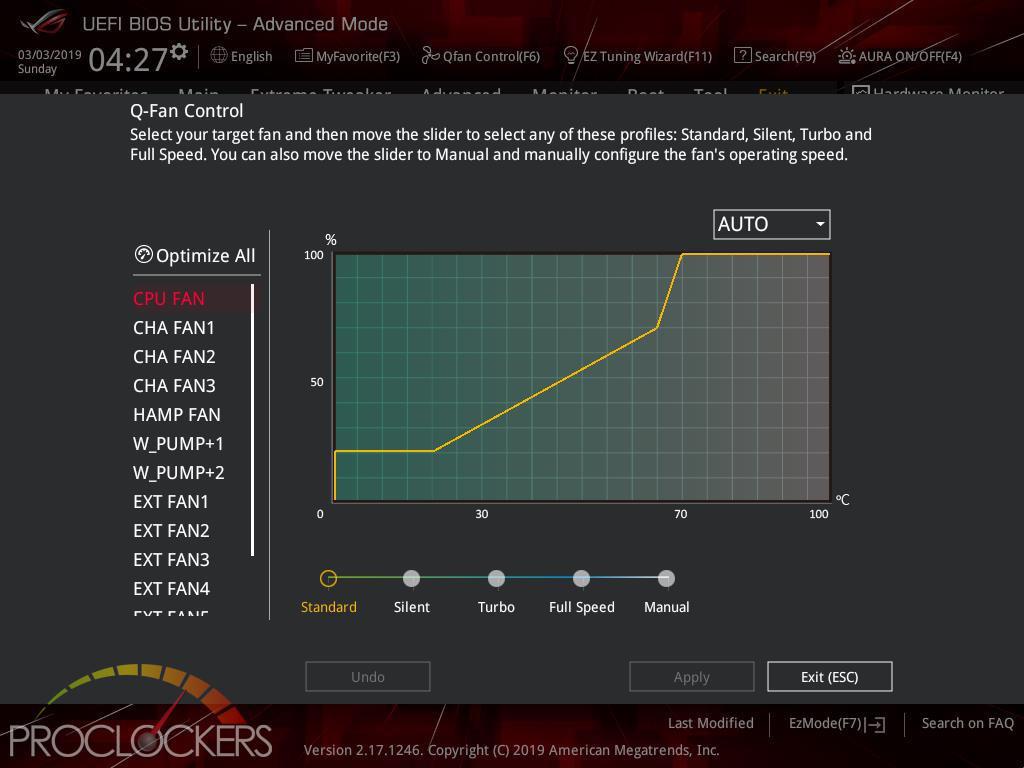
Q-Fan control is a great way to make sure all of your fans and pumps are perfectly tuned for your particular setup. If this is a bit overwhelming, just hit the ‘Optimize All’ button and let ASUS figure it out for you.
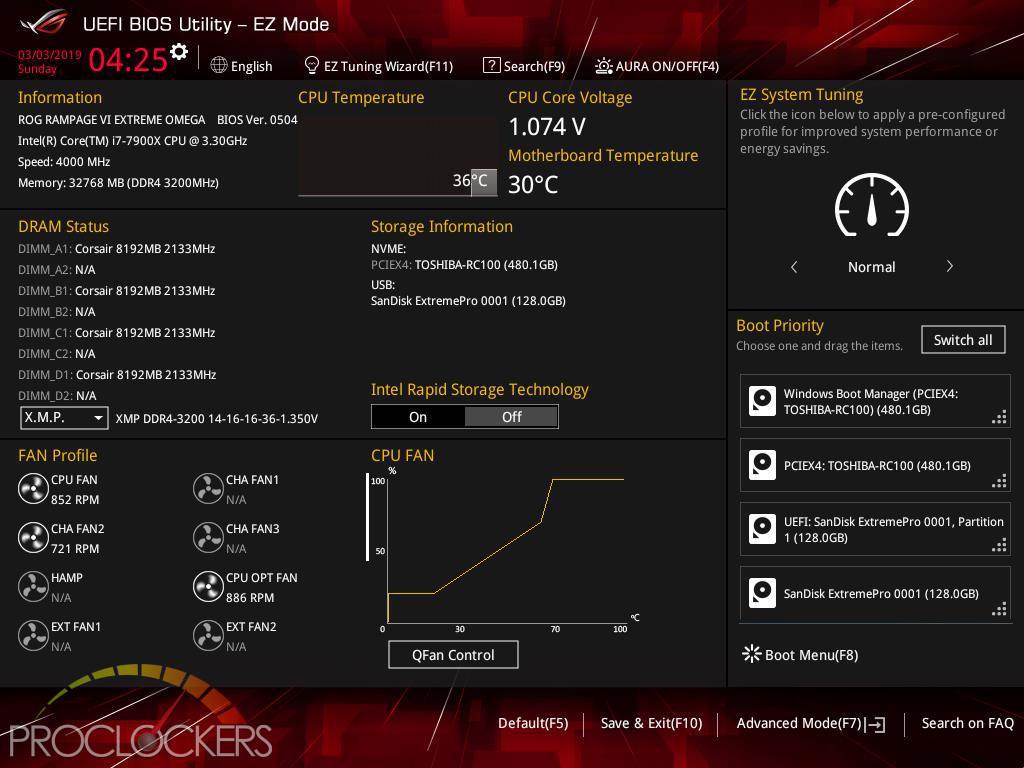
And lastly, if you just don’t need all of the options, Hitting F7 will bring you to EZMode. A single page with all the info and settings you need to just get going in a few clicks.
Software
ARMOURY CRATE
The brand-new Armoury Crate portal keeps you updated with the latest drivers and BIOS releases. Its easy-to-use UI can be configured to show a variety of information, including security updates, bug patches, the latest ROG news, gaming events, and special offers.
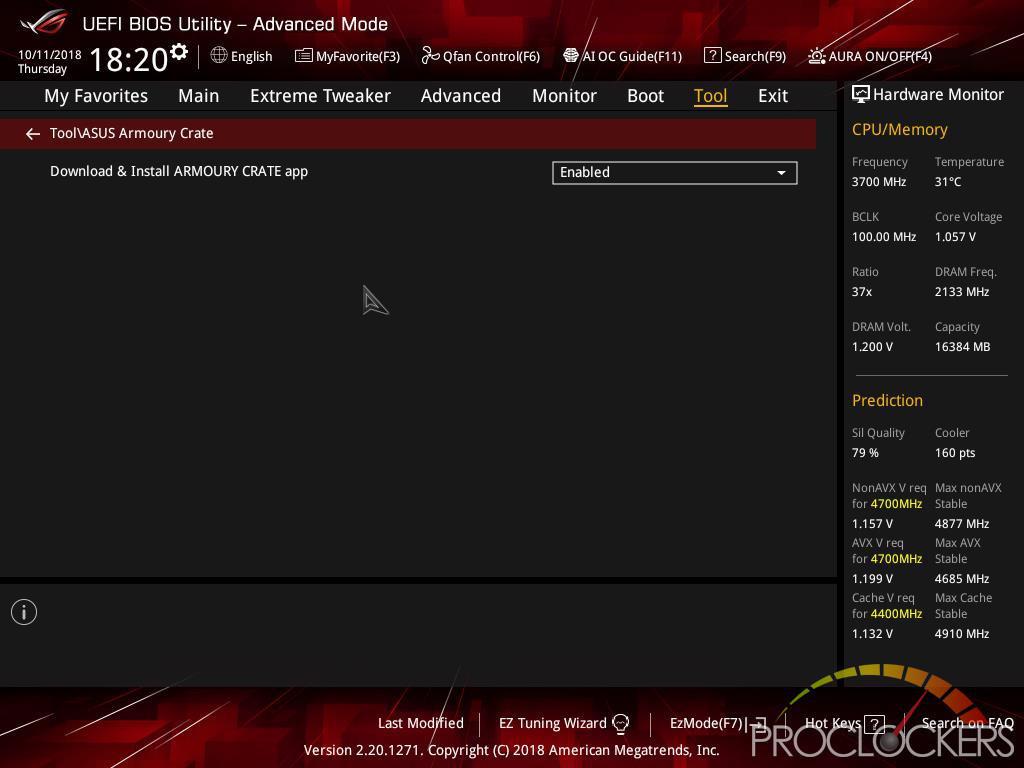
Armoury Crate needs to first be enabled in BIOS but is on by default.

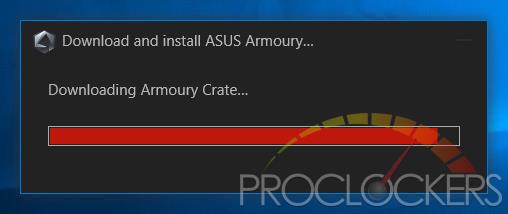
The first time you hit Windows, you get the following message. It’s a bit all or nothing, but it does install LAN drivers almost instantly when you click Install and as soon as it establishes a network connection, starts downloading Armoury Crate. We wish you could install JUST the LAN drivers.

Once the installation is done, you are greeted with the usual EULA.
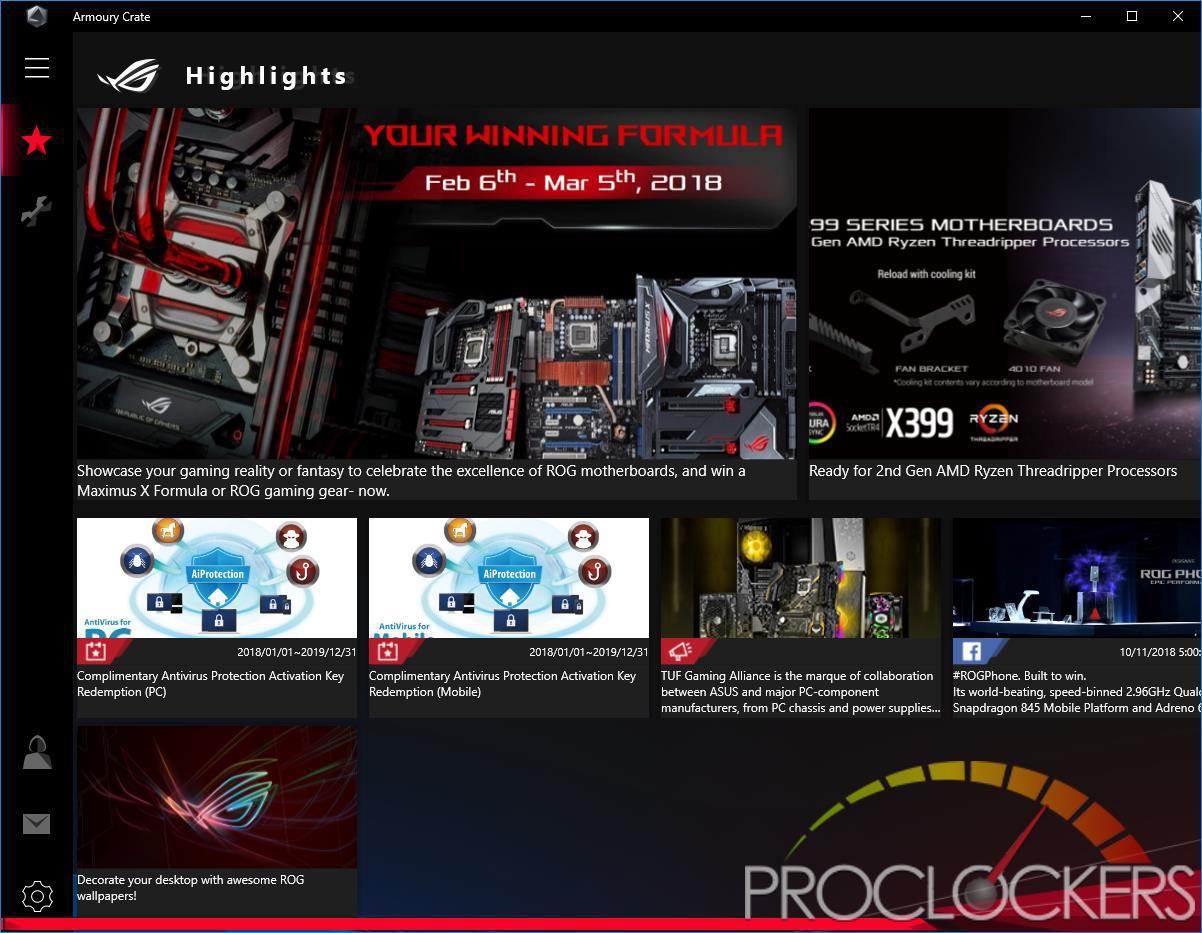
The landing page gives you ROG news and lots of other information.
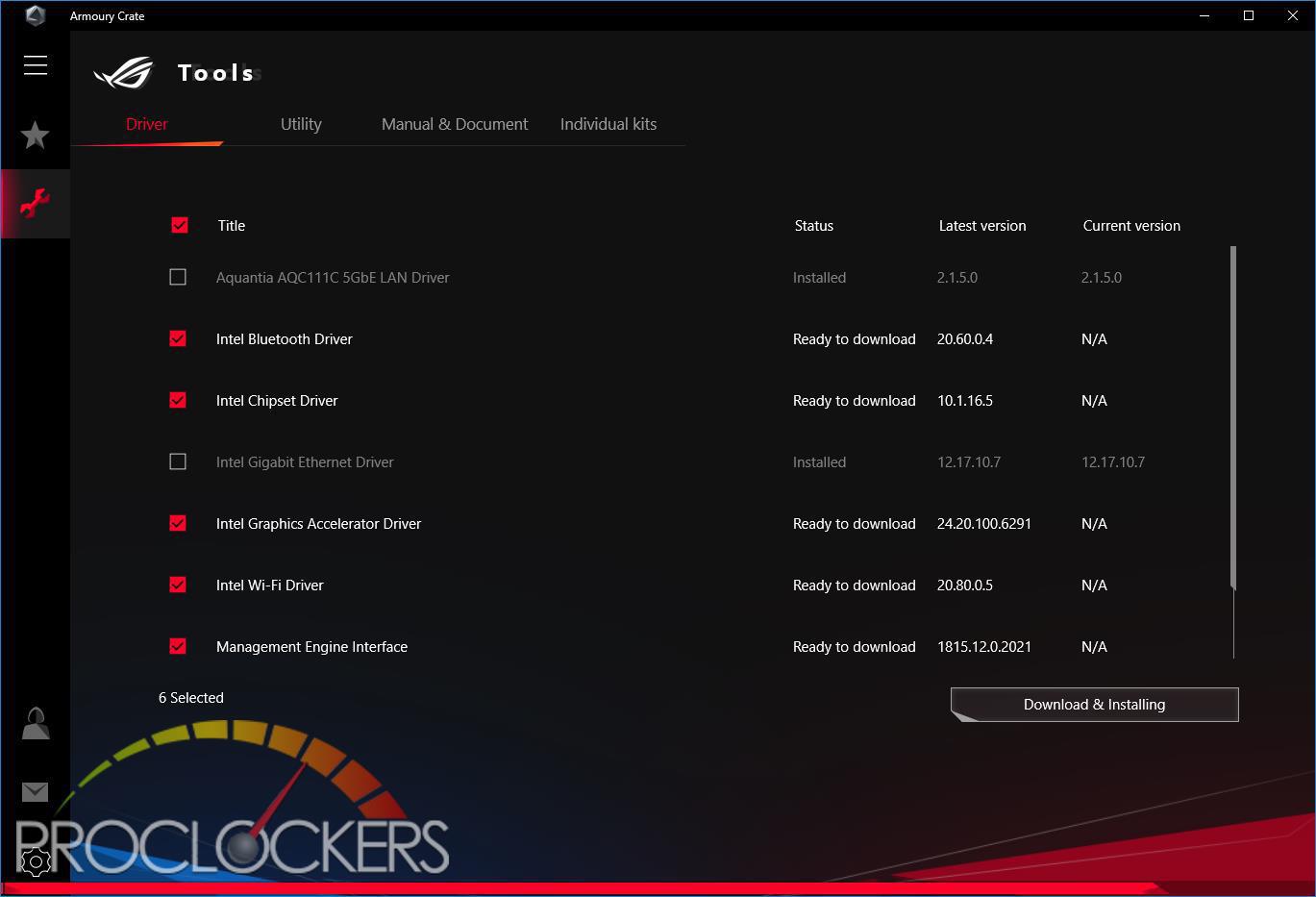
Hitting the wrench icon lets you install all missing drivers and utilities.

This part is just a waiting game for everything to download and install. But that’s it, you get fully set up and ready to run the system in a few clicks.
ASUS AURA

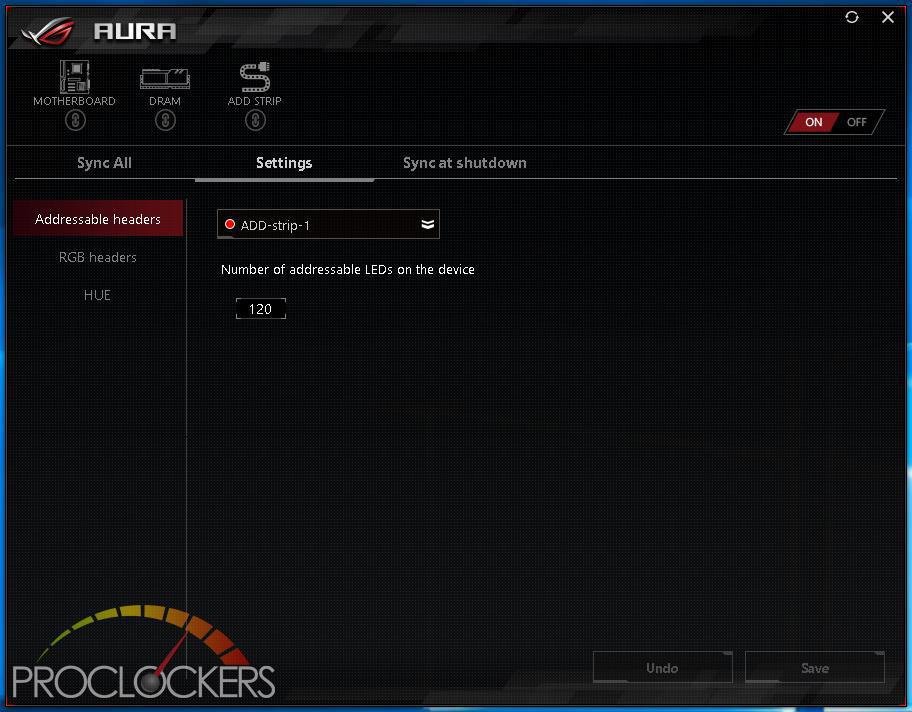
The Rear I/O Area lighting, as well as all analog RGB and Digital RGB headers, are controlled by ASUS’s AURA software on the Extreme. There are quite a few effects to choose from, both static and dynamic, but our favorite was the Flash and Dance, as well as the Temperature mode.
Game First V
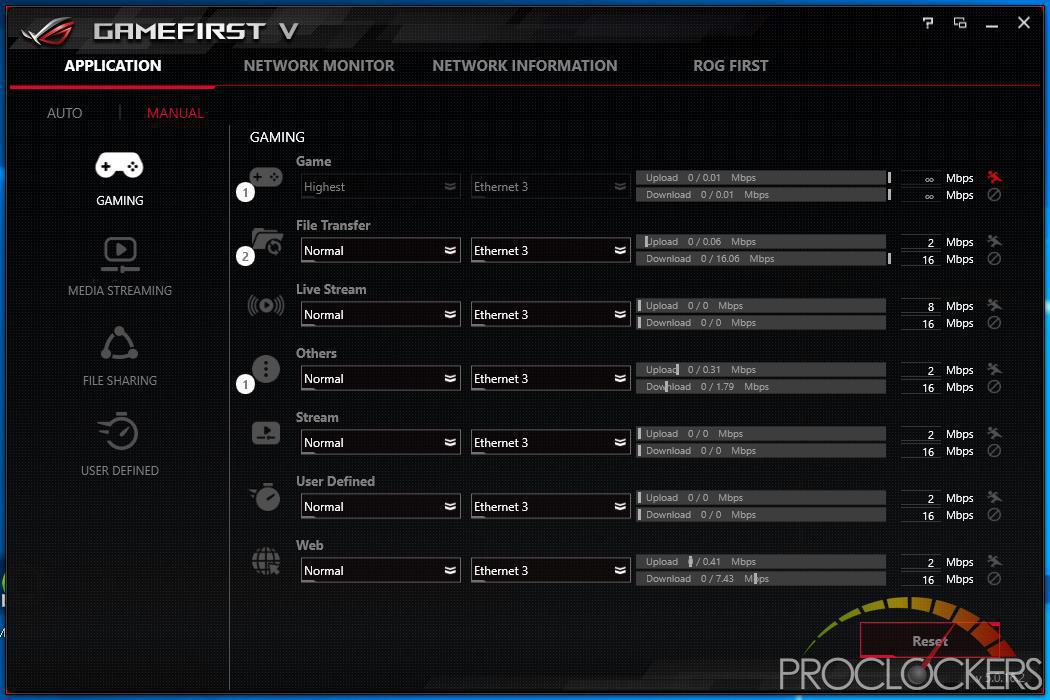
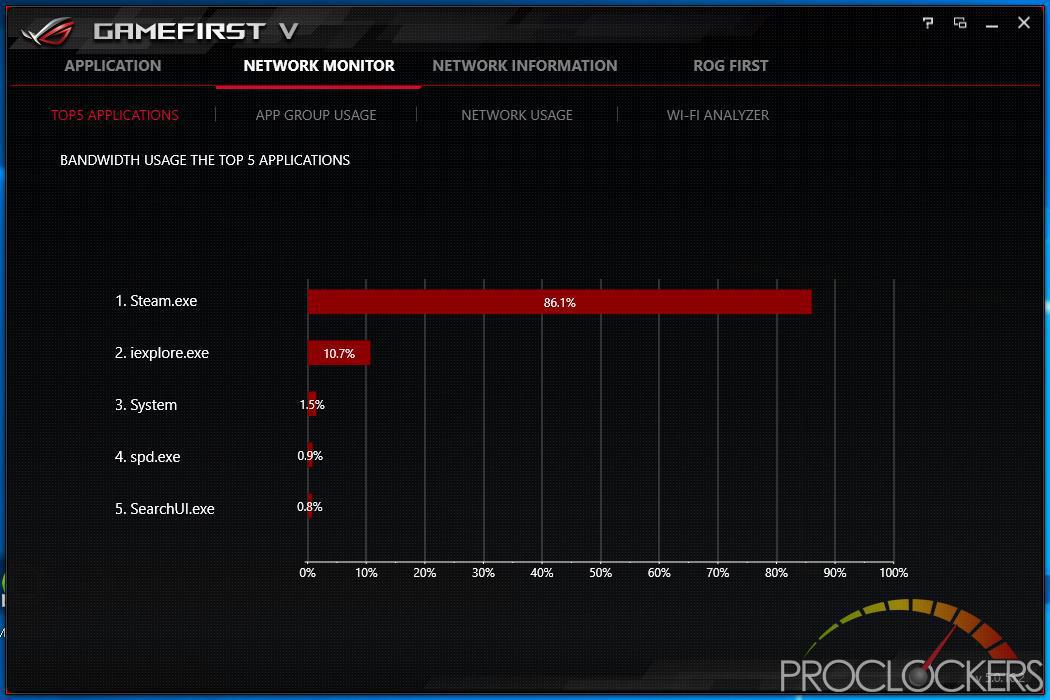
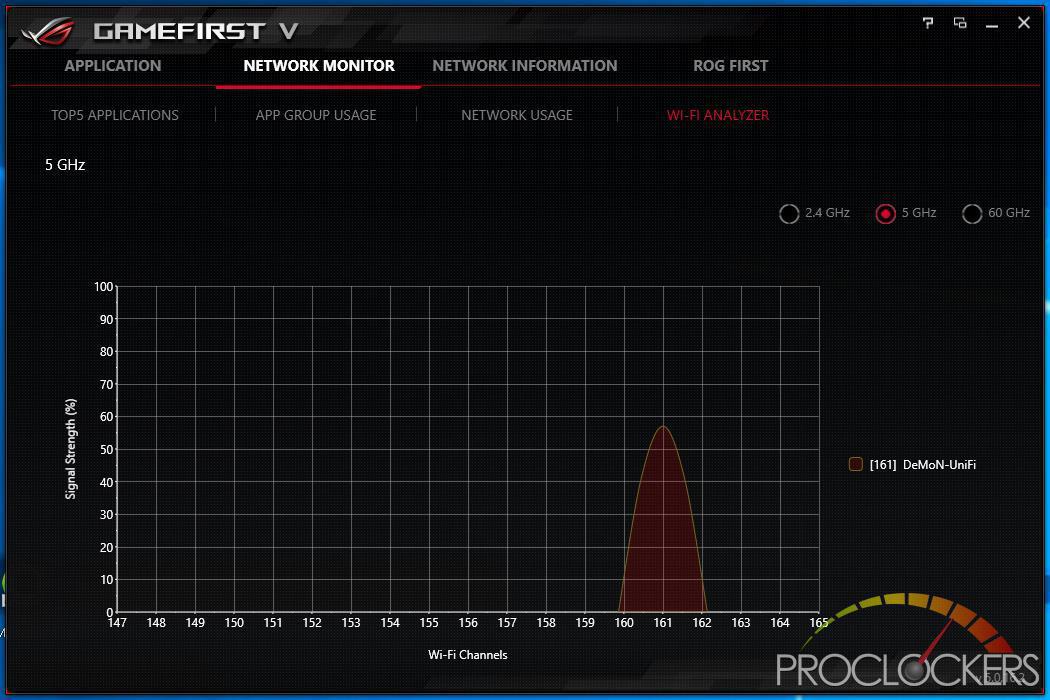
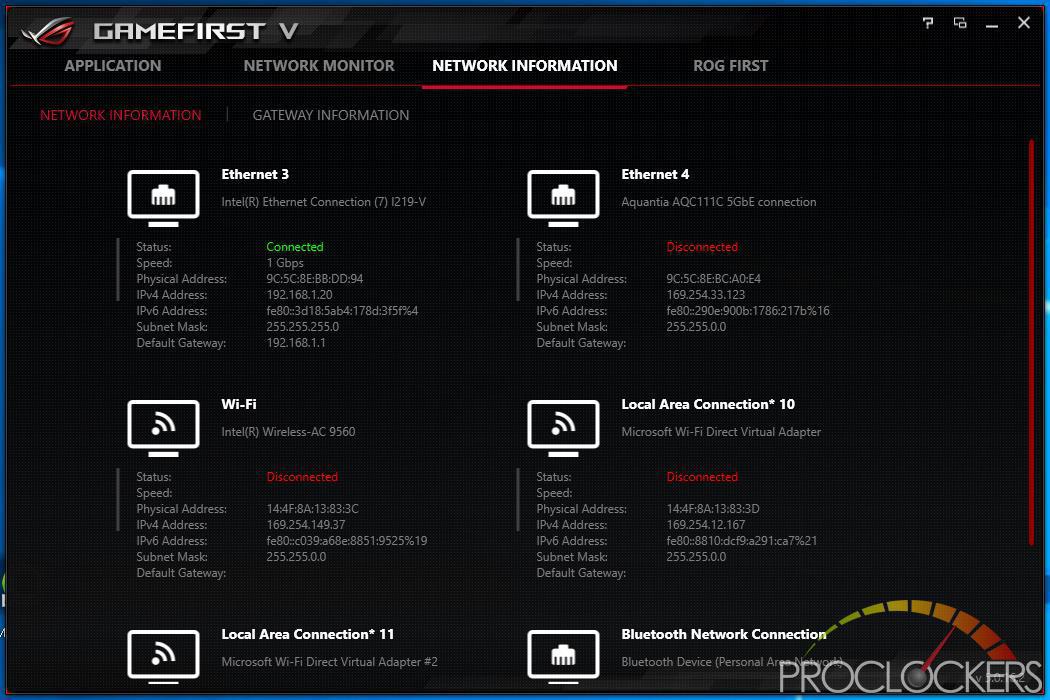
The GameFirst IV Application allows you to Monitor and control all traffic over all three LAN connections, as well as see statistics and vital information. By Default, the application runs in intelligent mode and will prioritize Traffic based on its purpose, but you can switch to Manual mode and take over full control. You can see here while browsing the web and installing games on Steam for benchmarking where most of the bandwidth is being used. You can also see what wireless networks are on each frequency so you can avoid them.
Dual Intelligent Processors 5
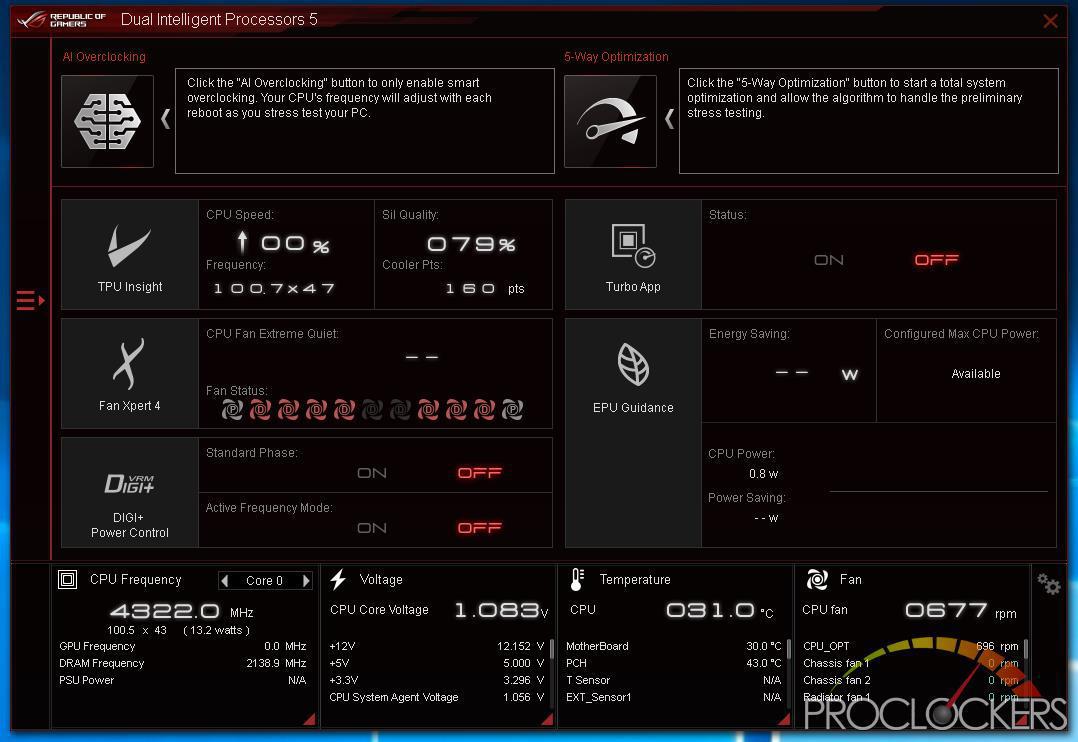
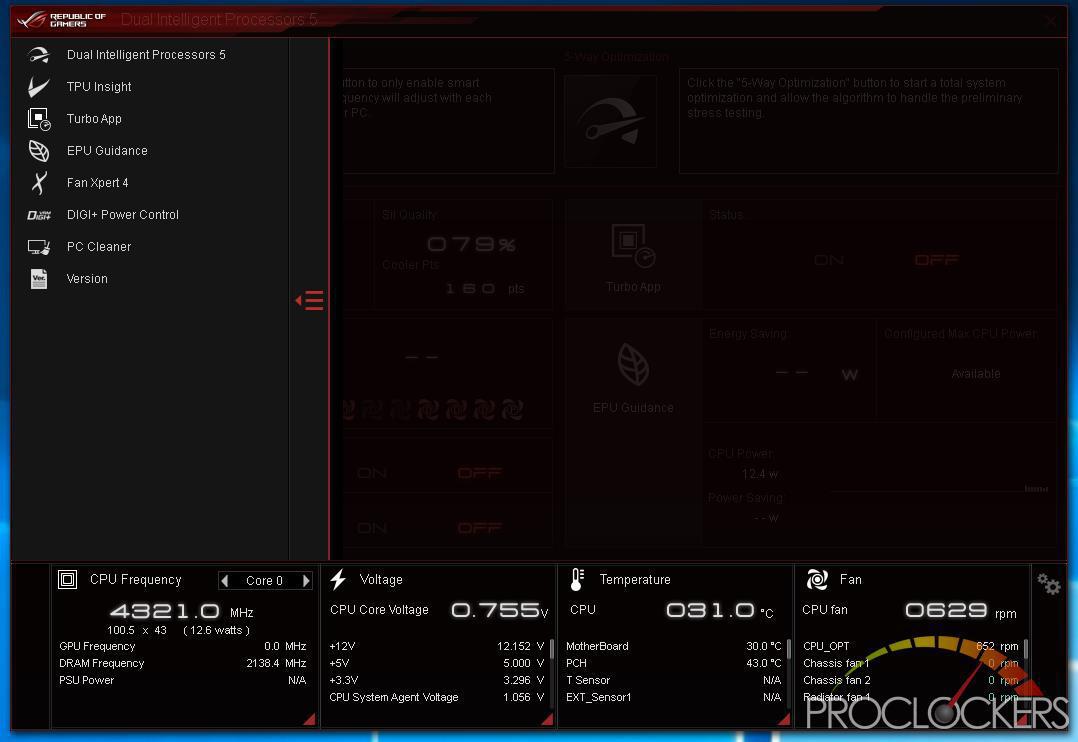
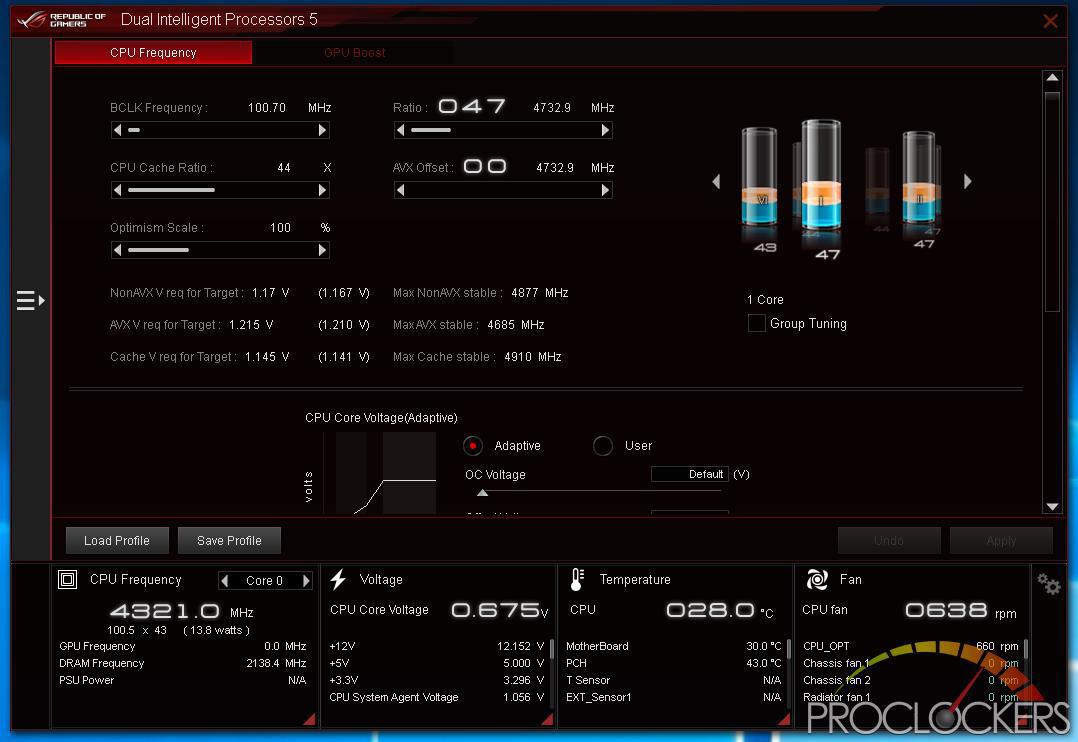
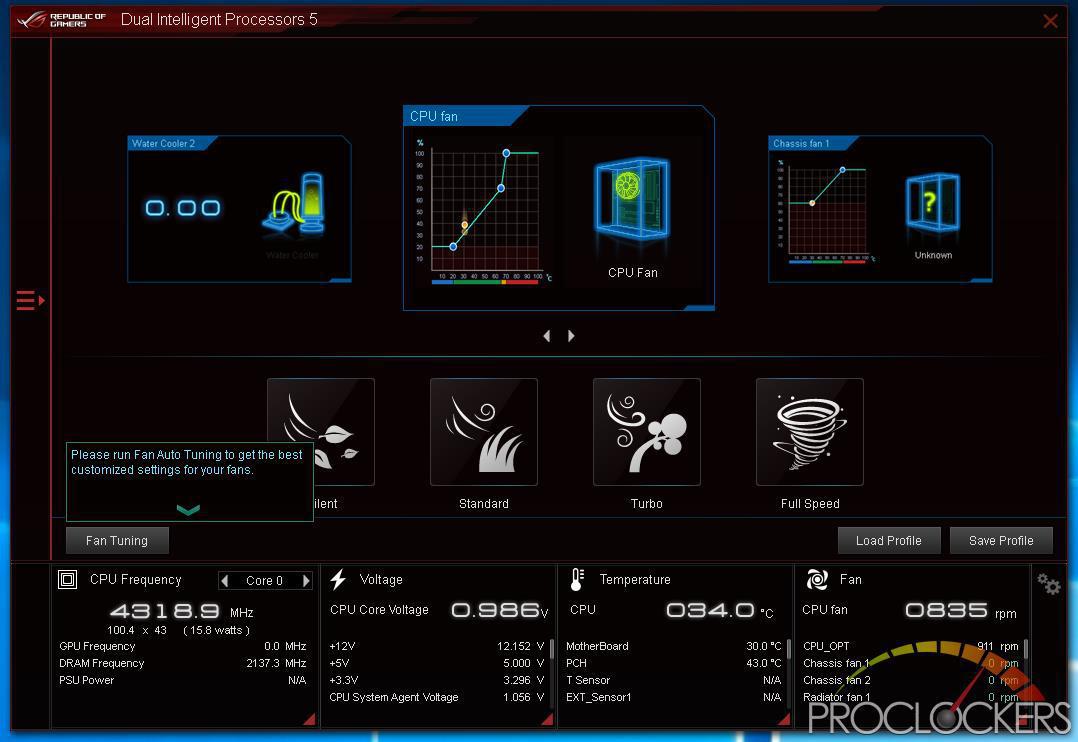
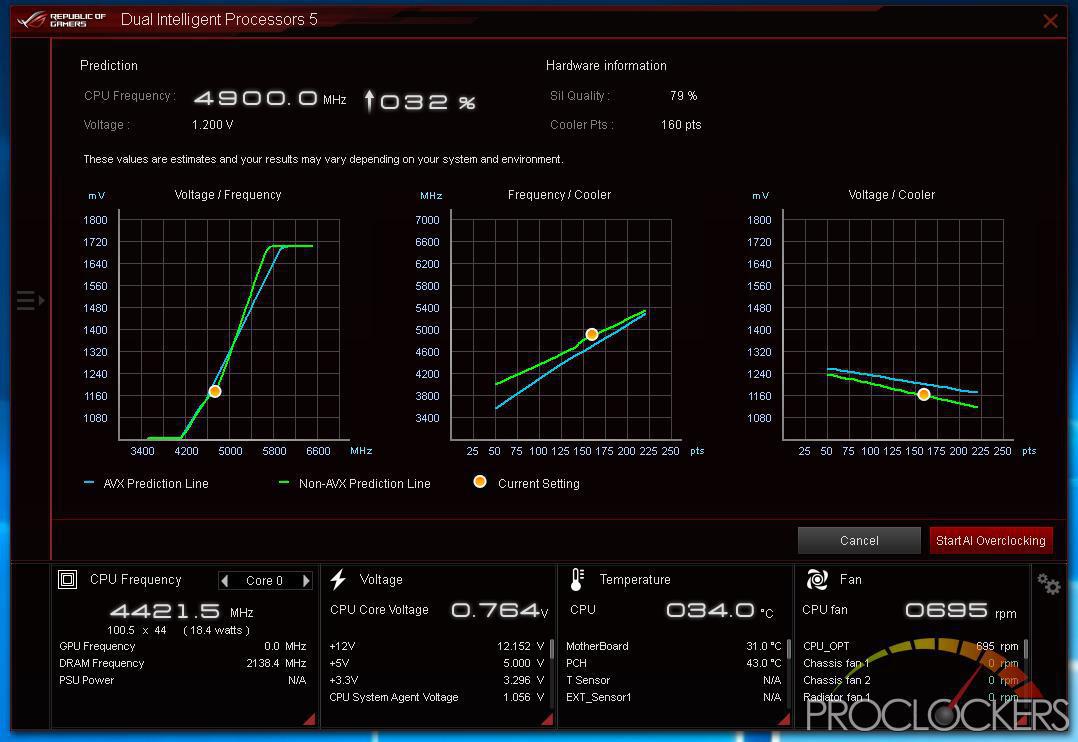
ASUS’s Dual Intelligent Processors 5 application is a powerhouse and one you don’t want to miss. Anything related to optimizing performance can be found here, from switching profiles to Auto overclocking to manual overclocking and change voltages and fan settings are here. You can even clean out temp and other unneeded files in a few clicks all from one application.
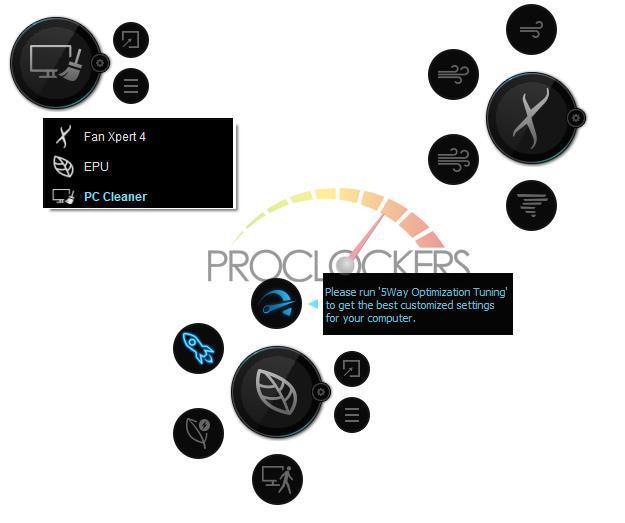
This application also runs similar to a desktop widget, gives you quick access to cooling, performance profiles and PC Cleaner without opening the full application.
Ram Cache
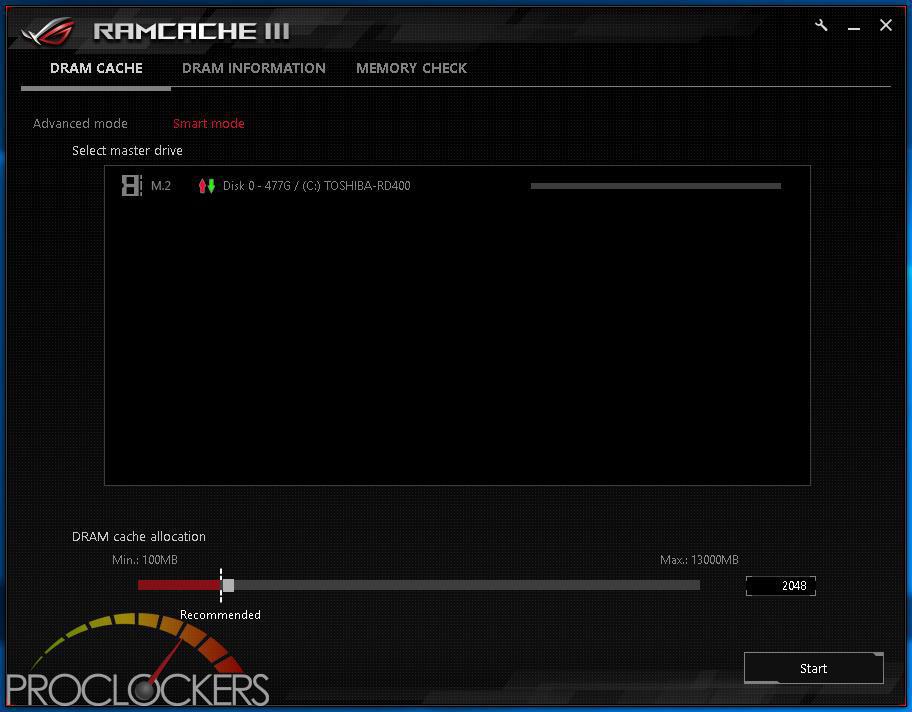
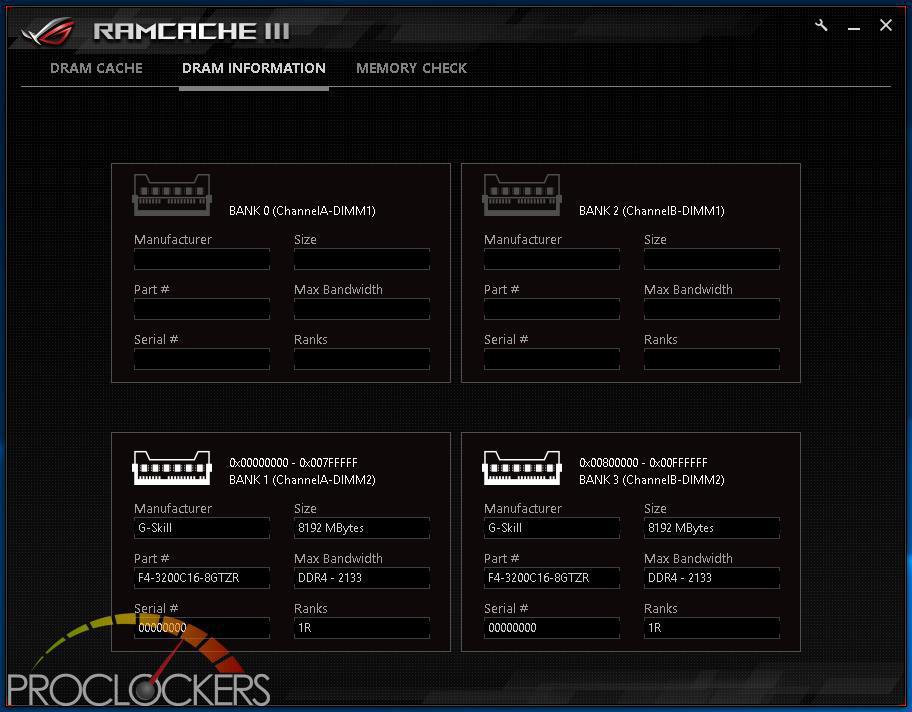
ASUS’s RAMCACHE II carves off a user selectable portion of system memory to speed up Disk transfers. Even if you have the fastest NVMe drive out there, using your ram as a cache can speed it up significantly.
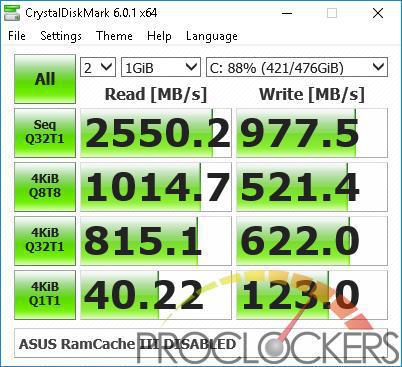
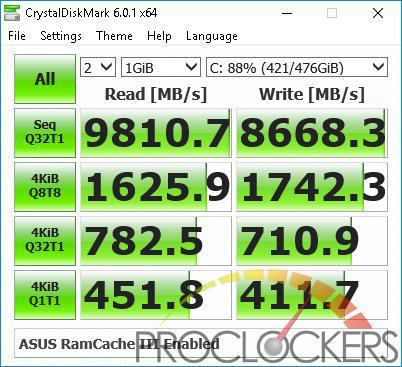
As you can see, it makes a significant difference in speed and performance at the cost of a few gigabytes of otherwise unused ram.
Mem TweakIt
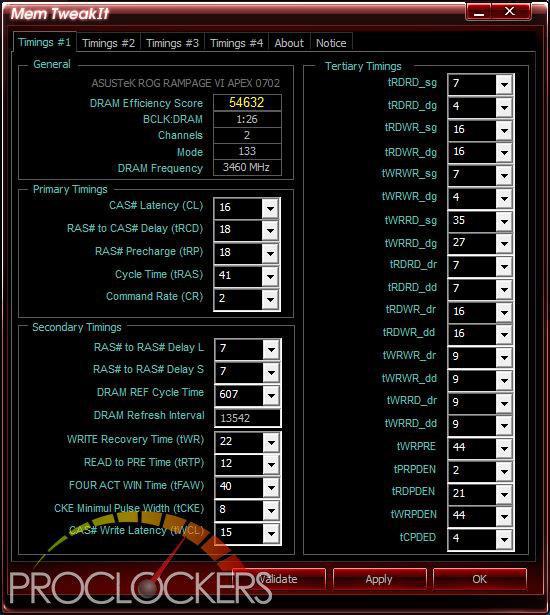

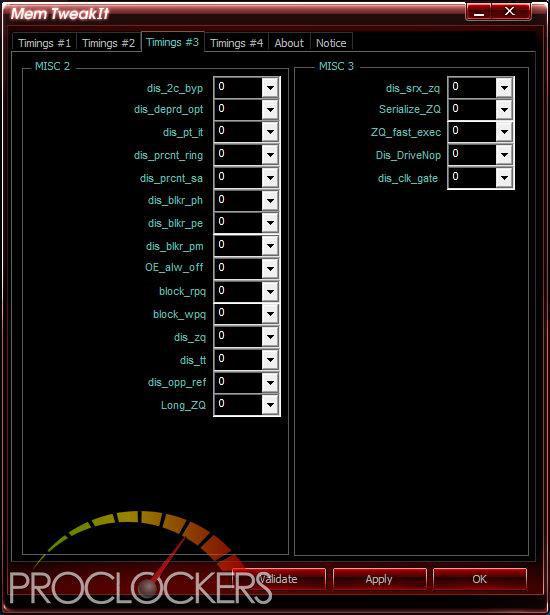
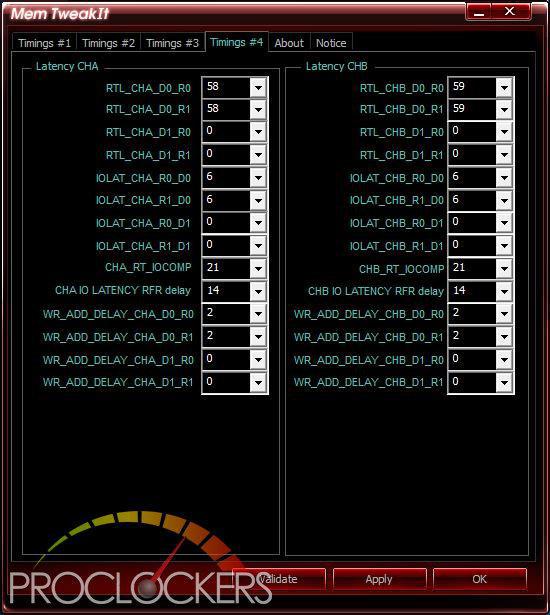
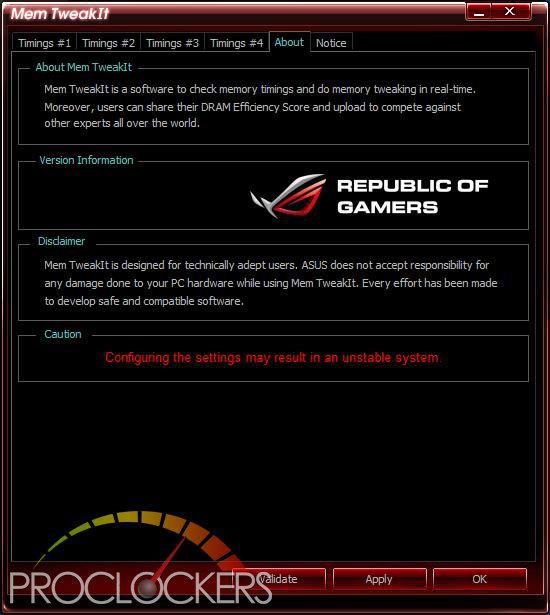
One Thing in the overclocking world that is a pain is overclocking your memory. For the most part, any change requires a reboot to BIOS. With ASUS’s MEM TweakIT, that isn’t the case. Almost everything can be adjusted live right from your desktop.
Overwolf
Overwolf is a clever, unobtrusive overlay that keeps you in the game and allows you to browse the Web, email, IM, stream or record while you play. The overlay features color-matched ROG skins that show you’re part of an elite pack. Grab it now from the Overwolf Appstore!
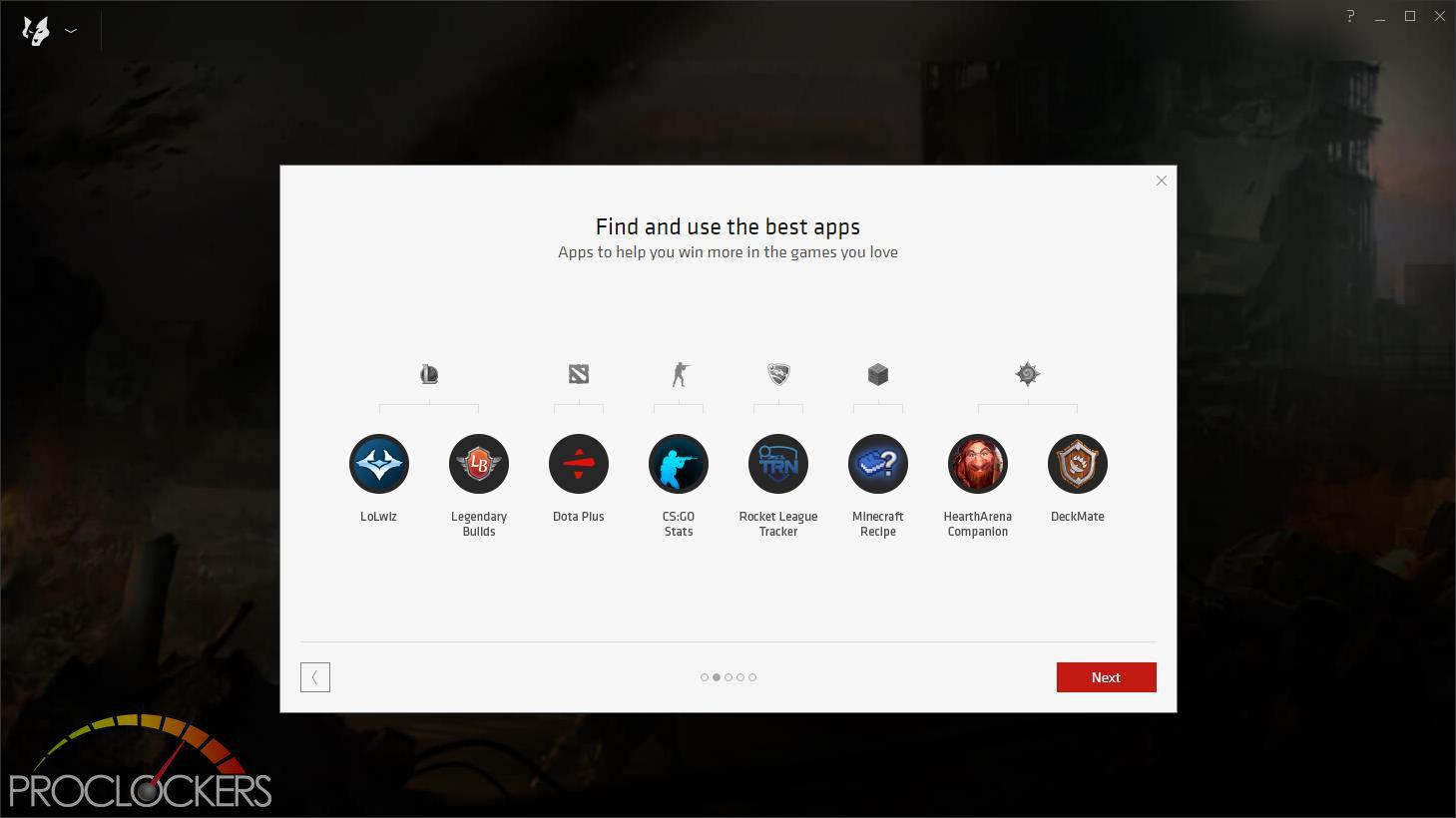
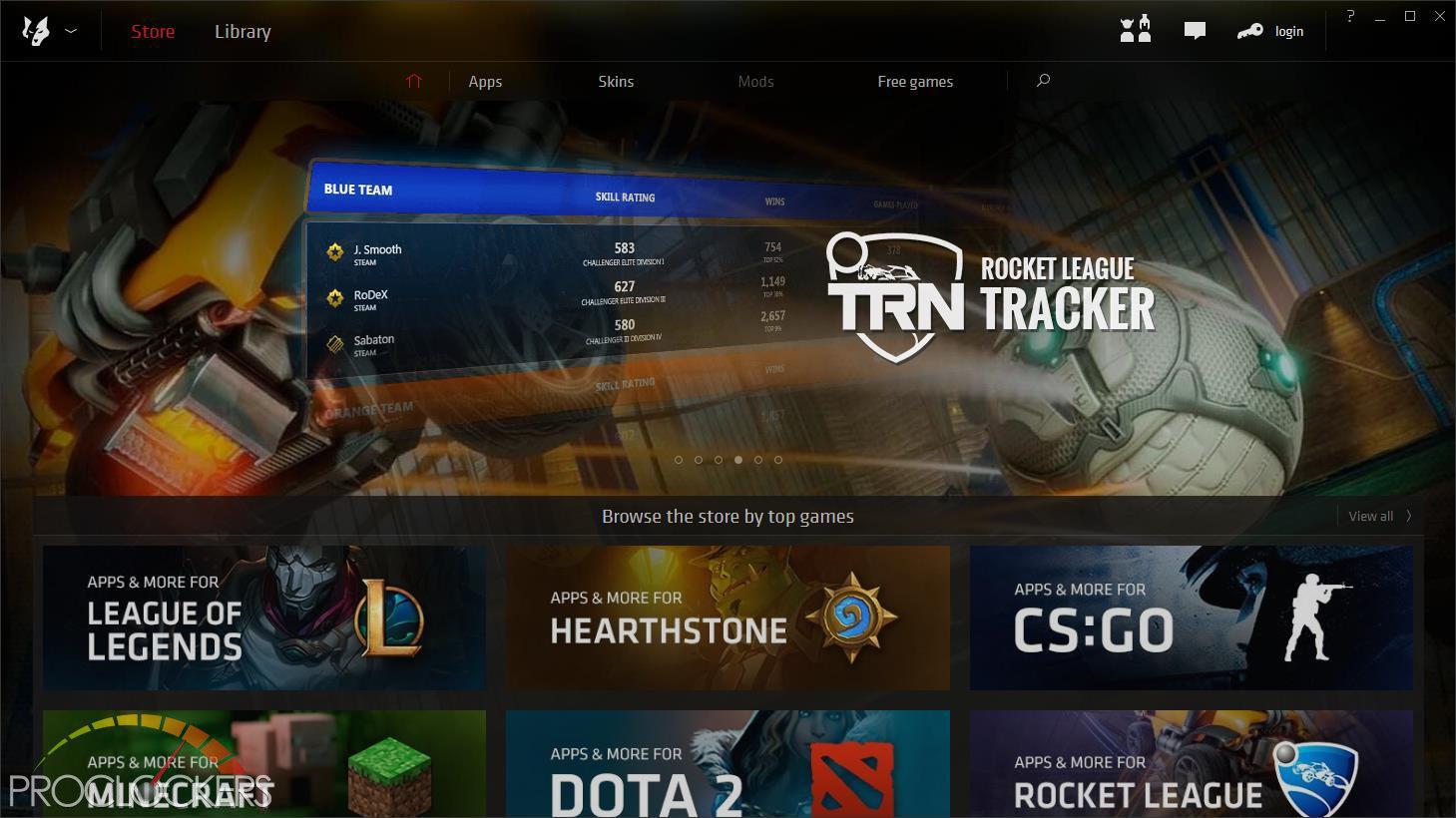
Overwolf provides access to lots of tools for many popular games, as well as some handy utilities for streaming and online play.
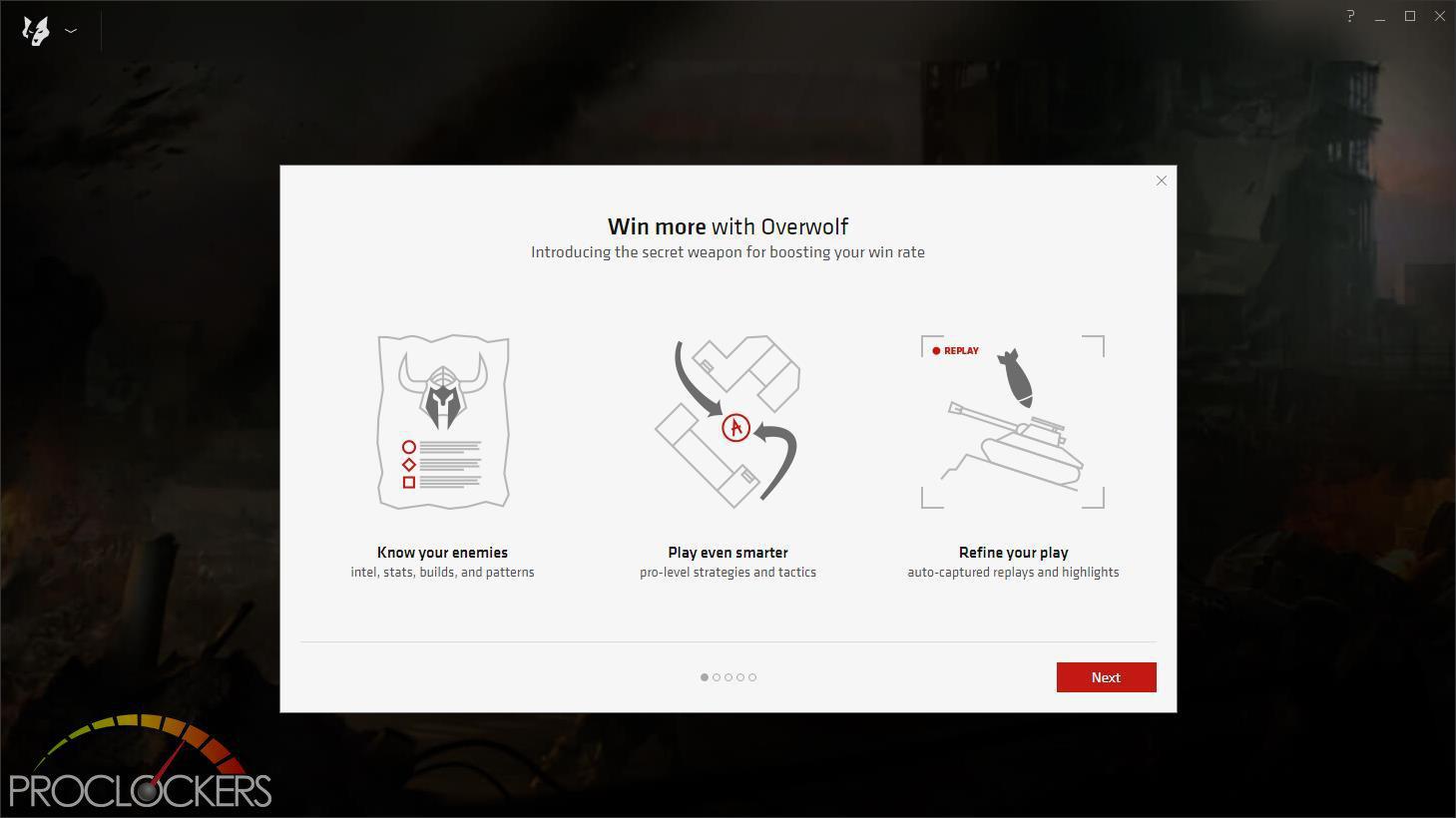
Overwolf also comes with a small desktop widget similar to Dual Intelligent Processors 5.

ASUS Live Dash
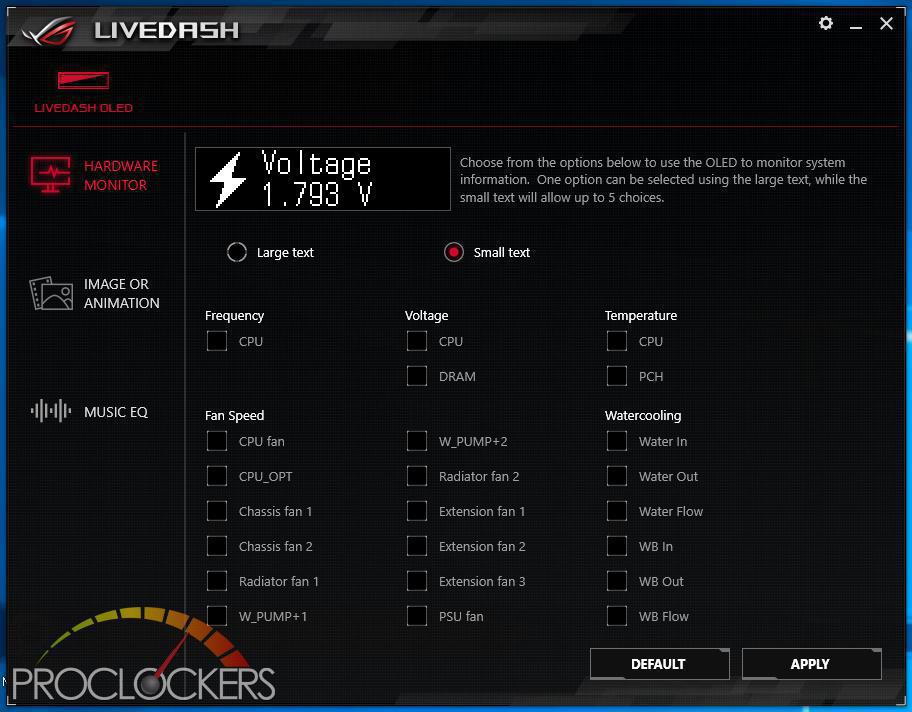
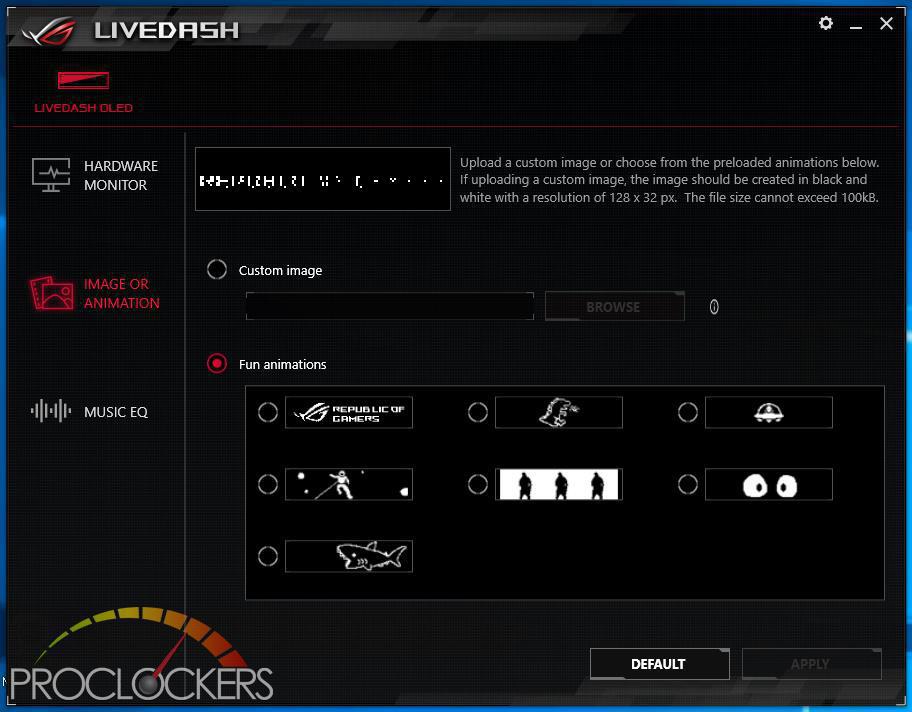
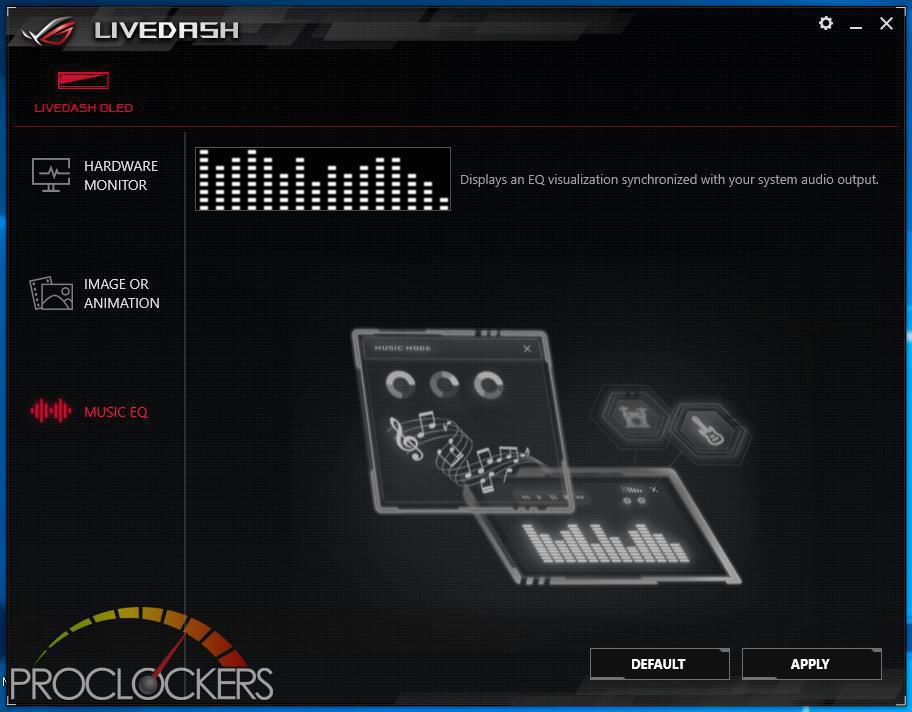
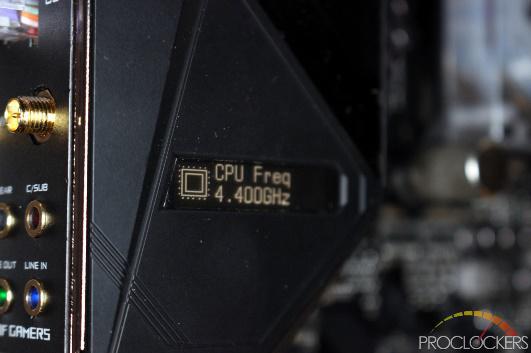
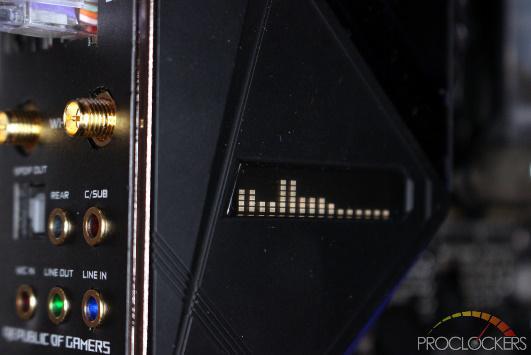
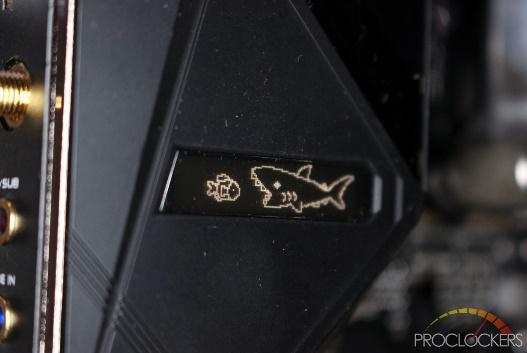
ASUS Live Dash is where you control the small LCD on the rear I/O cover. You can display information, static images and even animated GIF images of your choosing.
Sonic Radar
Sonic Radar is an onscreen overlay that visually represents sound activities according to their positional location. It is designed as a gaming aid for pro/am gamers, those hard of hearing or unable to use in-game audio clearly. It does not interfere with game files, nor does it represent anything more than the game engine produces.

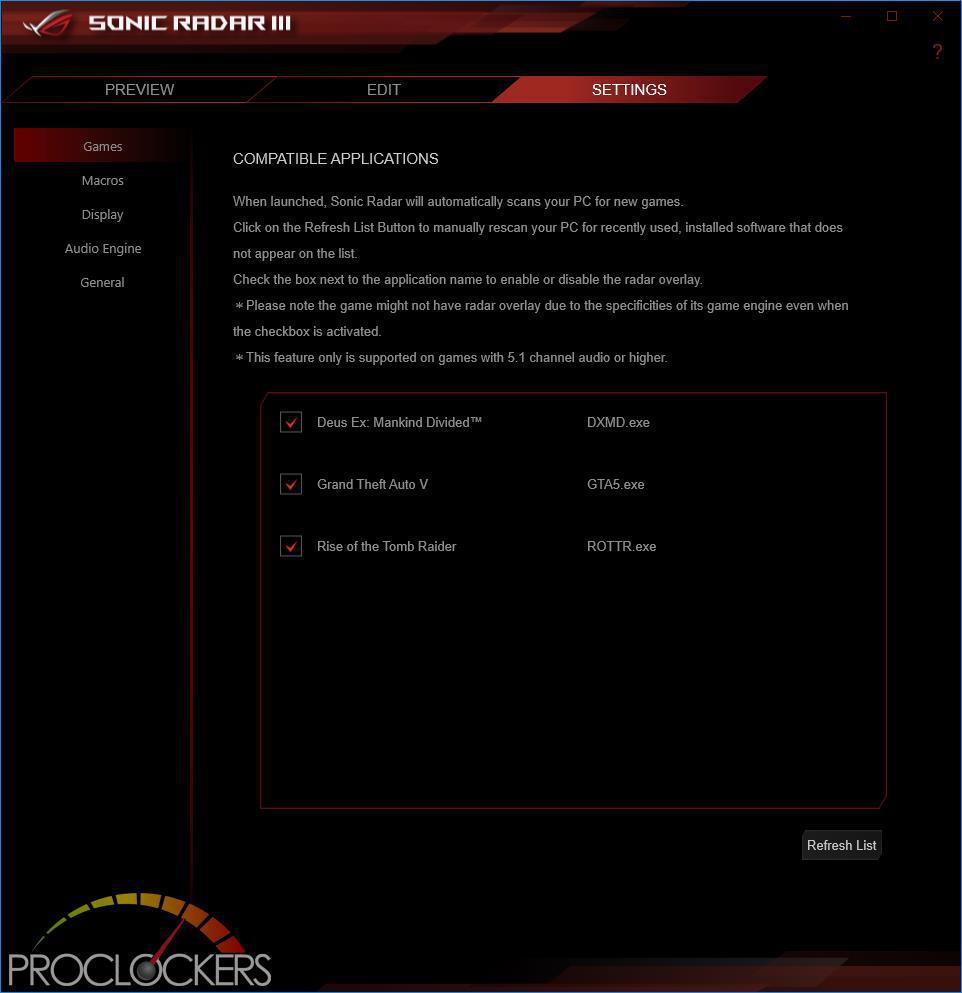
Sonic Studio III
The latest feature in Sonic Studio III is the Ultimate Control Center for dorm room audio. The mapping of different audio streams to different output allows audio to be effectively compartmentalized so that it’s easy to share with friends or keep to yourself.
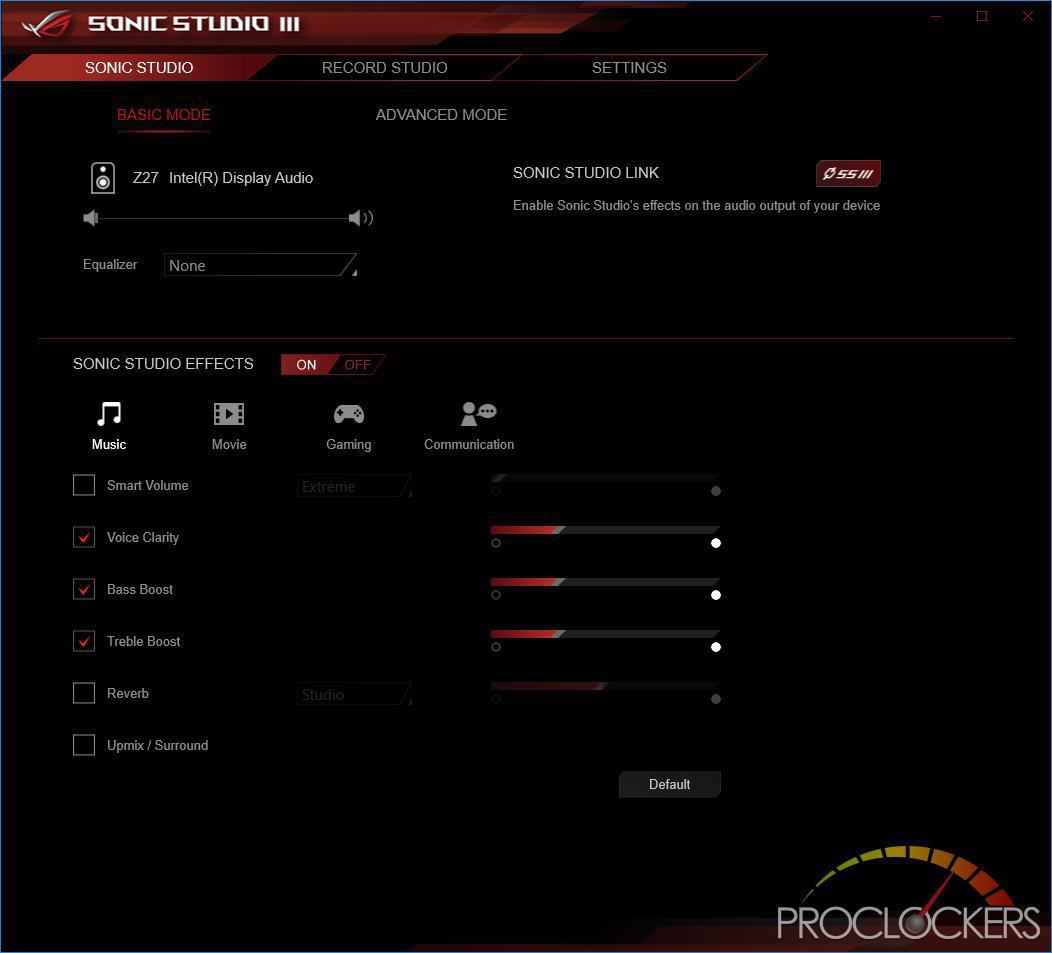

Performance & Testing
General Performance Testing
All performance testing was done with an i9-7900X and RTX 2080 at default clock speed. CPU was left with Speed Step and Turbo Boost enabled. The only setting changed was enabling XMP memory settings in the BIOS. Games were run at a resolution of 1920 x 1080 and higher settings enabled as noted. ASUS’s MCE was disabled.
PCMark 10
PCMark 10 is the complete benchmark for the modern office. It is the ideal test for organizations that are evaluating PCs for a workforce with a range of performance needs. The tests in this benchmark cover a wide range of activities from everyday productivity tasks to demanding work with digital media content.
PCMark 10 uses a modular approach to build relevant benchmark tests around common end-user scenarios. A Test Group is a collection of workloads that share a common theme or purpose. There are four test groups in PCMark 10, we use three of them.
Essentials: covers the common, everyday ways that people use a PC. The workloads include Web Browsing, Video Conferencing, and App Start-up time.
Productivity: measures system performance with everyday office applications. This test group includes Spreadsheets and Writing workloads.
Digital Content Creation: This test group’s workload reflects the demands of working with digital content and media. The tests include Photo Editing, Video Editing, and Rendering and Visualization.
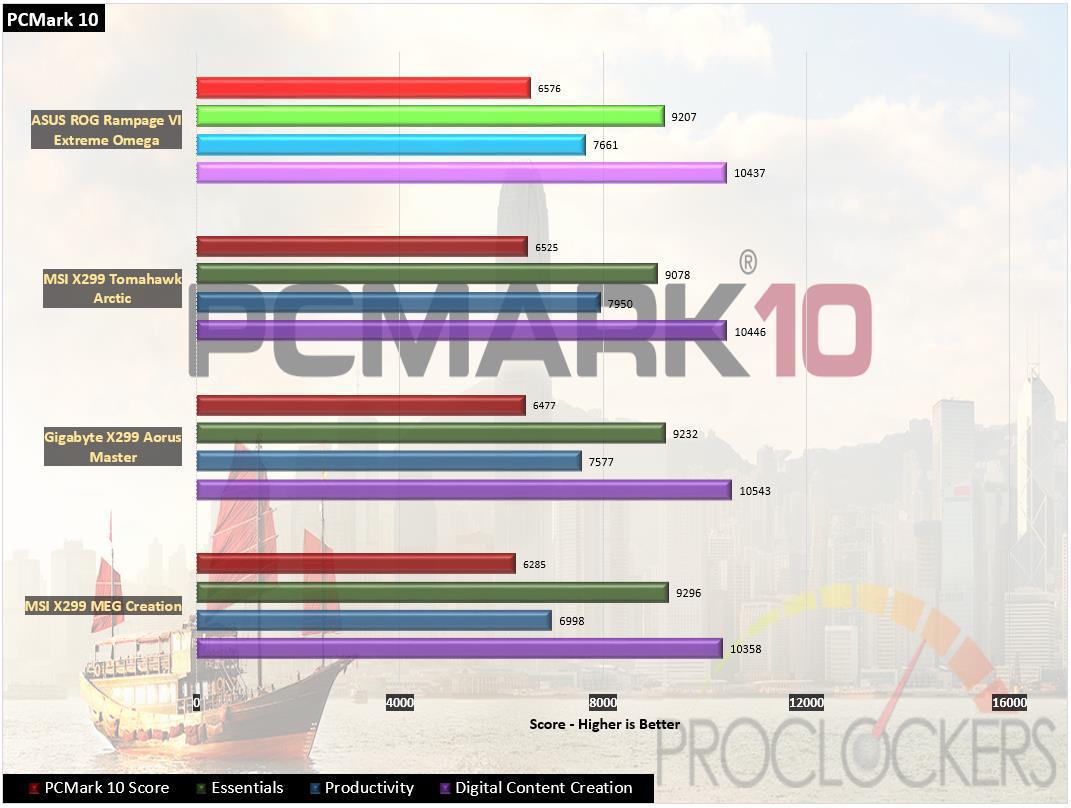
The Rampage VI Extreme Omega comes out of the gate ready to prove a point, scoring exceptionally well in PCMark 10’s complete system testing.
WebXPRT 2015
WebXPRT 2013 uses scenarios created to mirror the tasks you do every day to compare the performance of almost any Web-enabled device. It contains four HTML5- and JavaScript-based workloads: Photo Effects, Face Detect, Stocks Dashboard, and Offline Notes. WebXPRT is run with the latest stable release version of Google Chrome browser, in this case, Version 61.
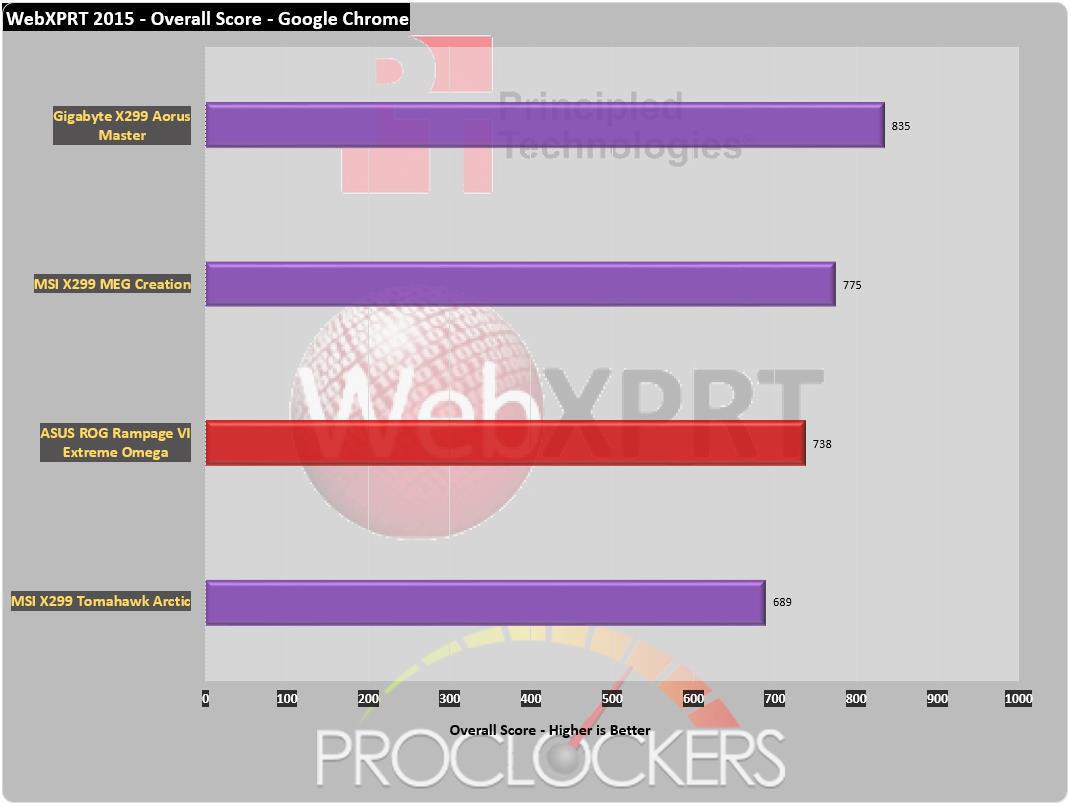
Our browser-based test comes in a little lower but still does well with a score of 738 +/- 15.
PassMark PerformanceTest 9
Fast, easy to use, PC speed testing and benchmarking. PassMark PerformanceTest allows you to objectively benchmark a PC using a variety of different speed tests and compare the results to other computers.
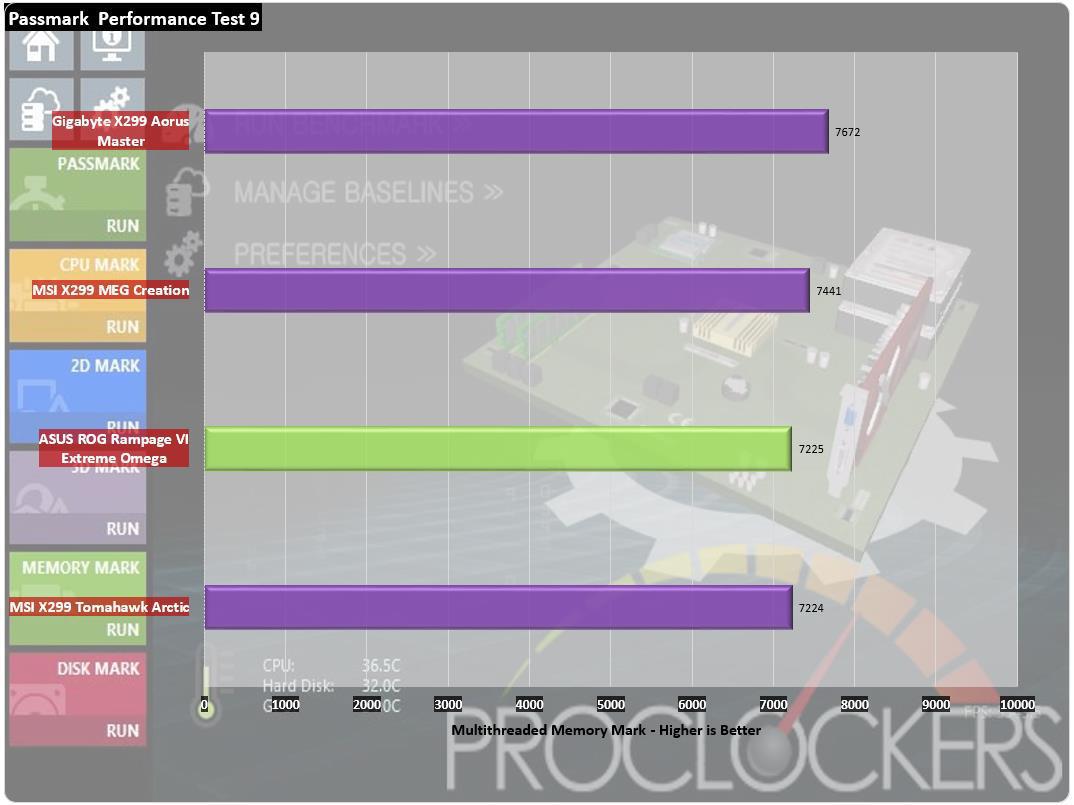
Passmark Performance Test 9 calculates a score of 7225 which puts it in 3rd place overall.
CPU Performance Testing
Super PI Modded 1.5
“In August 1995, the calculation of pi up to 4,294,960,000 decimal digits was succeeded by using a supercomputer at the University of Tokyo. The program was written by D.Takahashi in collaboration with Dr.Y.Kanada at the computer center. This record should be the current world record. (Details are shown in the windows help.) This record-breaking program was ported to personal computer environments such as Windows NT and Windows 95. In order to calculate 33.55 million digits, it takes 3 days with a Pentium 90 MHz, 40 MB main memory and 340 MB available storage.”
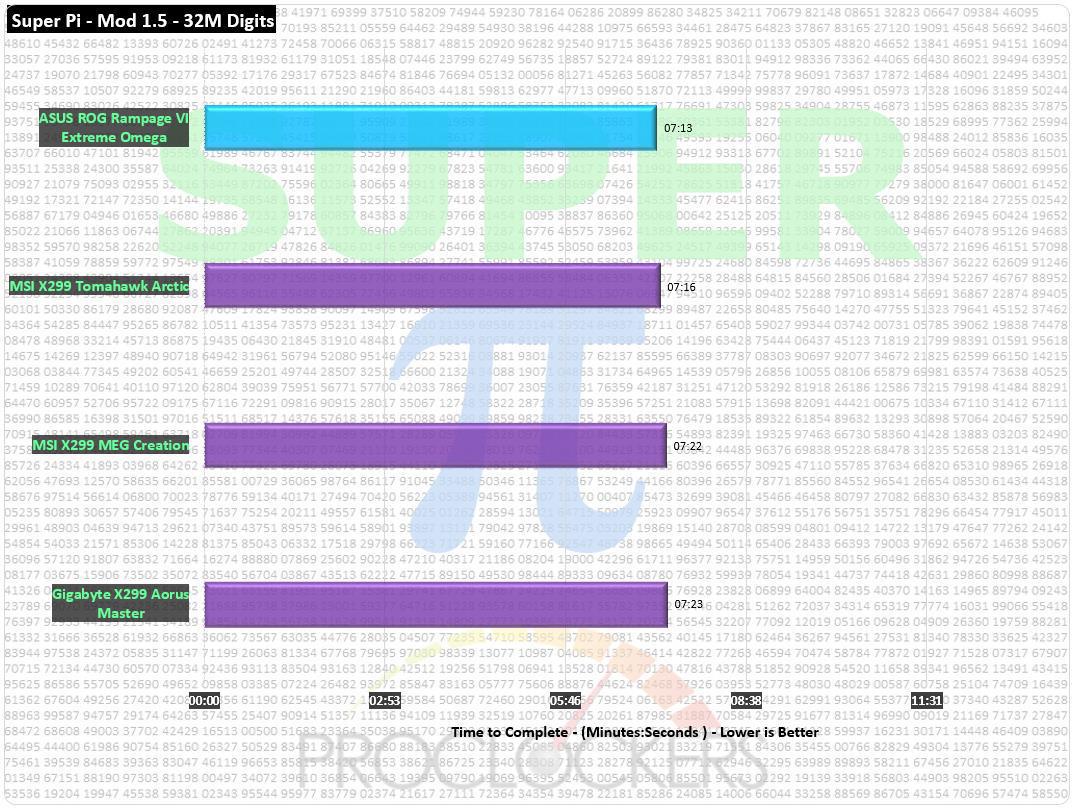
With a single thread in play solving for Pi, the Omega does all 32 million digits in 7 minutes and 13 seconds, quite a bit faster than other similar systems.
CINEBENCH R15
“CINEBENCH is a real-world cross platform test suite that evaluates your computer’s performance capabilities. CINEBENCH is based on MAXON’s award-winning animation software CINEMA 4D, which is used extensively by studios and production houses worldwide for 3D content creation. MAXON software has been used in blockbuster movies such as Iron Man 3, Oblivion, Life of Pi or Prometheus and much more.
CINEBENCH is the perfect tool to compare CPU and graphics performance across various systems and platforms (Windows and OS X). And best of all: It’s completely free.”
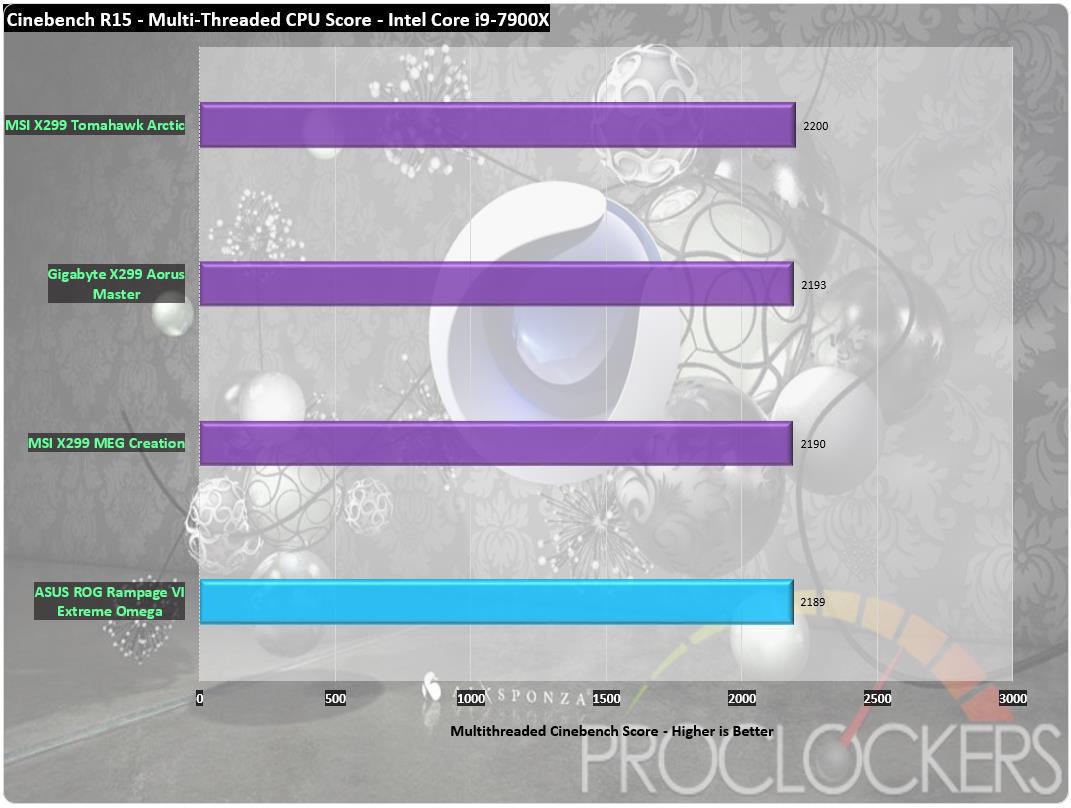
With all cores in play, the Omega scores 2189 points in Cinebench, just 11 points behind the leader.
7-Zip
The benchmark shows a rating of MIPS (million instructions per second). The rating value is calculated from the measured speed, and it is normalized with results of Intel Core 2 CPU with multi-threading option switched off. So if you have modern CPU from Intel or AMD, rating values in single-thread mode must be close to real CPU frequency. There are two tests, compression with LZMA method and decompression with LZMA method. Once the total passes reach 20 or more, the score is taken.
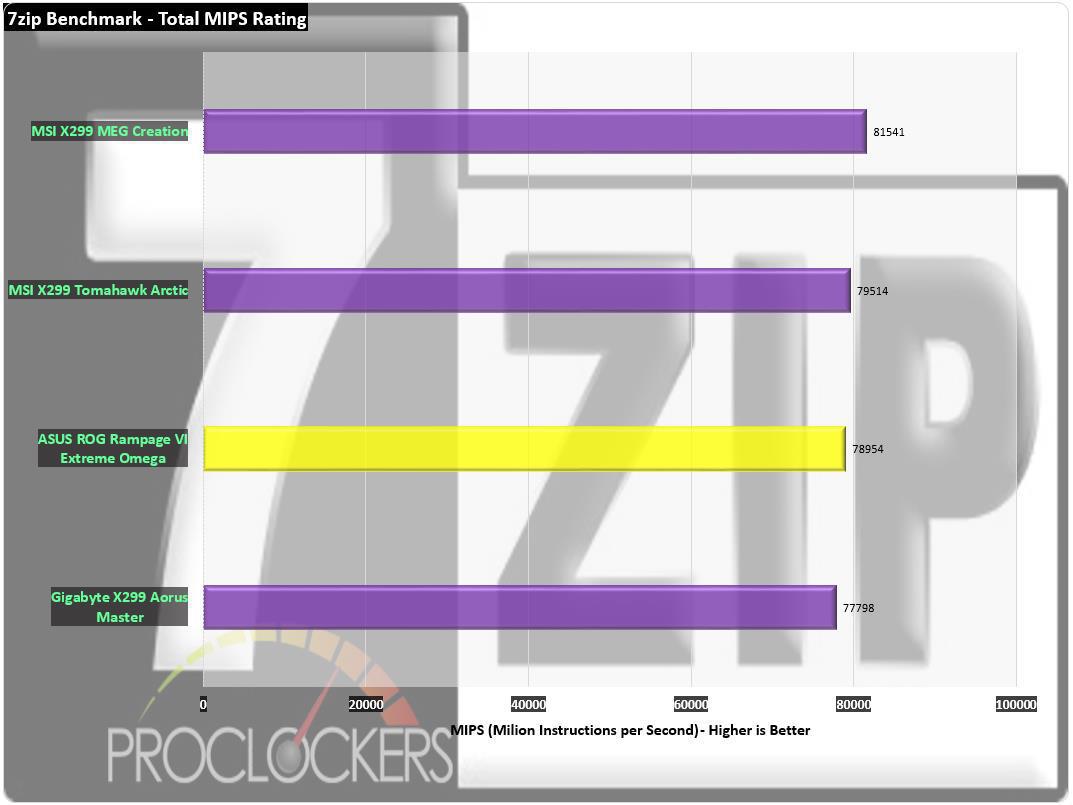
7-Zip performs with an overall average of 78,954 MIPS.
Memory Performance Testing
AIDA64 Engineer Edition
“FinalWire Ltd. today announced the immediate availability of AIDA64 Extreme Edition 1.50 software, a streamlined diagnostic and benchmarking tool for home users; and the immediate availability of AIDA64 Business Edition 1.50 software, an essential network management solution for small and medium scale enterprises. The new AIDA64 update implements AVX-optimized benchmarks for the upcoming Intel Sandy Bridge processors, adds a brand-new video encoding benchmark, and supports the latest AMD and NVIDIA graphics processors.”
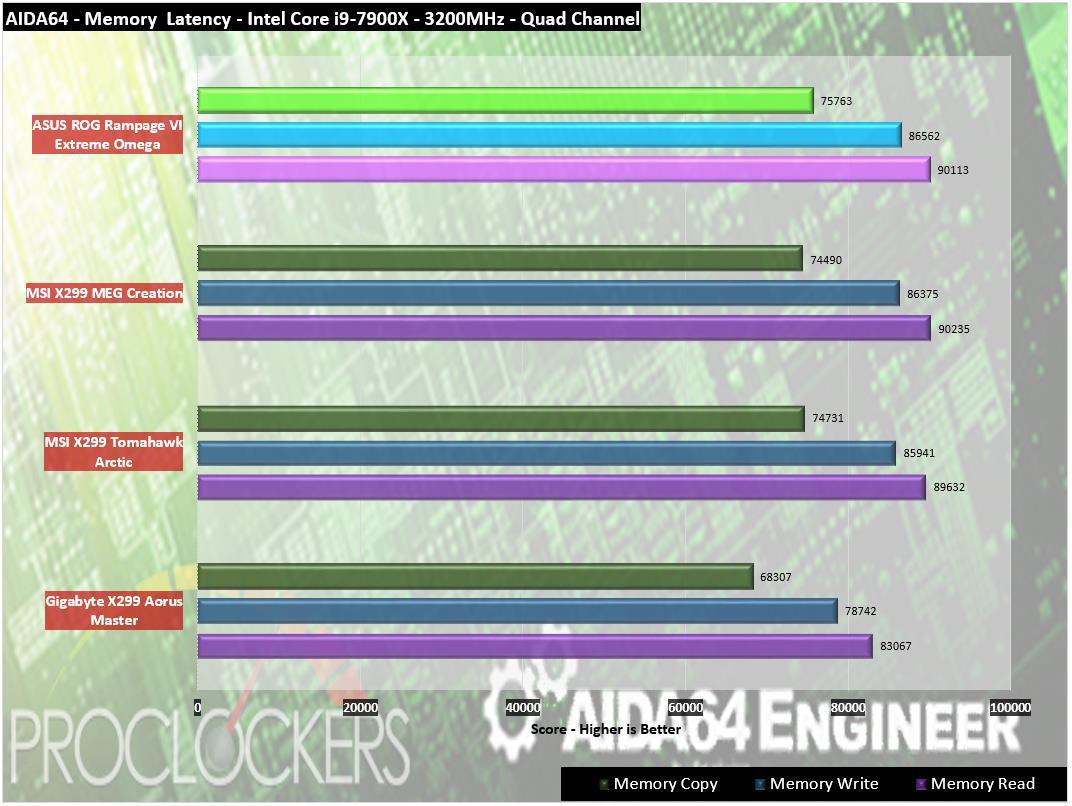
Memory bandwidth comes in at over 90GB reads, 86GB writes and 75GB for copy functions.
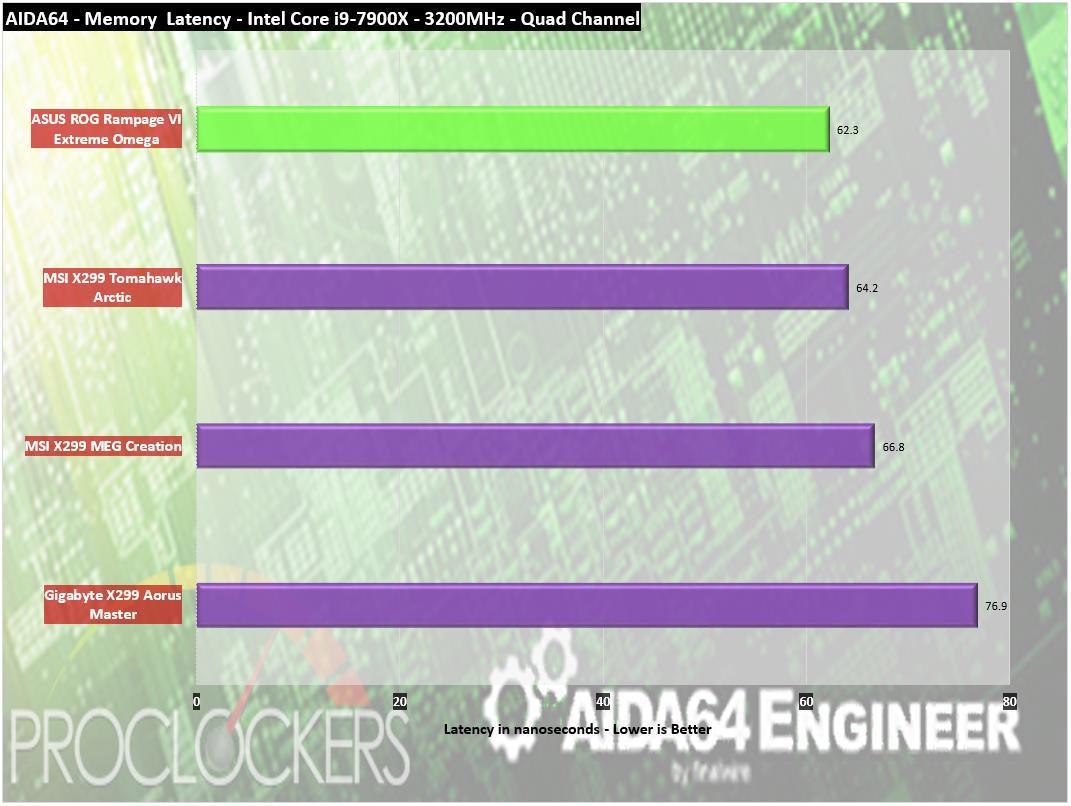
Latency comes in at a class-leading 62.3ns.
Passmark Performance Test – Memory Mark – Threaded
“Fast, easy to use, PC speed testing and benchmarking. PassMark Performance Test ™ allows you to objectively benchmark a PC using a variety of different speed tests and compare the results to other computers.”
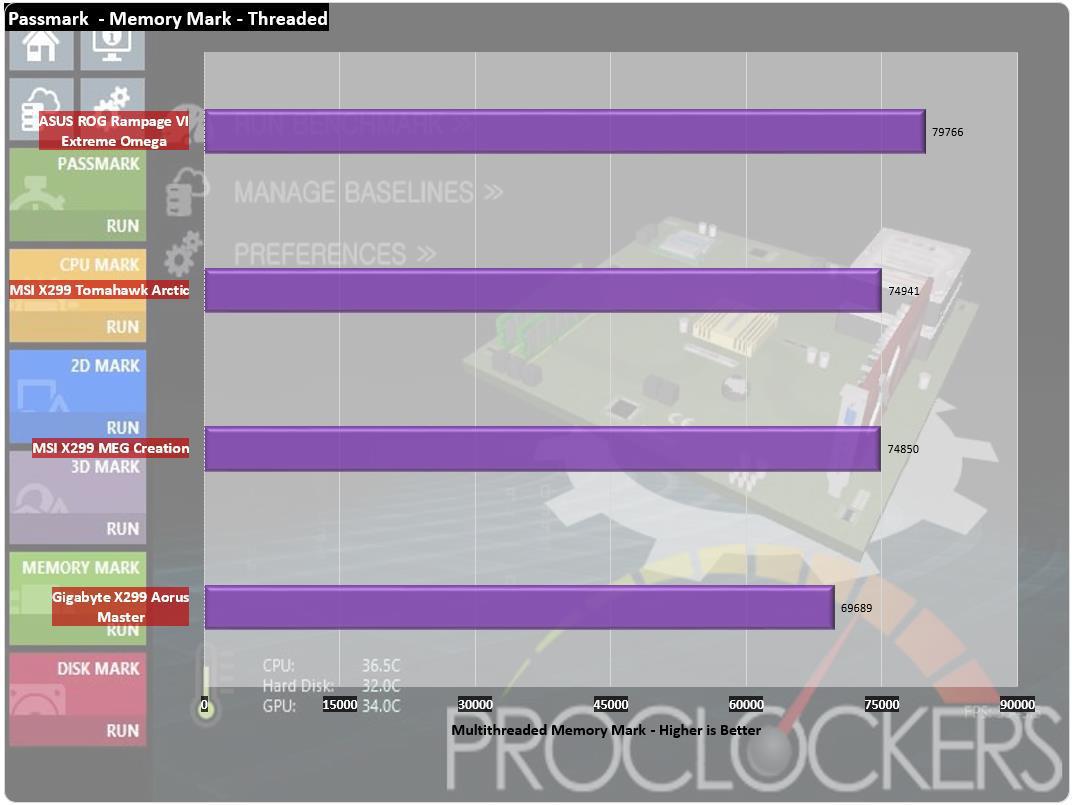
Passmark’s Threaded memory mark gives the Omega a score of just under 80k, easily first place between similar systems.
SiSoft Sandra
“SiSoftware Sandra provides a robust package of diagnostic tools for testing your system and teasing out its problems–or potential headaches.”
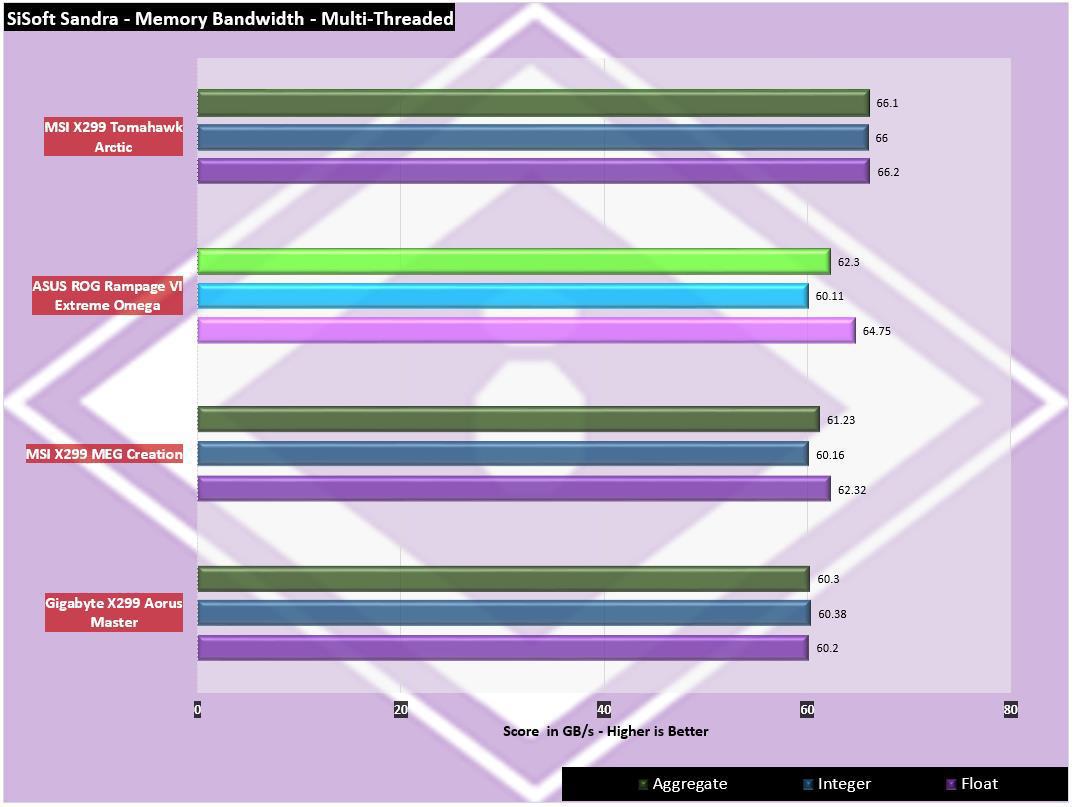
SiSoft comes in at nearly 65GB/s float, over 60GB on Integer and over 62.3GB/s on aggregate.
Storage Testing
ATTO Disk Benchmark
“As the industry’s leading provider of high-performance storage & network connectivity products, ATTO has created a widely-accepted Disk Benchmark freeware utility to help measure storage system performance. As one of the top tools utilized in the industry, Disk Benchmark identifies performance in hard drives, solid state drives, RAID arrays as well as connections to storage. Top drive manufacturers, like Hitachi, build and test every drive using the ATTO Disk Benchmark”
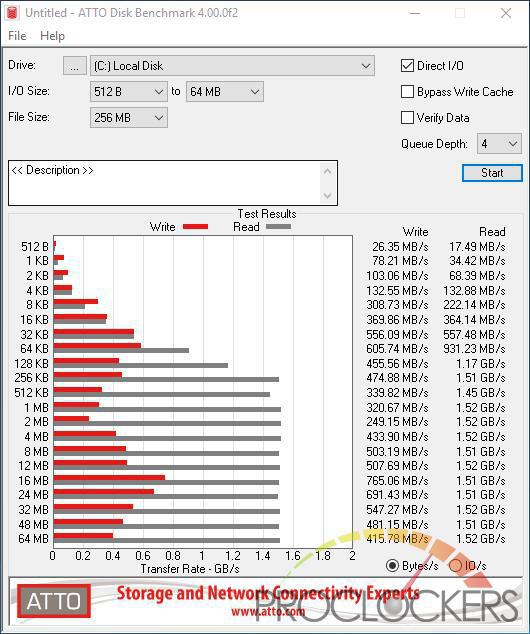
Atto shows our Toshiba RC400 480GB M.2 drive hitting its read speeds easily but writes come in a little slow thanks to a very full drive.
CrystalDiskMark 6.0
“CrystalDiskMark is designed to quickly test the performance of your hard drives. Currently, the program allows measuring sequential and random read/write speeds.”
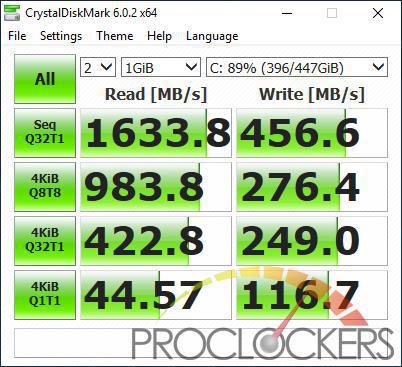
CrystalDiskMark actually comes in a little above rated read speeds, but our full drive is really taking a hit through no fault of ASUS’s.
AS SSD
The AS SSD benchmark determines the performance of Solid State Drives (SSD). The tool contains six synthetic and three copy tests.
The synthetic tests determine the sequential and random read and write performance of the SSD. These tests are performed without using the operating system cache. In the sequential test, the program measures how long it takes to read and write a 1 GB file. In the 4K test, read and write performance is determined for randomly selected 4K blocks. The 4K-64 Third test is equivalent to the 4K procedure, except that the read and write operations are distributed to 64 threads. This test should show differences between the IDE operating mode where NCQ is not supported and the AHCI mode for SSDs with Native Command Queuing (NCQ). The additional compression test can measure the performance of the SSD as a function of the compressibility of the data. This is especially important for the controllers that are used to increase the performance and life of the cell compression.
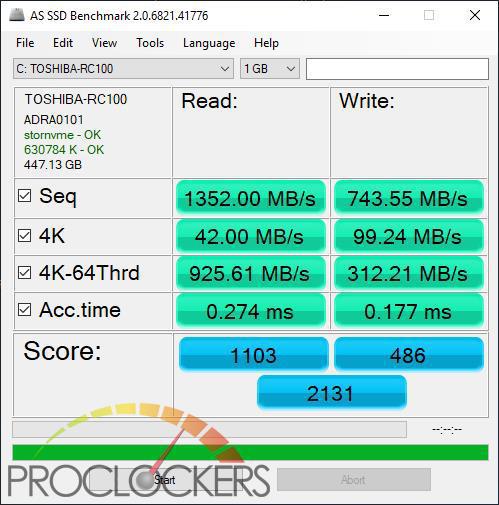
AS SSD gives us a score of 2131, about what we expected.
Game Testing
3DMark – Fire Strike
“Fire Strike is a showcase DirectX 11 benchmark designed for today’s high-performance gaming PCs. It is our most ambitious and technical benchmark ever, featuring real-time graphics rendered with detail and complexity far beyond what is found in other benchmarks and games today”
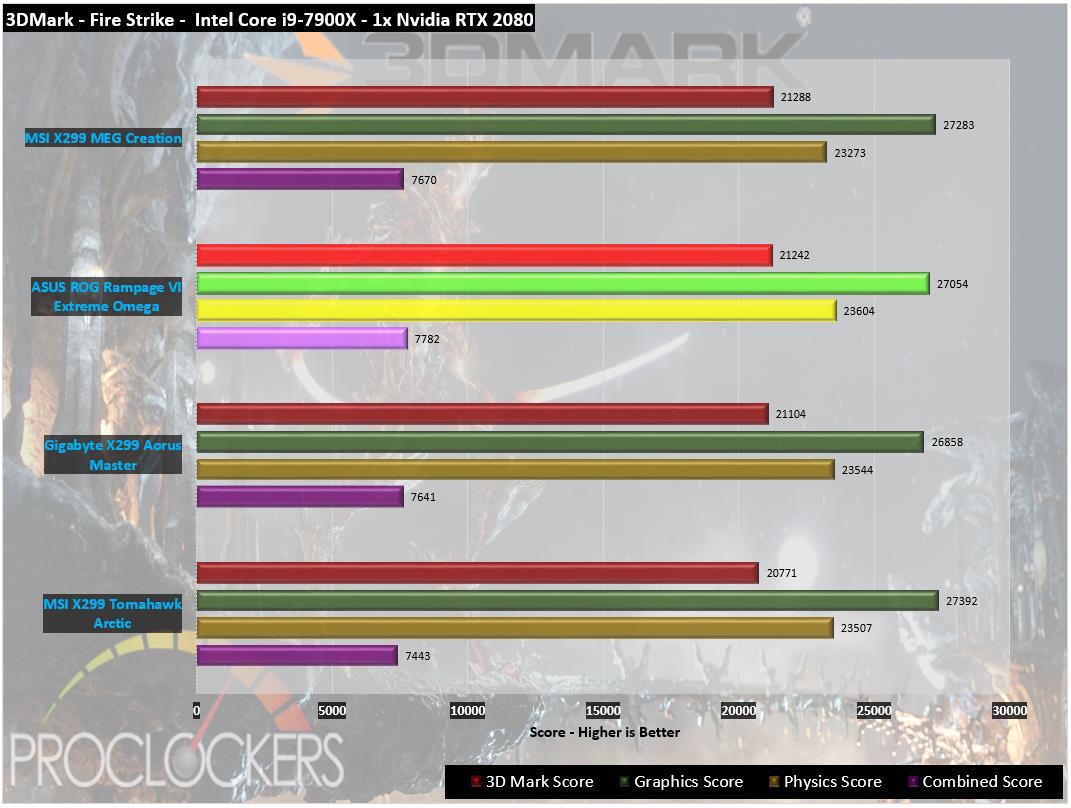
ASUS usually does well in the gaming category with its ‘Republic of Gamers’ platforms, the Omega is no different and does well in Firestrike.
3DMark – Time Spy
“3Dmark Time Spy is a new DirectX 12 benchmark test for Windows 10 gaming PCs. Time Spay is one of the first DirectX 12 apps to be built “the right way” from the ground up to fully realize the performance gains that the new API offers. With DirectX 12 engine, which supports new API features like asynchronous compute, explicit multi-adapter, and multi-threading, Time Spy is the ideal test for benchmarking the latest graphics cards.”
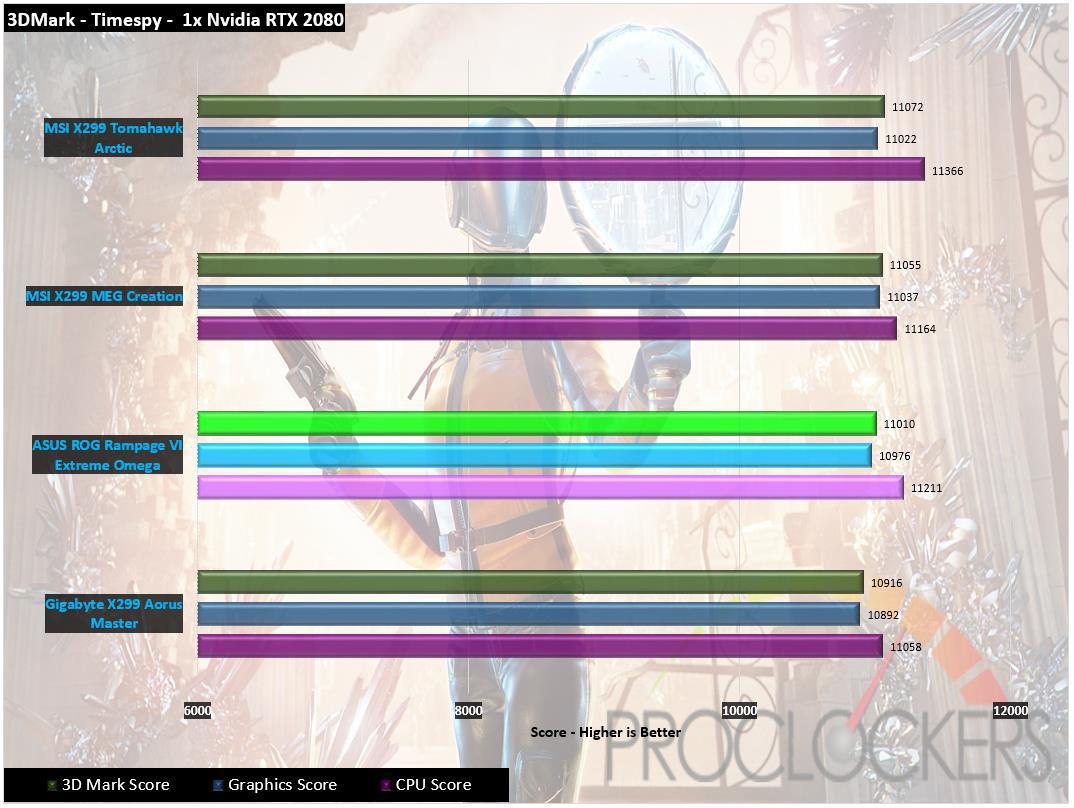
Timespy comes in third, just narrowly missing a 1st place win.
Far Cry 5
Anything can happen. Everything will.
Welcome to Hope County, Montana, land of the free and the brave, but also home to a fanatical doomsday cult—known as The Project at Eden’s Gate—that is threatening the community’s freedom. Stand up to the cult’s leaders, Joseph Seed, and the Heralds, as you spark the fires of resistance that will liberate the besieged community.

Our first real game test does admirably with Far Cry 5 hitting 115FPS average at 1080P.
Middle-Earth: Shadow of War
In the epic sequel to the award-winning Middle-earth: Shadow of Mordor, go behind enemy lines to forge an army, conquer Fortresses and dominate Mordor from within. Experience how the award-winning Nemesis System creates unique personal stories with every enemy and follower, and confront the full power of the Dark Lord Sauron and his Ringwraiths in this epic new story of Middle-earth.
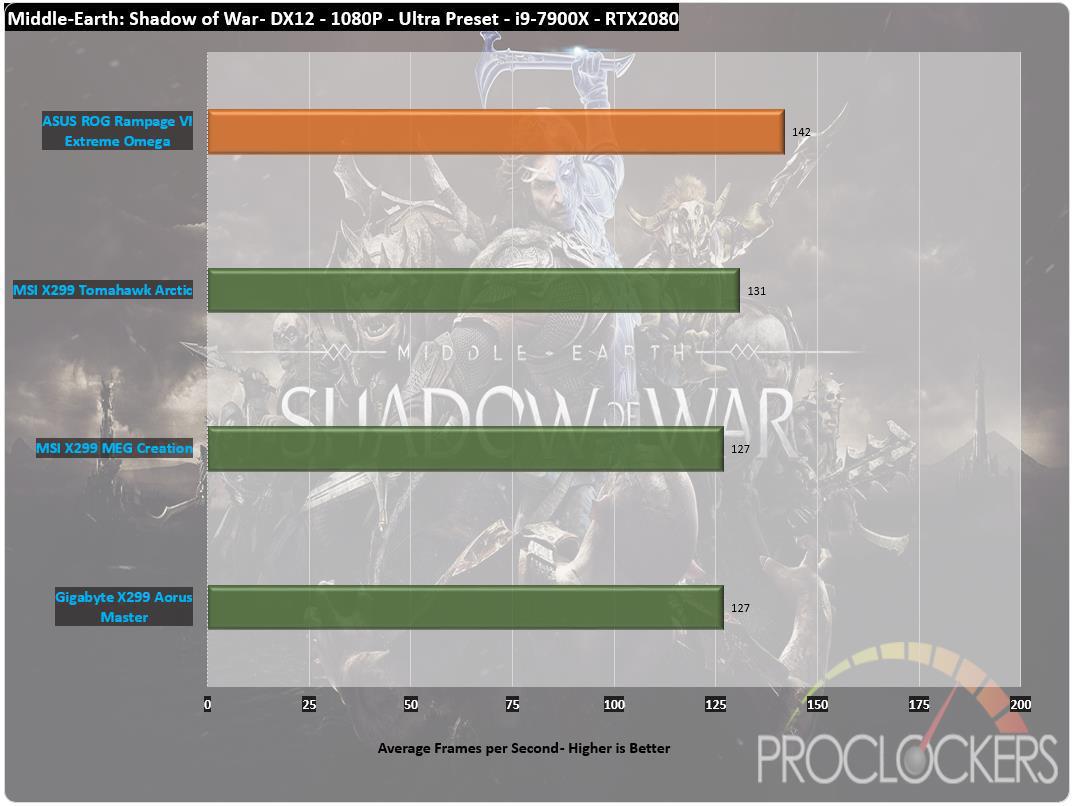
Middle Earth: Shadow of War also does exceptionally well.
Shadow of the Tomb Raider
Experience Lara Croft’s defining moment as she becomes the Tomb Raider. In Shadow of the Tomb Raider, Lara must master a deadly jungle, overcome terrifying tombs, and persevere through her darkest hour. As she races to save the world from a Maya apocalypse, Lara will ultimately be forged into the Tomb Raider she is destined to be.
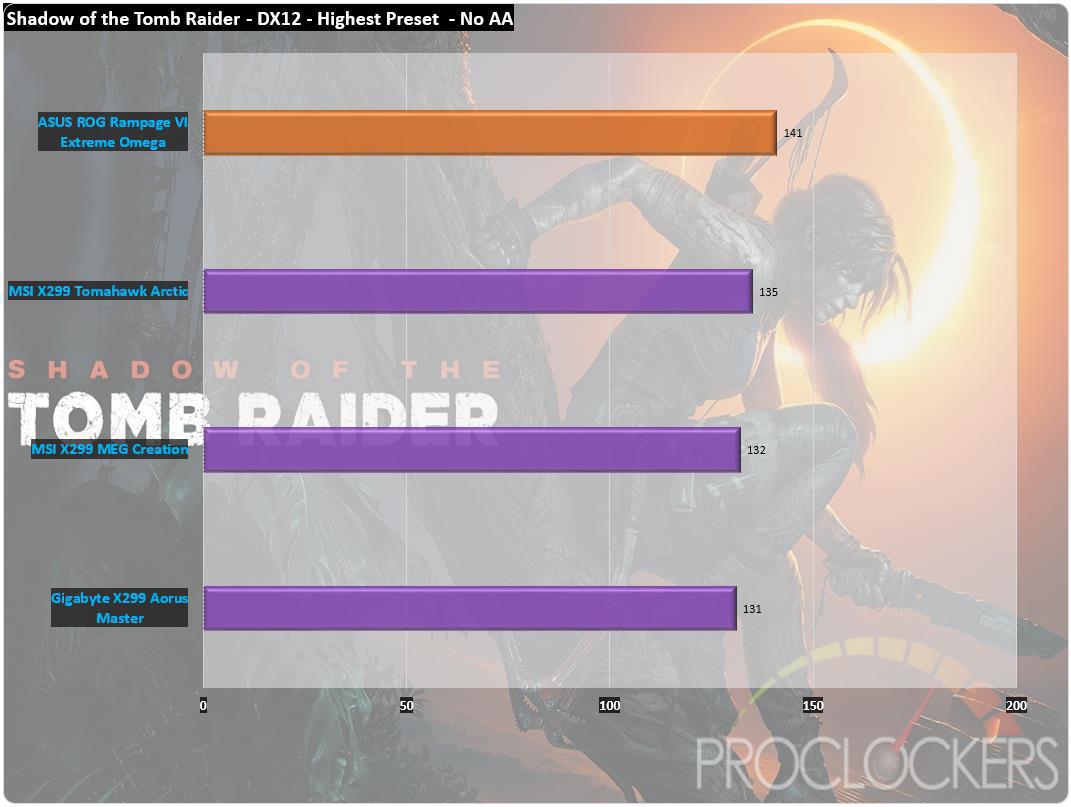
Shadow of the Tomb Raider also comes in 1st place quite easily with an average GPU score of 141 FPS.
Rise of the Tomb Raider
Rise of the Tomb Raider is an action-adventure video game developed by Crystal Dynamics and published by Square Enix. It is the sequel to the 2013 video game Tomb Raider, a reboot of the Tomb Raider franchise. It was released on Xbox One and Xbox 360 in November 2015 and for Microsoft Windows in January 2016. It is set to release for PlayStation 4 in the second half of 2016.
Rise of the Tomb Raider was officially announced in June 2014. The game’s storyline follows Lara Croft as she ventures into Siberia in search of the legendary city of Kitezh, whilst battling a paramilitary organization that intends on beating her to the city’s promise of immortality. Presented from a third-person perspective, the game primarily focuses on survival and combat, while the player may also explore its landscape and various optional tombs. Camilla Luddington returns to voice and performs her role as Lara.
Upon release, Rise of the Tomb Raider received positive reviews, with critics praising its graphics, gameplay, and characterization. It was the best-selling Xbox One game during Christmas week and had sold over one million copies by the end of 2015. Additional content was also released, including a new story campaign, a new gameplay mode, as well as new outfits and weapons for Lara.
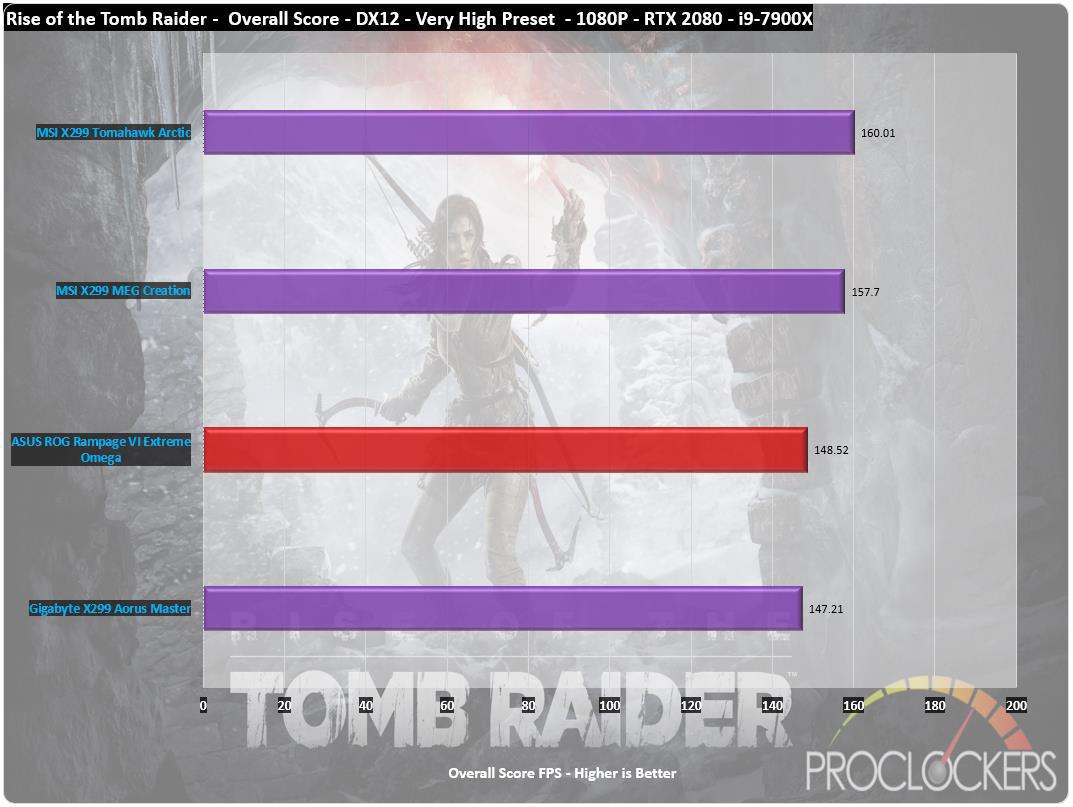
Rise of the Tomb Raider also does well but doesn’t quite manage first place. Still exceptional overall.
Overclocking
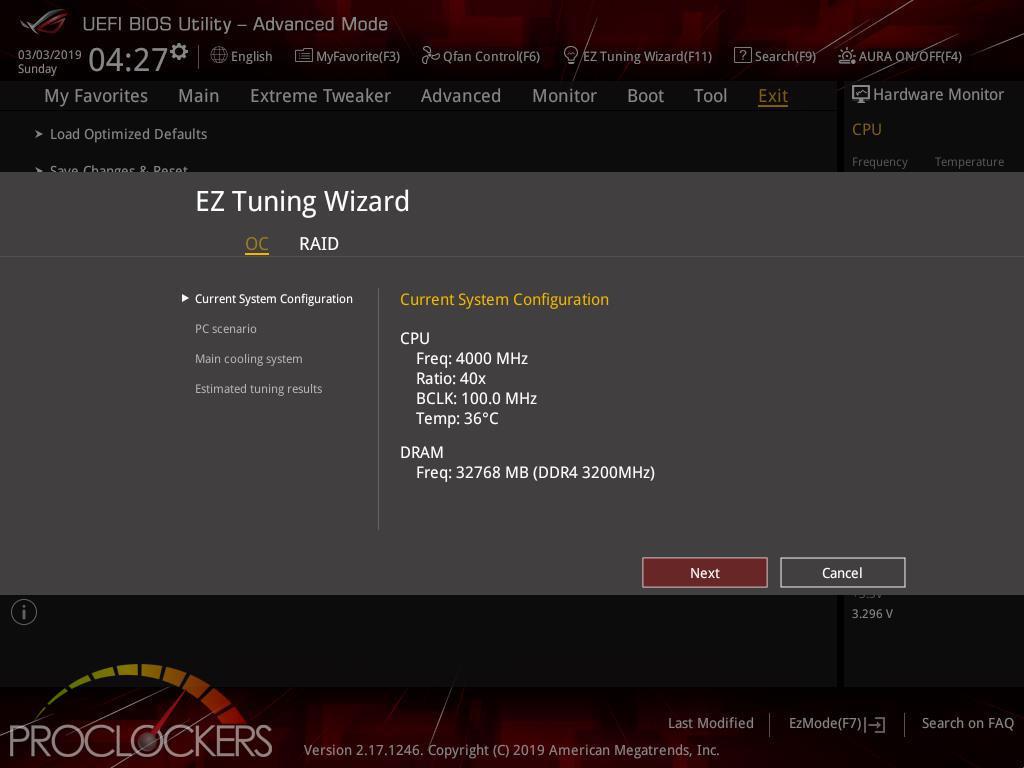
ASUS’s ROG Rampage VI Extreme Omega still uses ASUS’s EZ Tuning Wizzard rather than the new AI system found on the Maximus XI Extreme other recent mainstream platforms. We’ll give it a spin anyway.
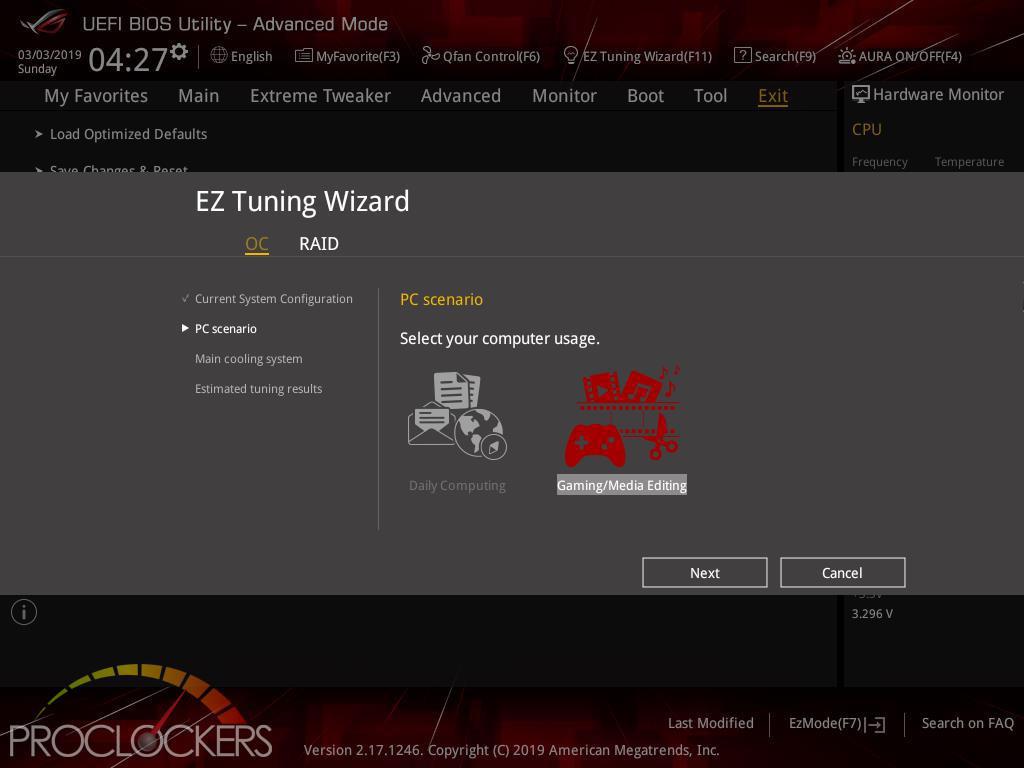
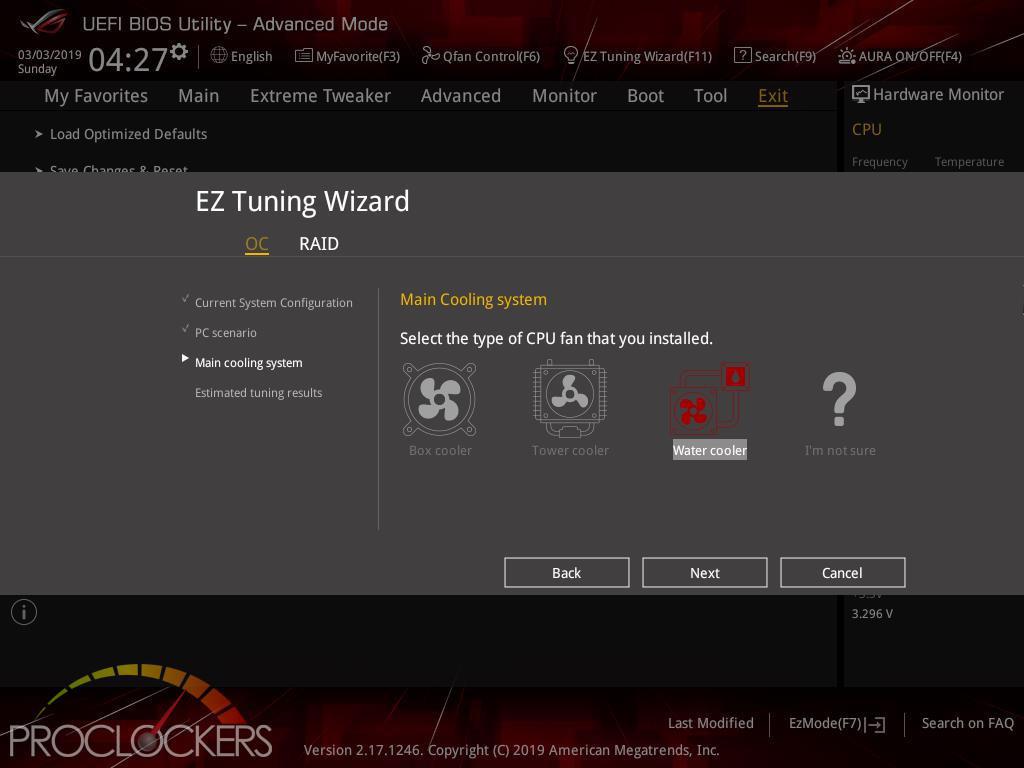
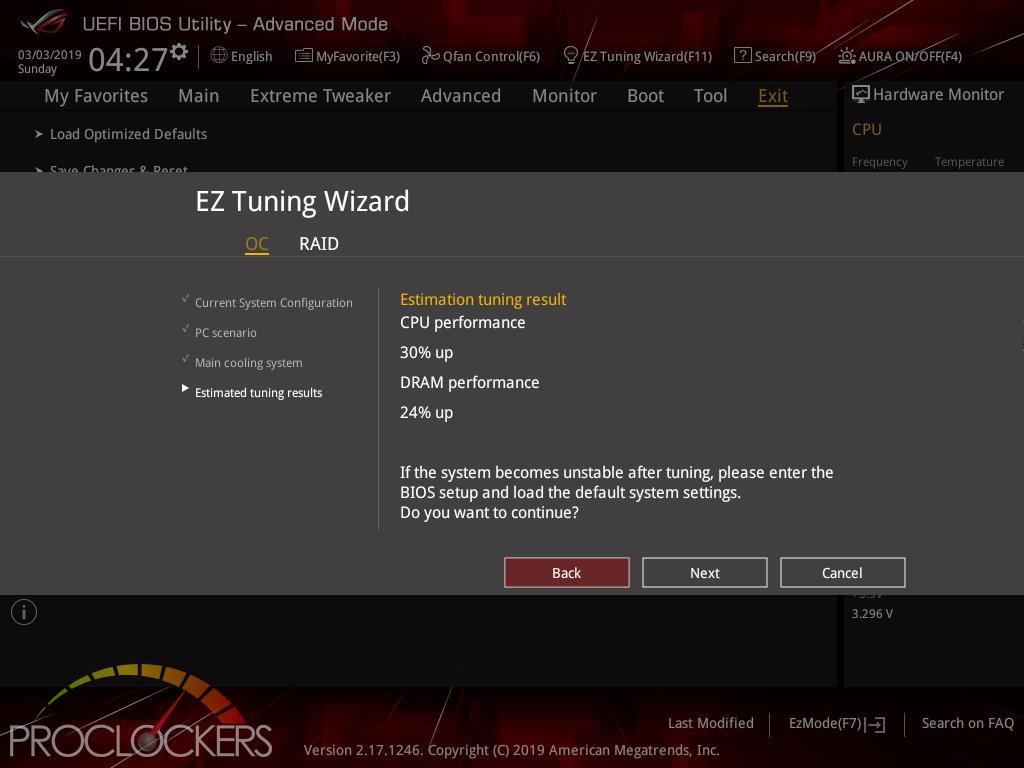
Just answer a few questions about your system configuration and you get an estimated result.
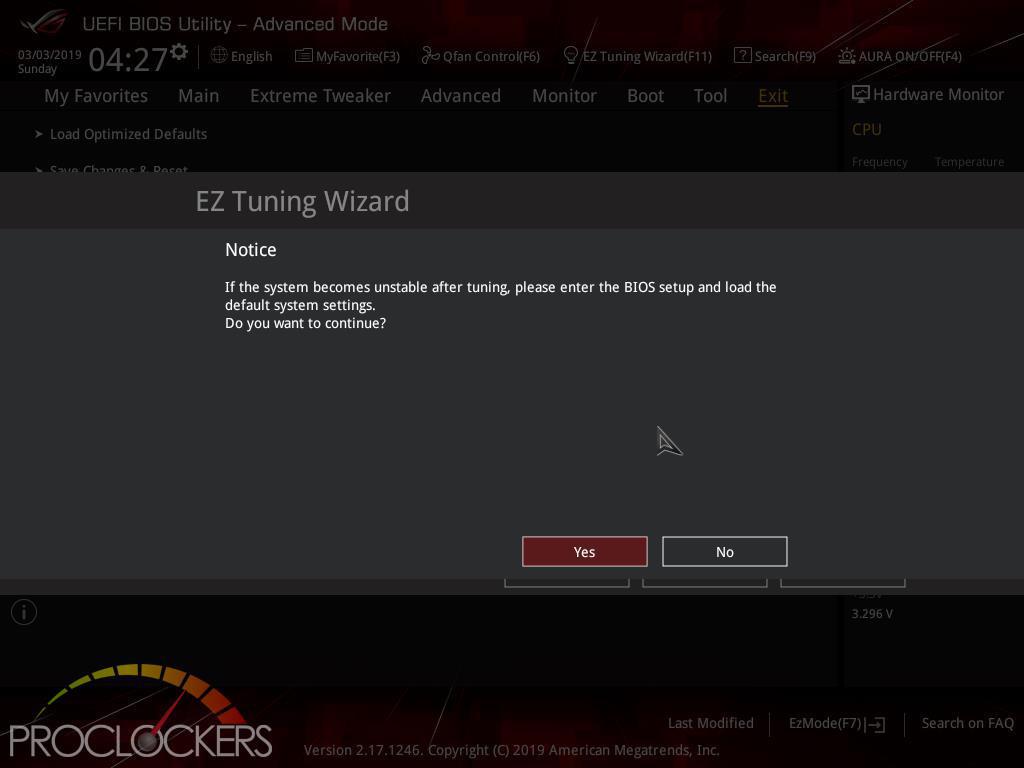
If you are happy with it, click next, and Yes here.
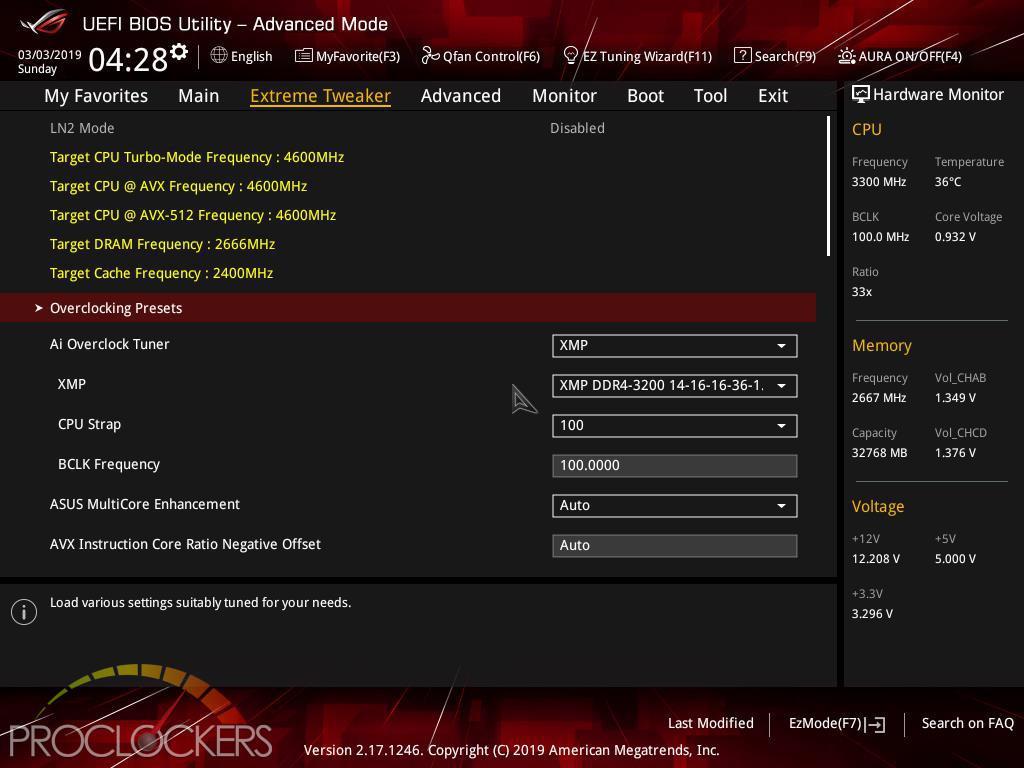
A reboot later, we see it has pushed us up to 4.6GHz with no AVX offsets.

It gives us 4.6 GHz on two cores with everything else at 4.3 GHz.
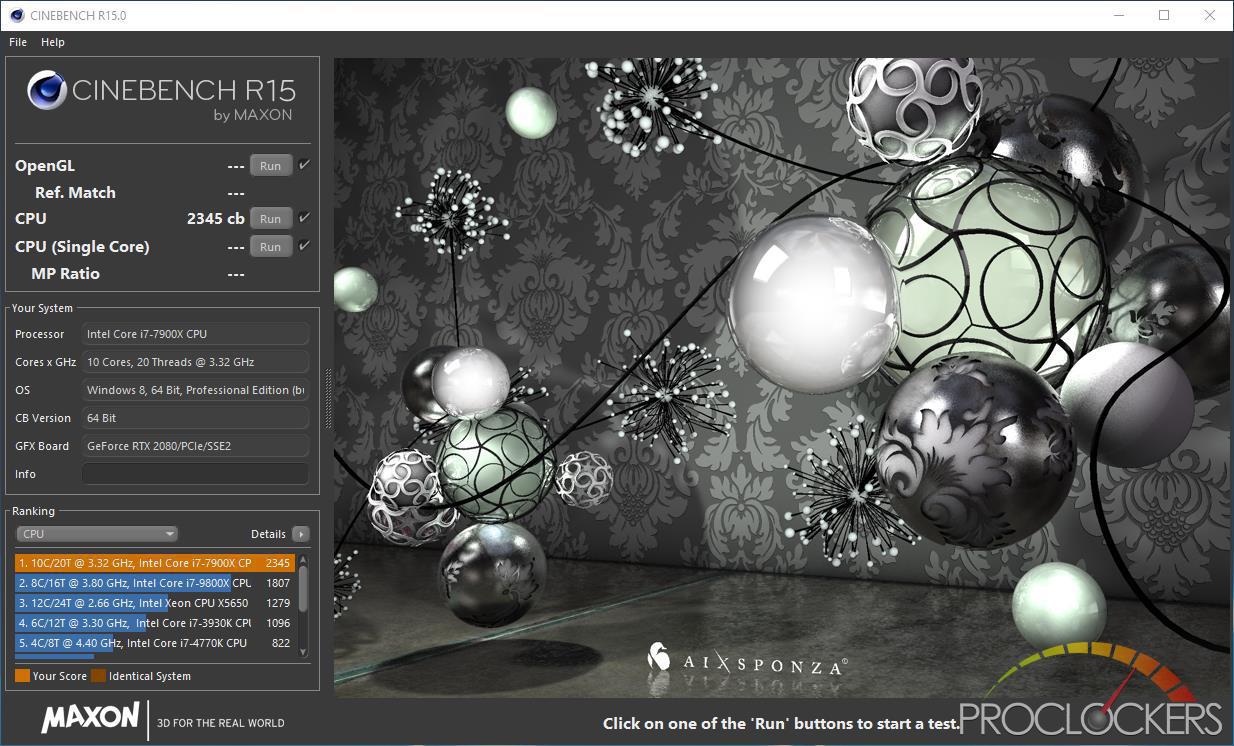
This gives us about 150 more points in Cinebench over stock settings.
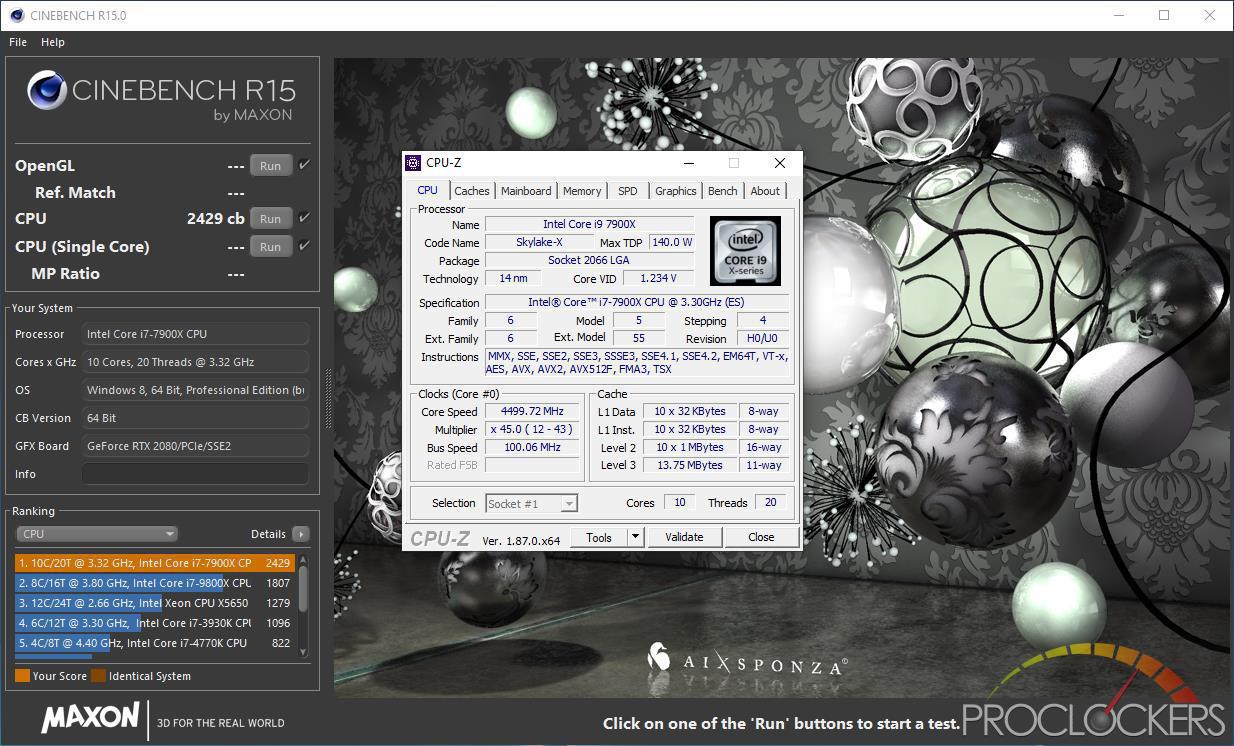
Manually setting everything to 4.5GHz gets us up to 2429 points. We continue on to 4.8 GHz pretty easily but start getting temps over 105C+ on the cores so we go after memory next.
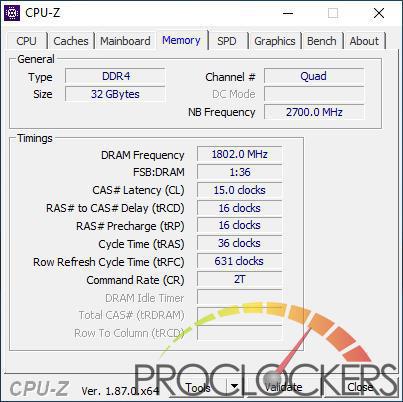
We get up to 3600MHz by relaxing CAS to 15.
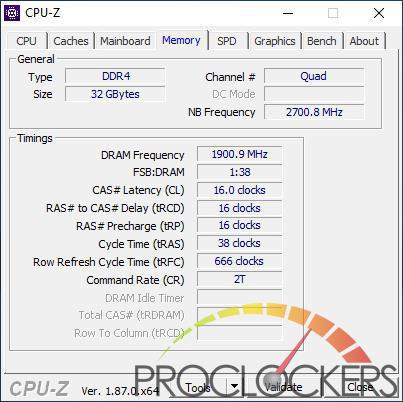
And then 3800 C16.
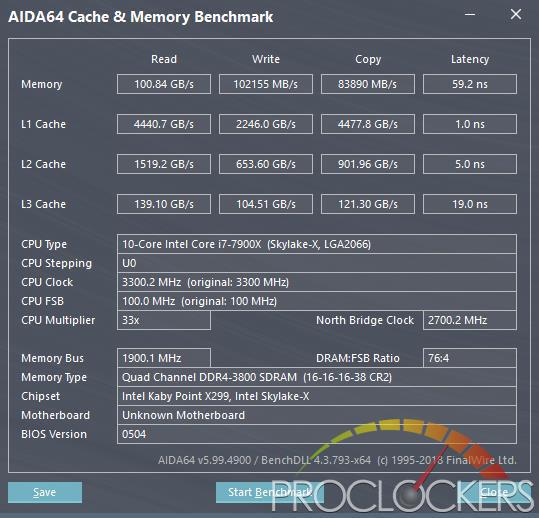
This puts us over 100GB/s
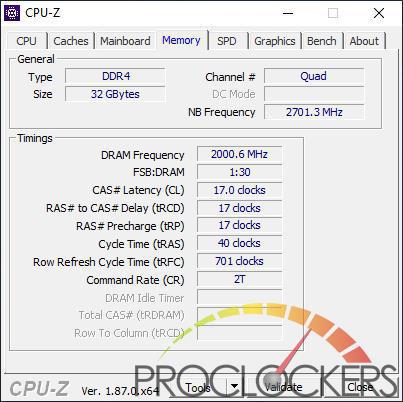
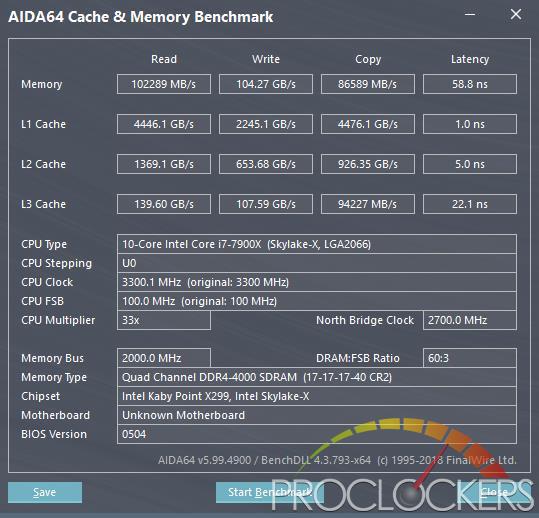
and then 4000MHz…
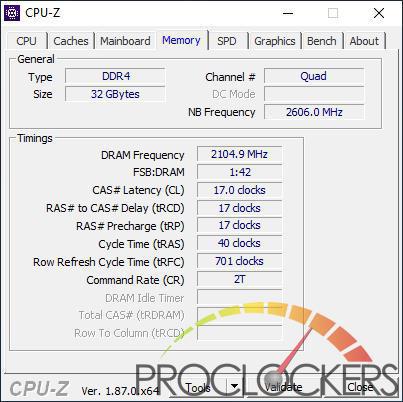
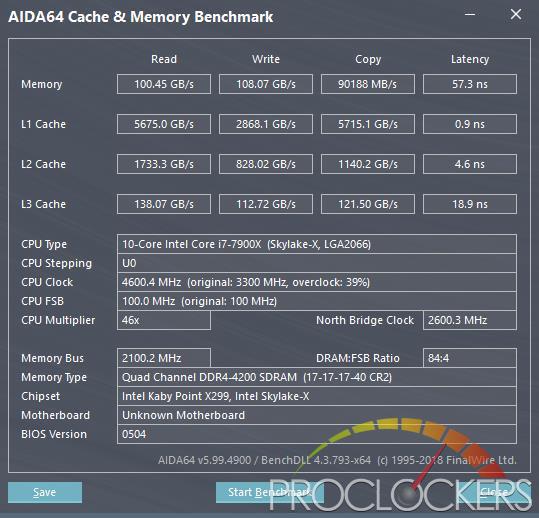
… and even 4200MHz, and yes, this is on a 3200 MHz kit of memory.
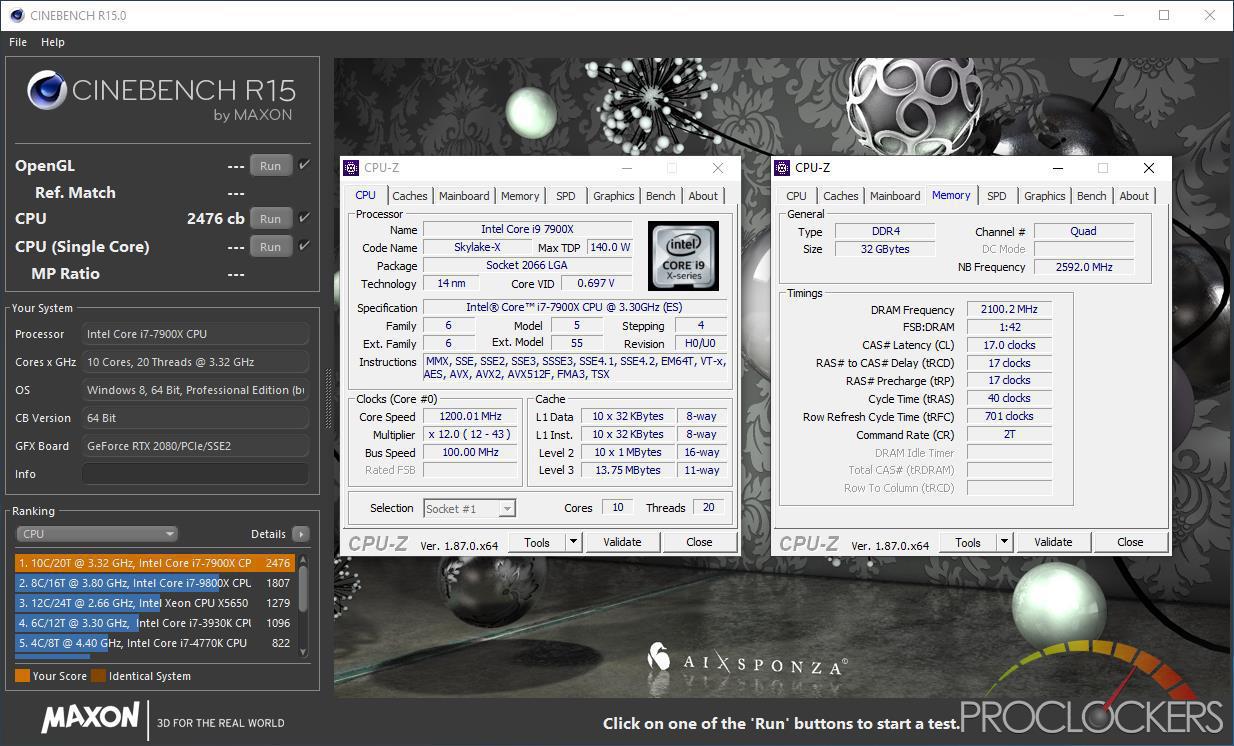
When coupled with a 4.6GHz overclock, our Cinebench score climbs again. It’s pretty apparent that ASUS is not holding us back in the least, we are just bumping the limits over standard water cooling on a high core count Chip and a memory kit already being pushed a full 1000 MHz over stock. With better memory and cooling, the sky is the limit here!
Final Thoughts & Conclusion
ASUS has once again provided a no-holds-barred powerhouse for Intel’s latest High-End Desktop CPU’s and can easily handle even the biggest Core i9-9980XE 18-core CPU maxed out while overclocked. We never did see the VRM fans kick on, and it stayed cool, barely above room temperature while overclocking the still demanding 10-core Core i9-7900X. Memory overclocking was almost non-stop, even in Quad-channel mode, we were able to pull the fastest speed out of this kit of memory we’ve ever gotten, a full GHz over the XMP rating of 3200MHz. ASUS’s claims support for 4266+MHz and we won’t challenge that claim at all, we pretty much got there with a much lower rated kit without really trying hard, and we only added 0.03V to the memory to do so.
Out of the box, performance was great, and it held first place in all but one gaming test and placed well in every other test. We wish Intel’s VROC was a little more mature, having 3x M.2 slots available connected to the CPU provides the opportunity for staggering storage performance. Having the latest high-speed networking on-board is just the cherry on top when you need to get things done. The new Fan Extension II card is really nice, as are the piles of extra fan headers and RGB channels it is. Speaking of RGB, we really wish there was at least one more Digital/Addressable RGB header somewhere on the board. You get a total of five normal ones, so one of these being digital would have been nice.
We really like the new aesthetics, but obviously, that is subjective. The aluminum covers and heatsinks, as well as the massive new VRM heatsink really gives this board a premium feel and lets you know it means business. With a price tag of about $750 on the street, it’s certainly on the expensive end, but when you need no compromises on high-end systems, ASUS has you covered.
Great Job ASUS!

